Introduction
In the rapidly evolving landscape of business operations, invoice automation emerges as a game-changer, revolutionizing how organizations manage their financial processes. By harnessing advanced technologies, companies can streamline invoicing, reduce manual errors, and enhance compliance, all while freeing up valuable employee time. As organizations grapple with the complexities of adopting automation, understanding the key steps, benefits, and integration strategies becomes essential.
With a focus on overcoming common challenges, businesses can unlock the full potential of automated invoicing, positioning themselves for success in an increasingly competitive marketplace. This article delves into the intricacies of invoice automation, offering practical insights to empower organizations in their journey toward operational efficiency.
Understanding Invoice Automation: Definition and Overview
Invoice streamlining signifies a strategic use of technology aimed at simplifying and mechanizing the entire invoice automation process, significantly minimizing manual intervention. This comprehensive invoice automation process encompasses the generation, approval, and payment of invoices, ensuring not just accuracy but also regulatory compliance. By adopting automated processes, organizations can effectively tackle the common challenges of AI adoption, such as perceived complexity and costs, while reaping benefits like reduced human error and accelerated processing times.
In fact, employees estimate that mechanization could save them approximately 240 hours per year, marking a substantial productivity gain. With over 80% of companies intending to maintain or increase their investment in automated solutions, the invoice automation process represents more than just a technological upgrade; it signifies a critical shift towards more efficient business practices that align with contemporary operational objectives. However, organizations must also address issues related to Poor Master Data Quality, which can hinder the effectiveness of AI initiatives.
For instance, accurate and high-quality data is essential for successful processes, as poor data quality can lead to errors and inefficiencies. As noted by Kateryna Cherniak, an SEO Specialist, digital assistants handle 58% of returns and cancellations, demonstrating the concrete advantages of automated processes. Moreover, the implementation of AI in operational strategies can enhance resilience, as demonstrated by research advocating for multi-agent systems that support SMEs in making informed strategic decisions.
Significantly, forecasts suggest that AI bots will facilitate 95% of all customer service interactions by 2025, while 57% of enterprises intend to embrace automated techniques in the next two years. This trend highlights the urgency for entities to shift towards mechanization, as by 2024, 69% of daily management tasks are anticipated to be mechanized. The market for workflow streamlining procedures is anticipated to grow to $26 billion by 2025, emphasizing the economic significance of investing in solutions to position organizations for success in an evolving marketplace.
Additionally, case studies showcasing successful applications of billing systems can offer tangible examples of the advantages achieved, such as enhanced precision and effectiveness in financial operations.
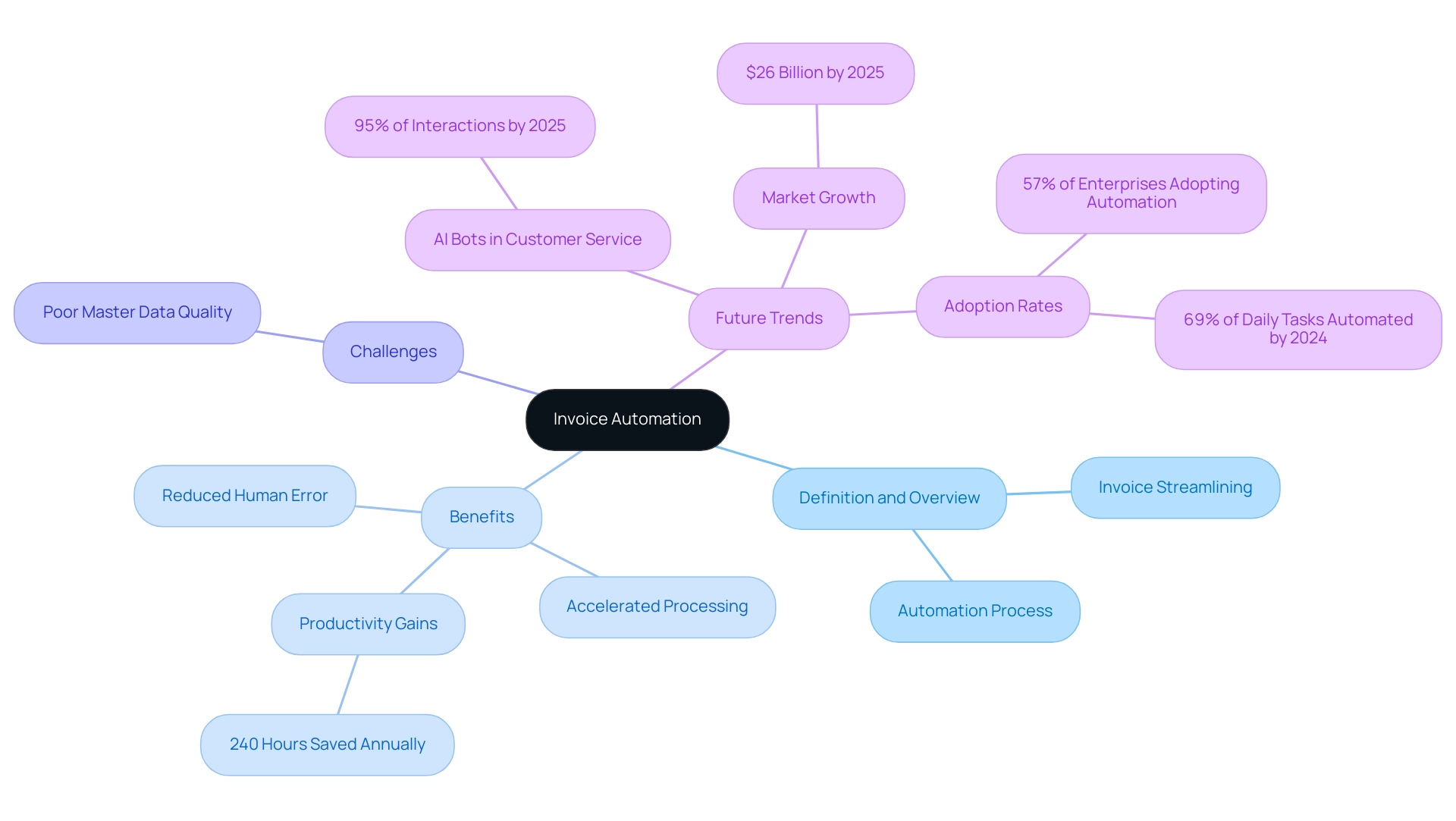
Key Steps in the Invoice Automation Process
The invoice automation process is a crucial element of the billing process, enhancing operational efficiency by encompassing several essential steps that improve accuracy and streamline workflows. Firstly, Data Capture utilizes Optical Character Recognition (OCR) technology to extract relevant information from incoming invoices, significantly reducing manual entry errors and improving visibility into invoice statuses. With 15% of AP automation tools now featuring AI-powered workflows, as noted by Gartner, the growing relevance of AI is paramount in enhancing data capture capabilities.
EMMA RPA enhances this step by providing advanced data extraction features that integrate seamlessly with existing systems, ensuring higher accuracy and efficiency. Secondly, Validation comes into play, where the system automatically verifies captured data against purchase orders or contracts, ensuring accuracy and compliance. This step is crucial, as 27% of organizations acknowledge enhanced fraud reduction as a direct advantage of automation, emphasizing validation’s role in protecting financial operations.
Power Automate can be utilized here to set up automated alerts for discrepancies, further enhancing security. After validation, the Approval Workflow entails directing bills through established procedures, ensuring that relevant stakeholders examine and sanction payments promptly, which not only speeds up approvals but also improves financial reporting precision. EMMA RPA facilitates this by automating the routing process based on predefined rules, ensuring no billing document is overlooked.
The fourth step, Payment Processing, automates payment execution via integrated financial systems, leading to faster transaction turnaround. Finally, Reporting and Analytics produce valuable insights from billing data, informing strategic financial decision-making. Each of these steps is vital for establishing a seamless billing experience, aligning with current trends in mobile billing that emphasize flexibility and security in managing transactions through mobile applications.
A case study on mobile invoicing trends illustrates how this approach is gaining traction, allowing users to create and manage invoices through mobile apps, driven by the need for improved security and flexibility. By implementing the invoice automation process and other automated systems, companies can significantly boost their operational efficiency, alleviate staffing shortages, and minimize errors, ultimately enhancing employee morale and productivity. However, organizations may face challenges during implementation, such as resistance to change or integration issues with legacy systems.
To overcome these hurdles, it is essential to engage stakeholders early in the initiative, provide adequate training, and ensure that the RPA solutions are compatible with existing workflows. By tackling these challenges in advance, companies can enhance the advantages of RPA in their billing automation systems.
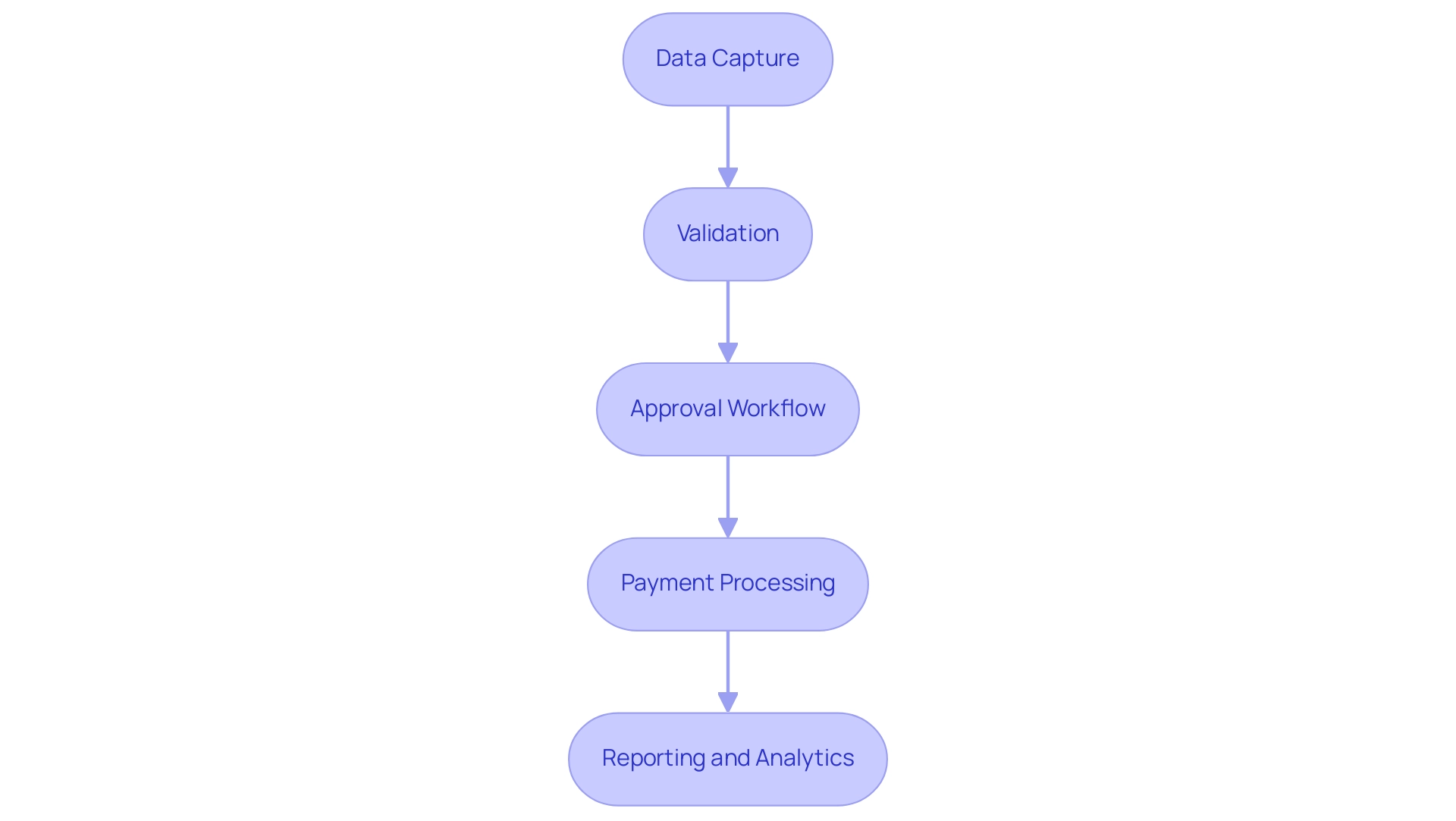
Benefits of Automating Your Invoicing Process
The invoice automation process offers a range of compelling advantages that can transform operational efficiency.
-
Increased Efficiency: Automation significantly accelerates billing processing times, enabling faster payment cycles. Recent reports indicate that 90% of invoices not attached to a purchase order are processed manually, creating a substantial opportunity for RPA to streamline these tasks.
-
Reduced Errors: By minimizing reliance on manual data entry, organizations can drastically lower the chances of errors that often lead to payment disputes. This reduction not only saves time but also enhances relationships with vendors and clients.
-
Enhanced Cash Flow Management: Timely invoicing and efficient payment processing directly contribute to improved cash flow, empowering businesses to manage their finances more effectively. In fact, 83% of employees using AI-powered technology report that it helps reduce burnout and enhances job satisfaction, illustrating the broader impact of such systems on workplace morale.
-
Cost Savings: The time saved on manual tasks translates into significant cost reductions. The 2022 RPA survey conducted by Robocorp revealed that 65% of respondents acknowledged the potential benefits of usage-based pricing, highlighting a trend towards cost-effective solutions. This shift not only reduces operational costs but also aligns with the increasing demand for efficient financial management in healthcare and financial sectors.
-
Improved Compliance: Automated systems facilitate adherence to regulatory requirements by maintaining accurate records and comprehensive audit trails, ensuring businesses remain compliant in a rapidly evolving landscape. Moreover, the case study titled “Employee Productivity and RPA” indicates that 91% of employees state that mechanization saves time and enhances their work-life balance, with 89% feeling more content with their jobs because of mechanization.
-
Utilizing Customized AI Solutions: By incorporating customized AI solutions with RPA, entities can further improve their invoicing systems, ensuring that the automation is not only effective but also aligned with specific business objectives.
-
Overcoming Technology Implementation Challenges: The transition to automated invoicing can often present challenges; however, RPA facilitates smoother implementations by providing scalable solutions that adapt to existing workflows. This adaptability is crucial for maintaining operational continuity during the transition phase.
The integration of RPA and AI not only enhances operational efficiency but also fosters a more productive and satisfied workforce, making the invoice automation process particularly beneficial for healthcare and financial operations.
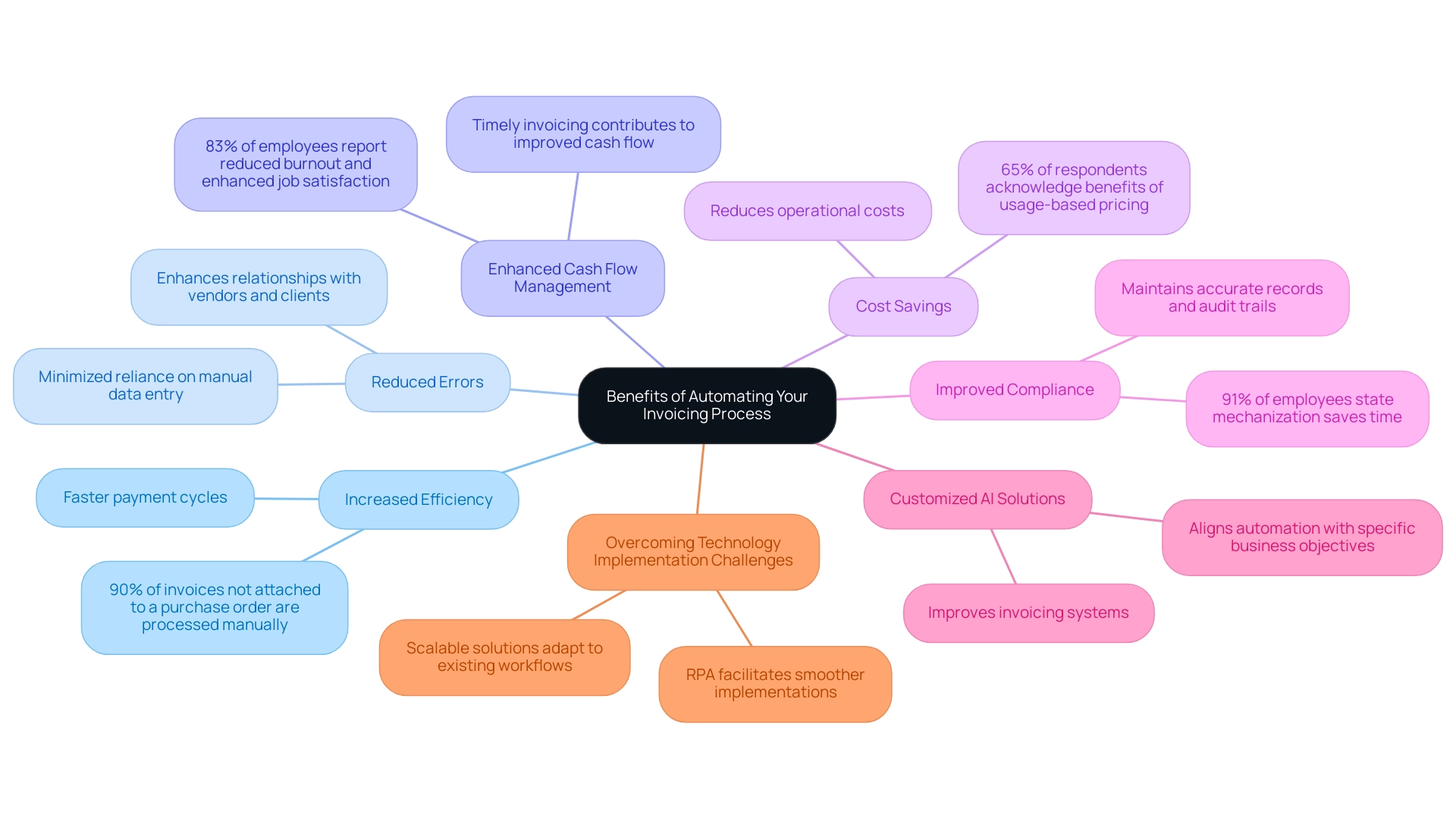
Overcoming Challenges in Invoice Processing with Automation
While the advantages of the invoice automation process are undeniable, businesses frequently encounter several obstacles during the transition. Key challenges include:
-
Resistance to Change: A significant portion of employees may show reluctance to embrace new technologies, often stemming from a lack of understanding or fear of the unknown. In fact, statistics indicate that approximately 60% of employees resist technological changes due to uncertainty about their roles.
-
Integration Challenges: Numerous entities struggle with compatibility issues between current systems and new technological tools, which can obstruct the seamless execution of processes.
-
Data Quality Concerns: Inadequate data quality can severely impact the efficiency and effectiveness of automated processes, leading to errors and inefficiencies.
To mitigate these challenges, organizations should prioritize employee engagement through comprehensive training programs that foster a culture of adaptability.
Patience and assistance for team members and suppliers are vital in attaining higher utilization rates during the shift to mechanization. Furthermore, ensuring rigorous testing of integrations and establishing robust data governance practices will significantly enhance data quality prior to deployment. Our risk-free ROI-driven method ensures that entities only pay for successful implementations.
We start by evaluating a procedure appropriate for mechanization, calculating the effort needed, estimating time savings, and ultimately implementing the system with certified professionals. Significantly, a case study named ‘Time Savings from the invoice automation process’ indicates that the invoice automation process can save organizations over 70% of the time dedicated to accounts payable activities, enabling finance teams to handle up to 30 bills each hour, greatly enhancing productivity. As Mary Schaeffer wisely advises,
Don’t tolerate someone like me that only reads a quarter of the manual that applies to them,
indicating the importance of clear communication and user-friendly transition processes to minimize resistance and maximize compliance.
Furthermore, leveraging Business Intelligence can transform raw data into actionable insights, enabling informed decision-making that drives growth and innovation. Automation can result in significant savings, potentially totaling hundreds, thousands, or even millions, depending on volume and size.
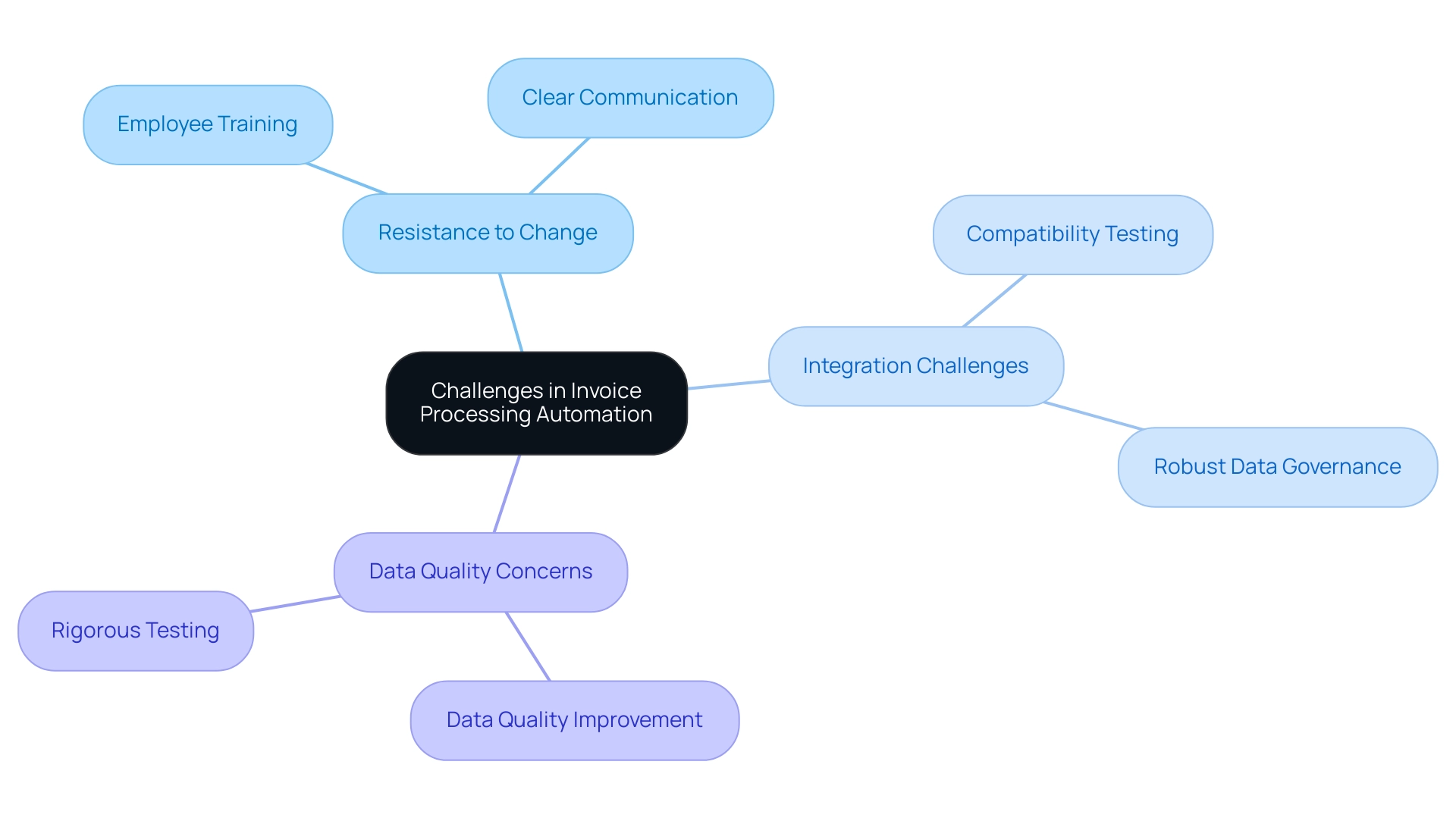
Integrating Invoice Automation with Existing Business Systems
The integration of invoice processing with existing business systems is crucial for unlocking its full potential and driving operational success. Key considerations include:
-
Compatibility: It’s essential to verify that the tools can seamlessly connect with current accounting and ERP systems. Recent statistics reveal that 32% of entities cited security breaches and 25% mentioned integration concerns as primary reasons for avoiding ERP cloud solutions, while 19% cited the risk of data loss.
This emphasizes the need for robust compatibility checks to mitigate these risks. -
Data Flow: Establishing clear data flow protocols is vital for maintaining consistency and accuracy across platforms. Effective data management in the context of the invoice automation process is supported by techniques from time series analysis, such as ARIMA and exponential smoothing, which can help entities forecast and manage data trends efficiently.
-
User Training: Comprehensive training for staff is imperative to familiarize them with the new integrated system. This not only facilitates smoother transitions but also alleviates integration concerns, which 25% of entities reported as a significant barrier. Furthermore, entities often encounter staffing shortages and outdated systems that impede operational efficiency.
By prioritizing these areas and leveraging RPA, organizations can combat repetitive tasks, enhance productivity, and ensure efficient operations while minimizing risks associated with automation and data management. Furthermore, incorporating Business Intelligence can transform raw data into actionable insights, enabling informed decision-making that drives growth and innovation.
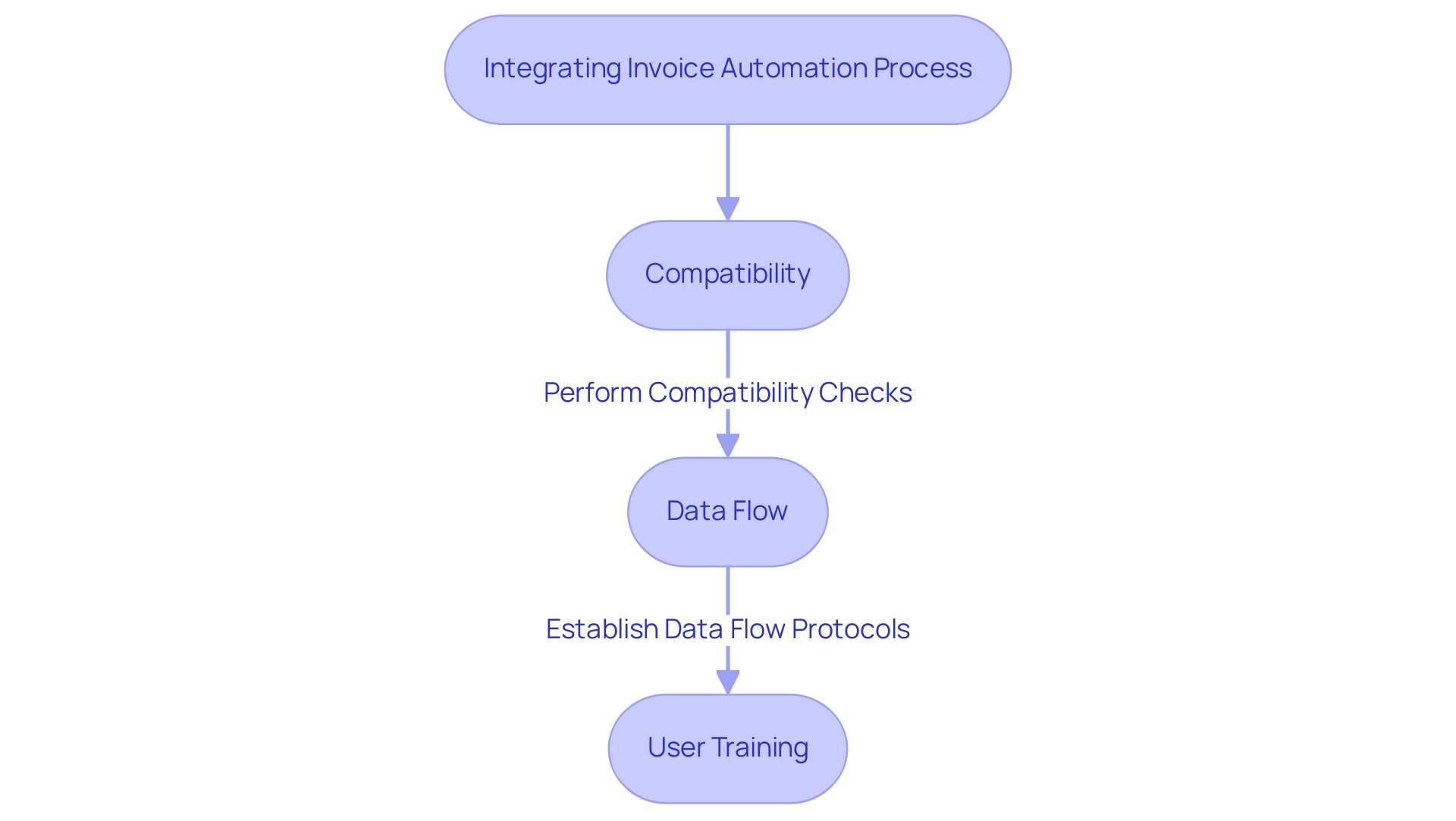
Conclusion
Embracing invoice automation is a transformative step that organizations can take to enhance their operational efficiency and financial processes. By understanding the definition and overview of invoice automation, businesses can appreciate how it streamlines invoicing through advanced technologies, reducing manual errors and ensuring compliance. The key steps in the process, including data capture, validation, approval workflows, payment processing, and reporting, illustrate how automation can significantly improve accuracy and speed while also addressing common challenges such as data quality and integration issues.
The benefits of automating invoicing are compelling, ranging from increased efficiency and reduced errors to improved cash flow management and compliance. Organizations that leverage tailored AI solutions alongside RPA not only streamline their invoicing processes but also foster a more engaged and satisfied workforce. However, overcoming challenges such as resistance to change and integration hurdles is essential for a successful transition.
By prioritizing employee training and establishing robust data governance practices, companies can maximize the effectiveness of their automation initiatives.
Ultimately, integrating invoice automation with existing business systems is crucial for unlocking its full potential. As organizations navigate the complexities of automation, they position themselves to thrive in a competitive marketplace. The journey towards operational efficiency through invoice automation is not just a technological upgrade; it is a strategic move that empowers organizations to achieve greater productivity, cost-effectiveness, and resilience in their financial operations.
Now is the time to embrace this change and harness the capabilities of automation for sustained success.
Introduction
In the rapidly evolving landscape of modern business, Robotic Process Automation (RPA) stands out as a game-changing technology that reshapes how organizations operate. By automating repetitive and rule-based tasks, RPA not only enhances productivity but also liberates human resources to focus on strategic initiatives that drive growth and innovation. This article delves into the core principles of RPA, the vital role of RPA developers, and the myriad benefits that come with its implementation.
Additionally, it addresses common challenges organizations face during RPA adoption and looks ahead to the future trends that promise to further revolutionize the automation landscape. With practical insights and compelling case studies, this exploration equips leaders with the knowledge to harness RPA effectively, ensuring their organizations thrive in an increasingly automated world.
Understanding the Fundamentals of Robotic Process Automation (RPA)
Robotic Process Automation (RPA) is a transformative technology that enables entities to automate repetitive, rule-based tasks typically executed by human workers. By deploying innovative tools like EMMA RPA and Microsoft Power Automate, RPA significantly streamlines workflows, minimizes errors, and boosts overall productivity, ultimately enhancing employee morale.
RPA solutions specifically address challenges such as task repetition fatigue and staffing shortages, allowing organizations to allocate their human resources to more strategic tasks. For instance, Nividous Bots troubleshoot 200-300 video units and cameras daily, showcasing the technology’s efficiency in handling complex tasks.
A recent implementation of a centralized automated business process management system for loan disbursement at a growing bank reduced turnaround time by 78%, illustrating the substantial operational improvements that RPA can achieve. Understanding the foundational principles of RPA is crucial for those new to the technology, as this knowledge lays the groundwork for exploring its advanced applications and benefits.
As emphasized by Nividous, ‘The Nividous Intelligent Integration platform assists businesses in progressing beyond isolated processes by offering a thorough blend of technologies that are inherent to the platform.’ This comprehensive method not only boosts operational efficiency but also meets the changing needs of contemporary businesses, as demonstrated in the case study of a mid-sized company that enhanced efficiency by mechanizing data entry, software testing, and legacy system integration using GUI methods.
The implementation resulted in a 70% reduction in data entry errors, a 50% acceleration in testing processes, and an 80% improvement in workflow efficiency, revolutionizing processes in healthcare service delivery. Furthermore, the incorporation of RPA is visually depicted by a stylized illustration of a human figure working alongside robotic figures, symbolizing the synergy between human intelligence and technology.
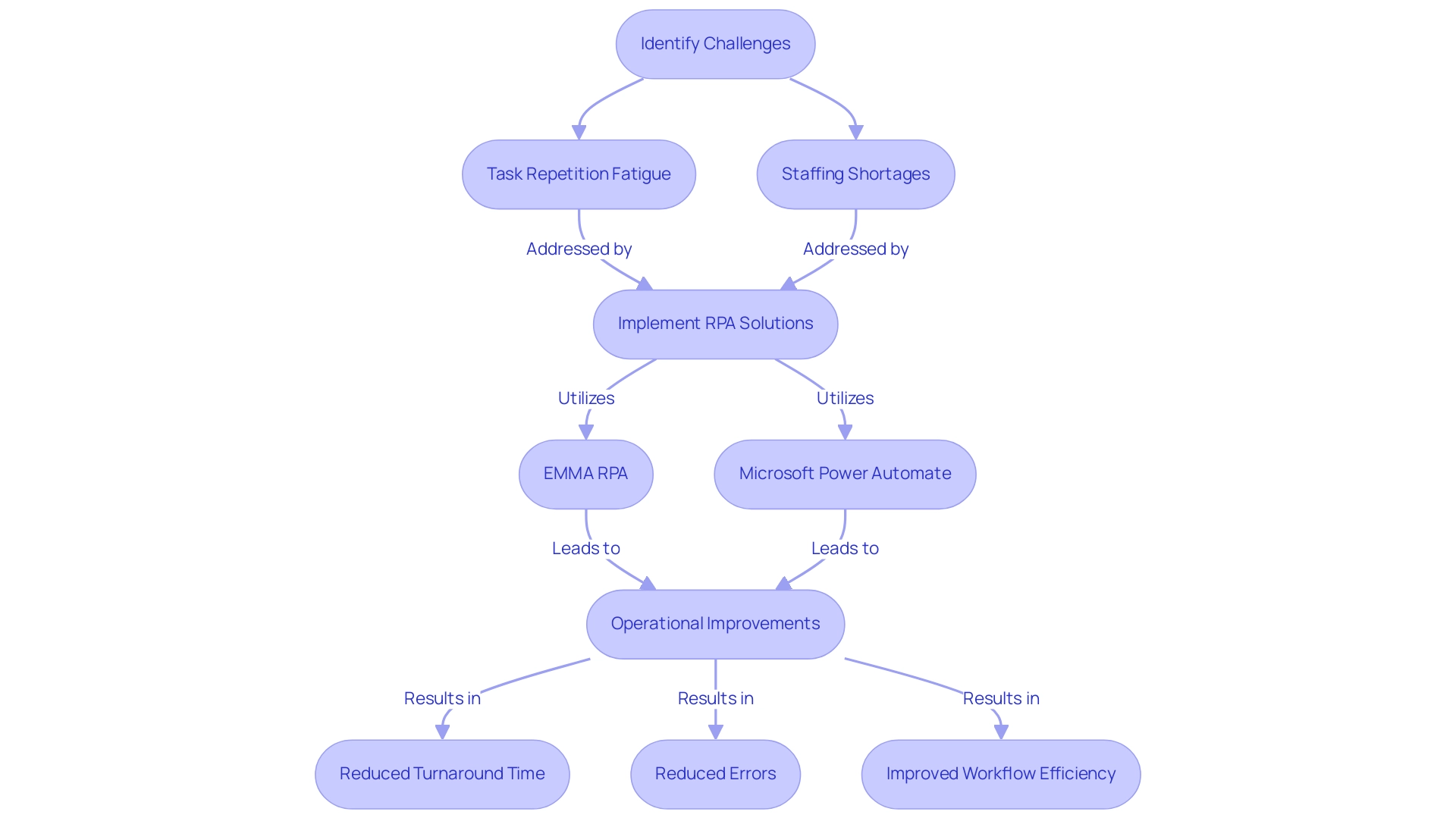
The Role of an RPA Developer: Skills and Responsibilities
An RPA developer is essential to the successful implementation and ongoing maintenance of automated solutions within an organization, addressing common workplace challenges such as repetitive tasks, outdated systems, and talent retention in operational roles. Their main duties involve:
- Examining business operations to identify areas suitable for mechanization.
- Creating and building RPA workflows.
- Thoroughly testing and implementing scripts.
With the increasing complexity of operational demands, leveraging RPA can significantly enhance productivity and operational efficiency by modernizing outdated systems. According to recent data, the average salary of RPA developers varies by region, with professionals in North America earning approximately $100,000 annually, while those in Europe average around $70,000.
To excel in this role, developers must be proficient in programming languages such as Python and Java and have a solid grasp of RPA tools like UiPath and Blue Prism. As noted by RPA expert John Doe, ‘Strong problem-solving skills are essential for developers to troubleshoot and optimize automated processes effectively.’ Furthermore, effective communication is essential, as RPA developers frequently collaborate with business analysts and stakeholders to ensure that initiatives align with business objectives.
Aspiring developers should prioritize honing these skills to navigate the expanding landscape of RPA successfully. As the industry evolves, continuous learning and adaptation remain vital, reinforcing the message that development is at the heart of RPA. For example, the case study titled ‘The Importance of Development in RPA’ demonstrates how entities that emphasize development skills in their RPA teams unleash greater efficiency potential.
Additionally, services like ApiX-Drive facilitate integration with existing systems, allowing users to create their own integrations without requiring programming expertise—a significant advantage in today’s fast-paced business environment.
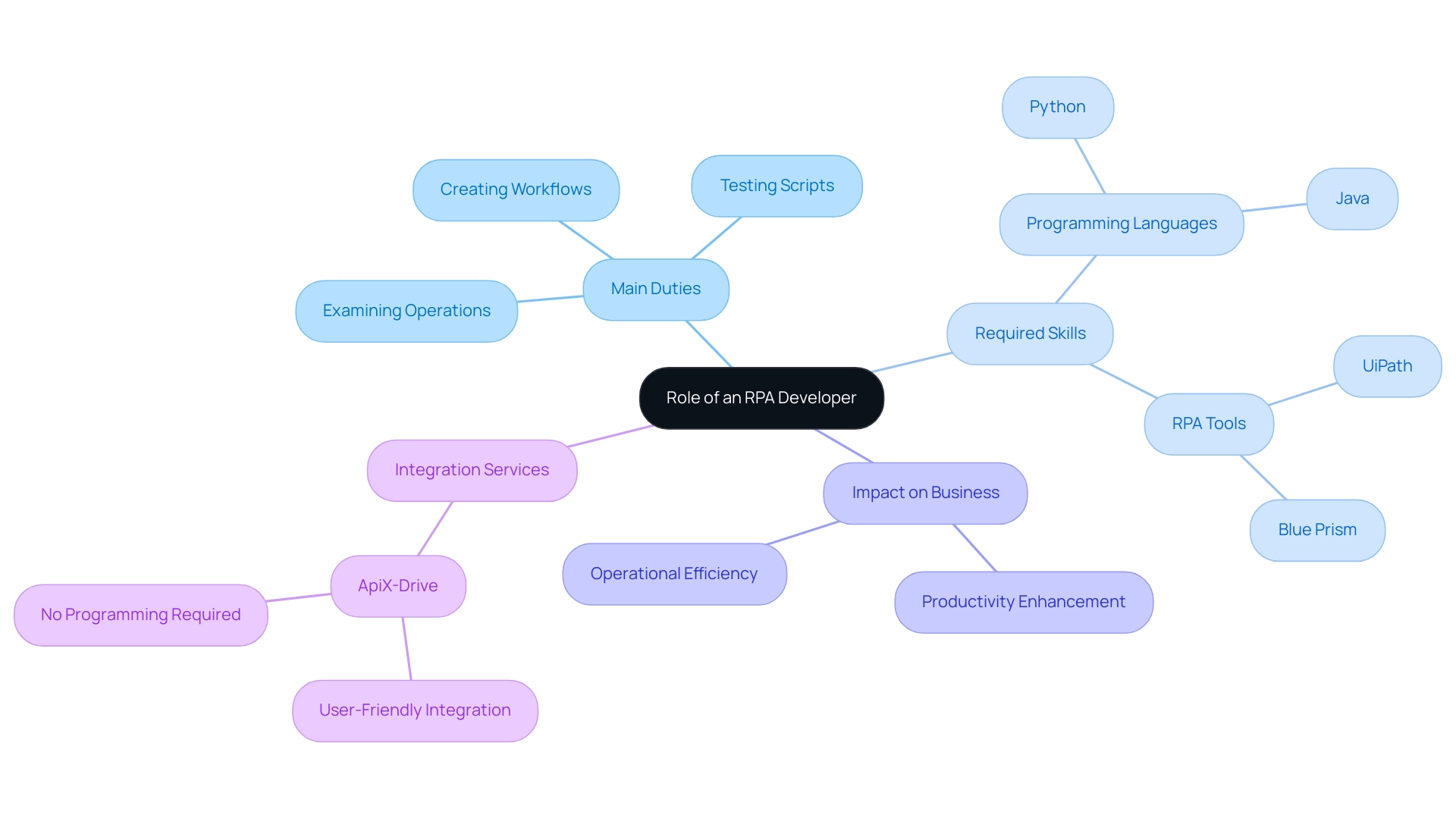
Benefits of Implementing RPA in Organizations
The adoption of Robotic Process Automation (RPA) within organizations unlocks a range of transformative benefits that drive operational excellence. A mid-sized healthcare company faced significant challenges, including:
- Manual data entry errors
- Slow software testing
- Difficulty integrating outdated systems without APIs
The execution of GUI scripting resolved these issues, leading to:
- A 70% decrease in data entry mistakes
- A 50% speedup in software testing activities
- An 80% enhancement in workflow efficiency—realizing a return on investment within only six months.
Furthermore, 85% of respondents in a Deloitte Global RPA Survey reported that RPA met or exceeded their expectations in accuracy, timeliness, and flexibility. By automating routine and mundane tasks, employees can shift their focus to more strategic initiatives, fostering innovation and growth. This shift not only enhances productivity but also boosts job satisfaction, as demonstrated by Deutsche Bank’s experience with back-office improvements, allowing their workforce to concentrate on higher-level functions.
As a representative from Deutsche Bank stated, ‘Deutsche Bank gains the advantage of RPA in various back-office process streamlining,’ highlighting the positive impact on their operations. Additionally, RPA significantly improves compliance and minimizes the risk of human error, as software robots consistently adhere to predefined rules.
The case study of Allianz showcases RPA’s application in cybersecurity, where it was utilized to bolster defenses by automating tasks such as vulnerability scanning and incident response, drastically reducing human errors and improving the capability to detect and handle cyber threats. Organizations also experience rapid scalability, enabling them to swiftly adapt to fluctuating business demands. The transformative effect of GUI automation in healthcare service delivery is evident, as it positions advocates for RPA solutions as key drivers of operational efficiency within their entities.
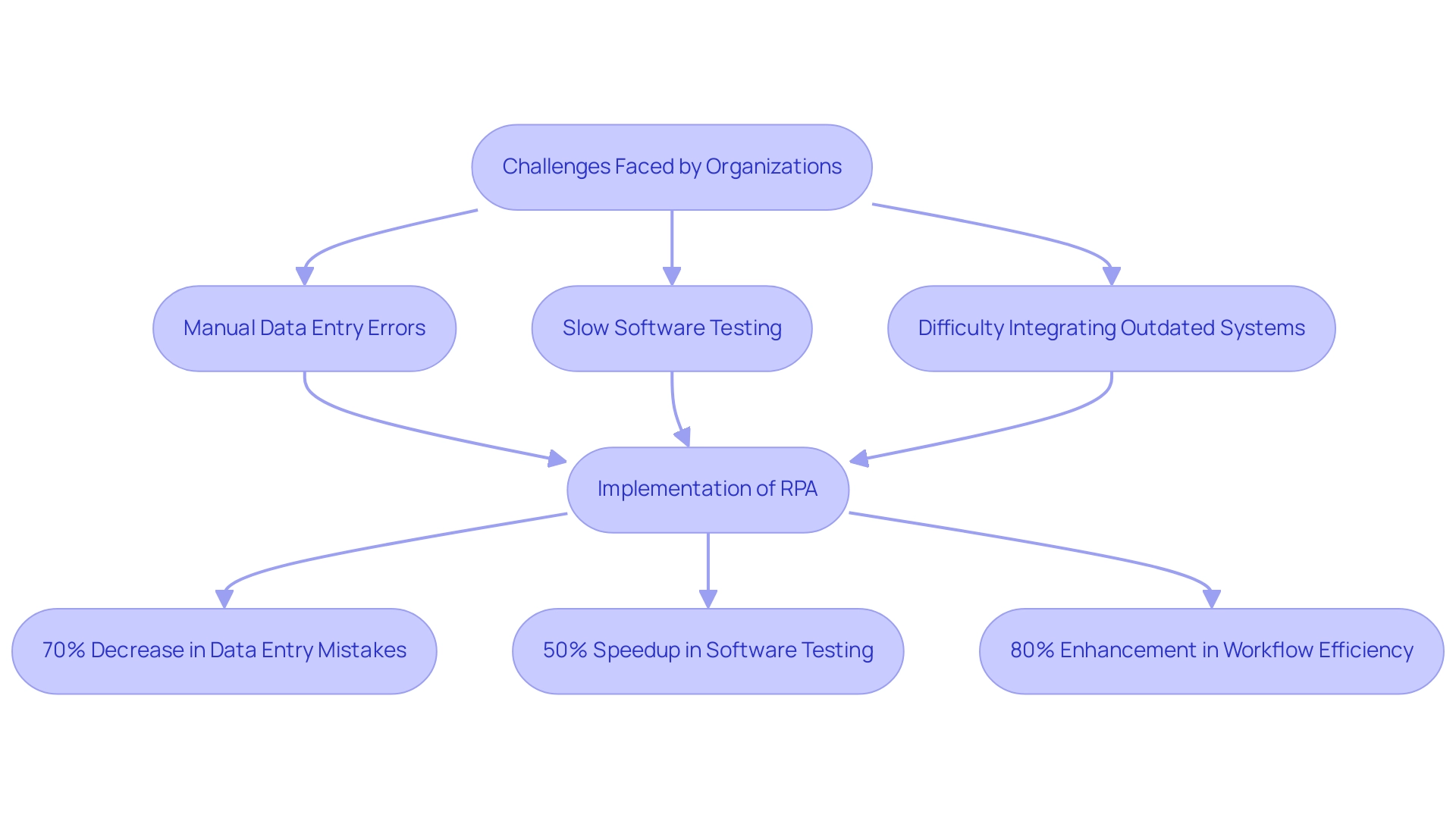
Common Challenges in RPA Implementation
Implementing Robotic Process Automation (RPA) can be transformative, yet organizations often face significant hurdles. One prevalent challenge is employee resistance to change, as many fear job displacement or are uncertain about new technologies. A survey on employee attitudes towards RPA adoption revealed that approximately 60% of employees expressed concerns about job security, highlighting this resistance as a key barrier.
Moreover, insufficient documentation and challenges in integrating RPA with existing systems can hinder progress. For instance, a case study from a leading financial services firm demonstrated that initial resistance was overcome by implementing a comprehensive training program, which led to a 40% increase in employee buy-in and successful integration of RPA into their workflows.
RPA not only streamlines operations but also enhances productivity and reduces costs by automating manual tasks, allowing teams to focus on higher-value activities. To effectively navigate these obstacles, it is crucial to cultivate a culture of collaboration and open communication. Ensuring employees are well-informed about the advantages of RPA fosters acceptance and enthusiasm for the technology.
Furthermore, meticulous process mapping and documentation are vital for identifying opportunities for mechanization and smoothing the implementation journey. Insights from industry leaders suggest that tailoring communication strategies to address specific employee concerns can significantly enhance individual programs. Additionally, integrating Business Intelligence tools can further empower companies to make informed decisions based on data insights, driving growth and innovation.
As Arumugam Subramanyam, RPA AI Architect at Automation Anywhere, aptly notes, ‘the true power lies not in the technology alone but in the human ability to dream, strategize, and lead the orchestration of workflows.’ By proactively tackling these challenges and utilizing Business Intelligence alongside RPA, entities can establish a pathway for successful implementation, merging technology and human creativity to enhance efficiency and innovation.
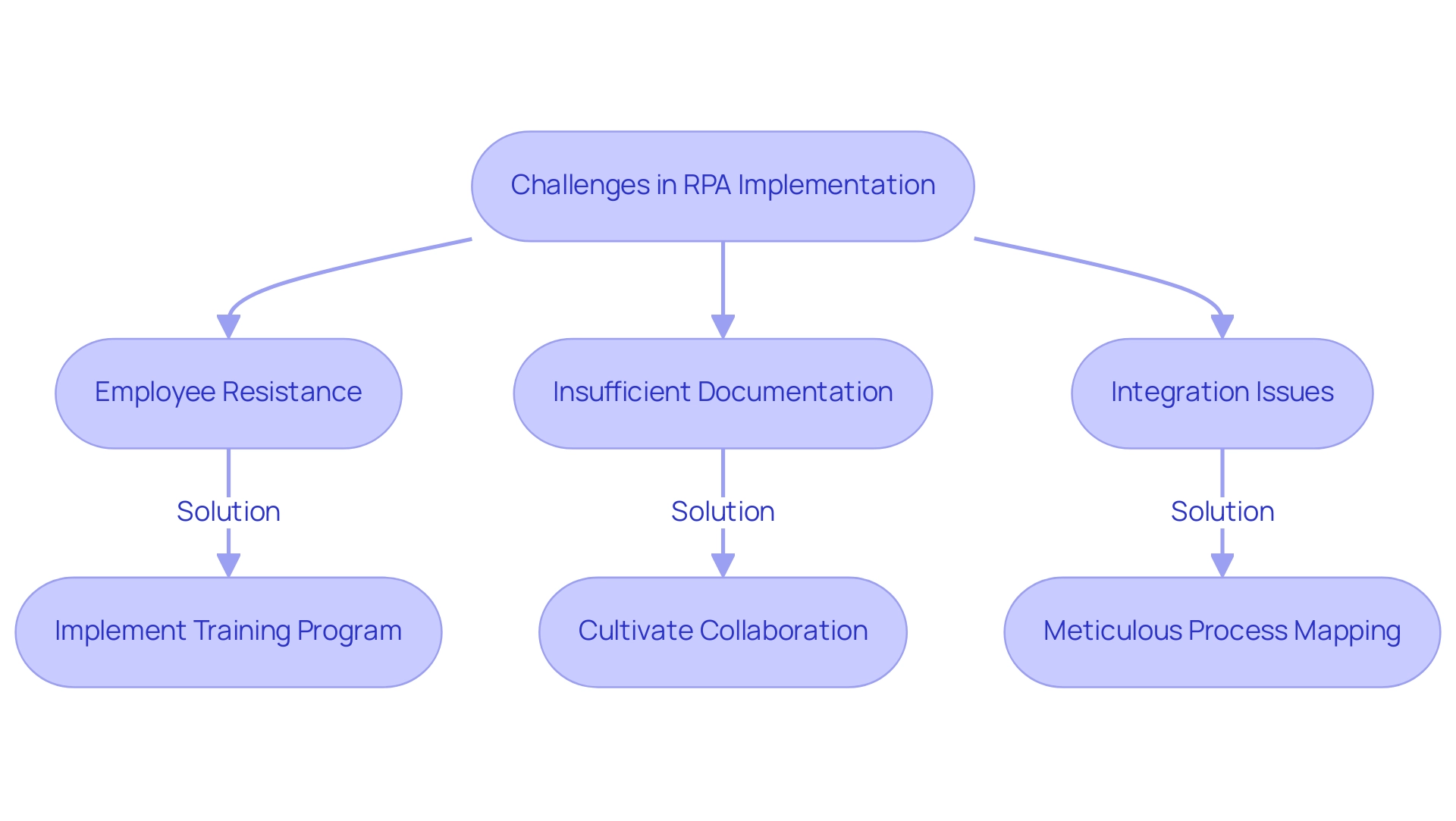
The Future of RPA: Trends and Innovations
The future of Robotic Process Automation (RPA) is undeniably promising, characterized by a wave of continuous innovations poised to significantly enhance its capabilities. One of the most noteworthy emerging trends is the integration of artificial intelligence and machine learning, which empowers RPA systems to tackle increasingly complex tasks and make informed, data-driven decisions. This evolution results in the emergence of intelligent systems, a model that combines RPA with cognitive technologies, enabling smooth execution of end-to-end tasks.
As highlighted by the recent push towards hyperautomation, businesses are increasingly focused on fully automating their operations, thereby improving workflows and allowing individuals to concentrate on more creative and strategic tasks. Such mechanization not only alleviates the challenges of poor master data quality—such as inconsistent, incomplete, or flawed data—but also tackles the common hesitations entities face regarding AI adoption, including uncertainties about integration, implementation difficulties, and perceived expenses.
A pertinent case study on hyperautomation demonstrates how various automation tools are utilized to modify entire business operations, resulting in improved workflows, productivity, and informed decision-making. With 48 percent of entities planning to integrate RPA and business process management into a singular Intelligent Automation platform, staying informed about these trends is essential for any Director of Operations Efficiency aiming to leverage the full potential of RPA within their operations.
As Ganesh Sankaralingam, delivery head at LatentView Analytics, emphasizes, augmented intelligence will be crucial in managing the vast amounts of data while delivering exceptional customer experiences that traditional AI solutions may overlook.
Looking ahead to 2024, specific trends in RPA technology advancements include:
- Enhanced cognitive capabilities
- Greater interoperability between systems
- More sophisticated data analytics tools
All of which will further empower organizations to optimize their operations and achieve a competitive edge.
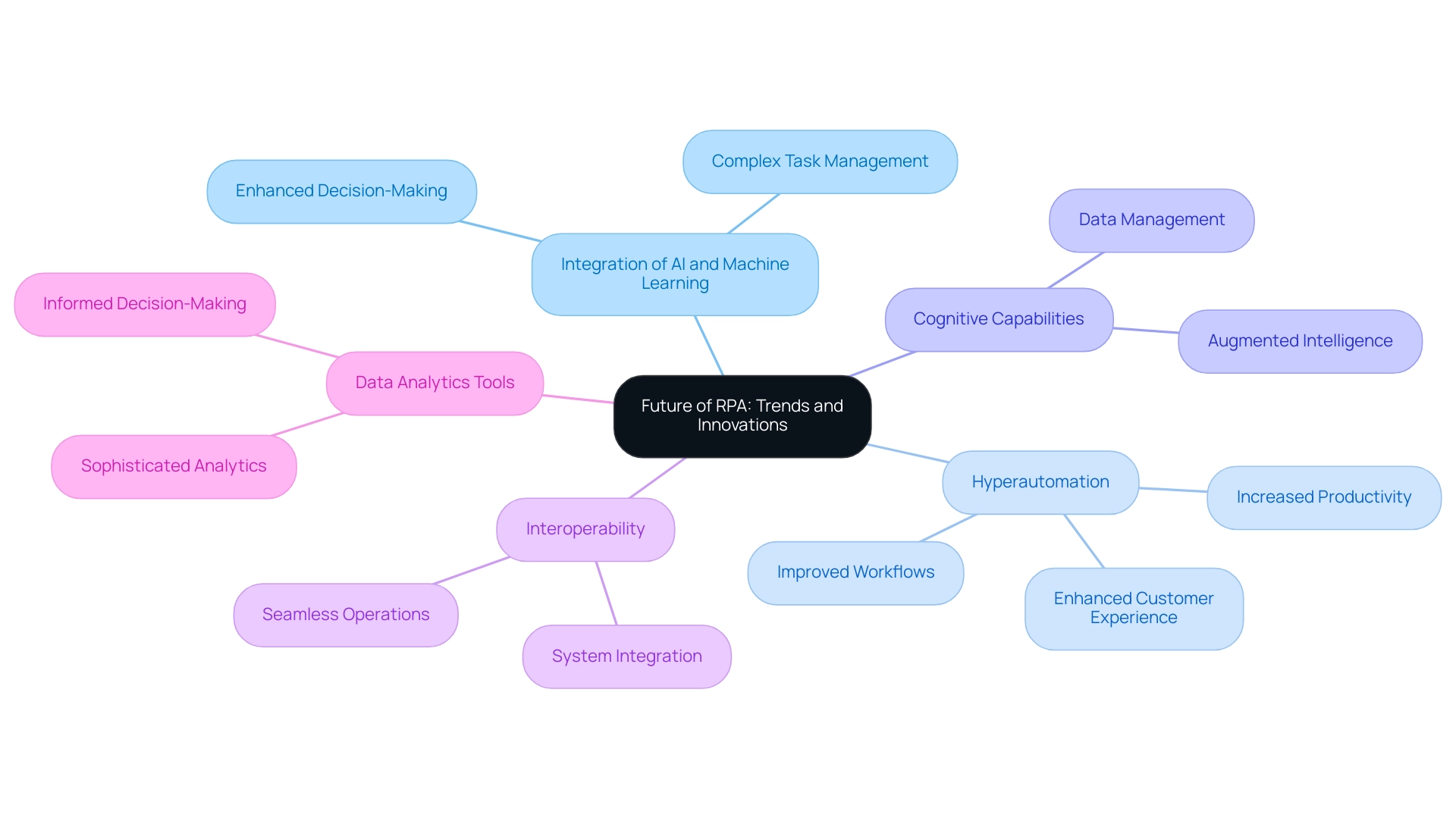
Conclusion
Robotic Process Automation (RPA) is transforming the way organizations operate by automating repetitive tasks, which not only boosts productivity but also allows human resources to engage in more strategic initiatives. The role of RPA developers is crucial in this landscape, as they design, implement, and maintain automation workflows that address operational challenges. With real-world examples showcasing significant improvements in efficiency and accuracy, the benefits of RPA implementation are clear: organizations can reduce errors, enhance compliance, and achieve rapid scalability.
However, the journey to successful RPA adoption is not without its challenges. Employee resistance, inadequate process documentation, and integration issues can hinder progress. It is essential for organizations to foster a culture of collaboration and communication, ensuring that employees understand the advantages of RPA.
Additionally, leveraging Business Intelligence tools can empower teams to make data-driven decisions, paving the way for a smoother implementation process.
Looking to the future, the integration of artificial intelligence and machine learning into RPA systems heralds a new era of intelligent automation. As businesses pursue hyperautomation, the focus will shift towards fully automating operations, ultimately enhancing workflows and enabling employees to concentrate on higher-level functions. Staying informed about emerging trends and innovations will be vital for leaders aiming to harness the full potential of RPA, ensuring their organizations remain competitive and resilient in an increasingly automated world.
Introduction
Artificial Intelligence (AI) is not just a buzzword; it’s a game-changer in the consulting landscape, reshaping how organizations operate and deliver value. By harnessing advanced technologies, businesses can enhance decision-making, streamline processes, and unlock actionable insights that drive significant improvements. From implementing robotic process automation to leveraging predictive analytics, AI is empowering consultants to tackle complex challenges and foster innovation.
However, as firms strive to integrate these transformative solutions, they must navigate hurdles such as employee resistance and data quality issues. This article delves into the multifaceted impact of AI on consulting practices, exploring successful case studies and offering strategic insights to help organizations embrace the future of AI in their operations. With the right approach, firms can not only survive but thrive in an increasingly competitive landscape.
Defining AI in the Consulting Landscape
Artificial Intelligence (AI) is transforming the advisory landscape by integrating advanced technologies and methodologies that significantly improve decision-making, optimize processes, and produce actionable insights that provide substantial business value. AI consulting services include a diverse range of offerings, such as:
- Implementing robotic process automation (RPA)
- Conducting thorough analysis
- Developing customized AI solutions that align with specific organizational objectives
For example, a recent case study illustrated how a mid-sized healthcare company faced challenges with:
- Manual information entry errors
- Slow software testing
- Difficulties integrating outdated systems
By automating data entry, software testing, and legacy system integration using GUI automation, the company achieved a 70% reduction in errors and a 50% acceleration in testing processes. Such measurable outcomes highlight the effectiveness of RPA in enhancing productivity and operational performance.
This strategic approach enables companies to:
- Streamline operations
- Reduce costs
- Boost overall efficiency by automating repetitive tasks and leveraging data-driven insights
As businesses face increasing pressures to innovate and maintain competitiveness, understanding the crucial role of AI in advisory services is essential for skillfully navigating the complexities of modern operations and utilizing the potential of these transformative technologies.
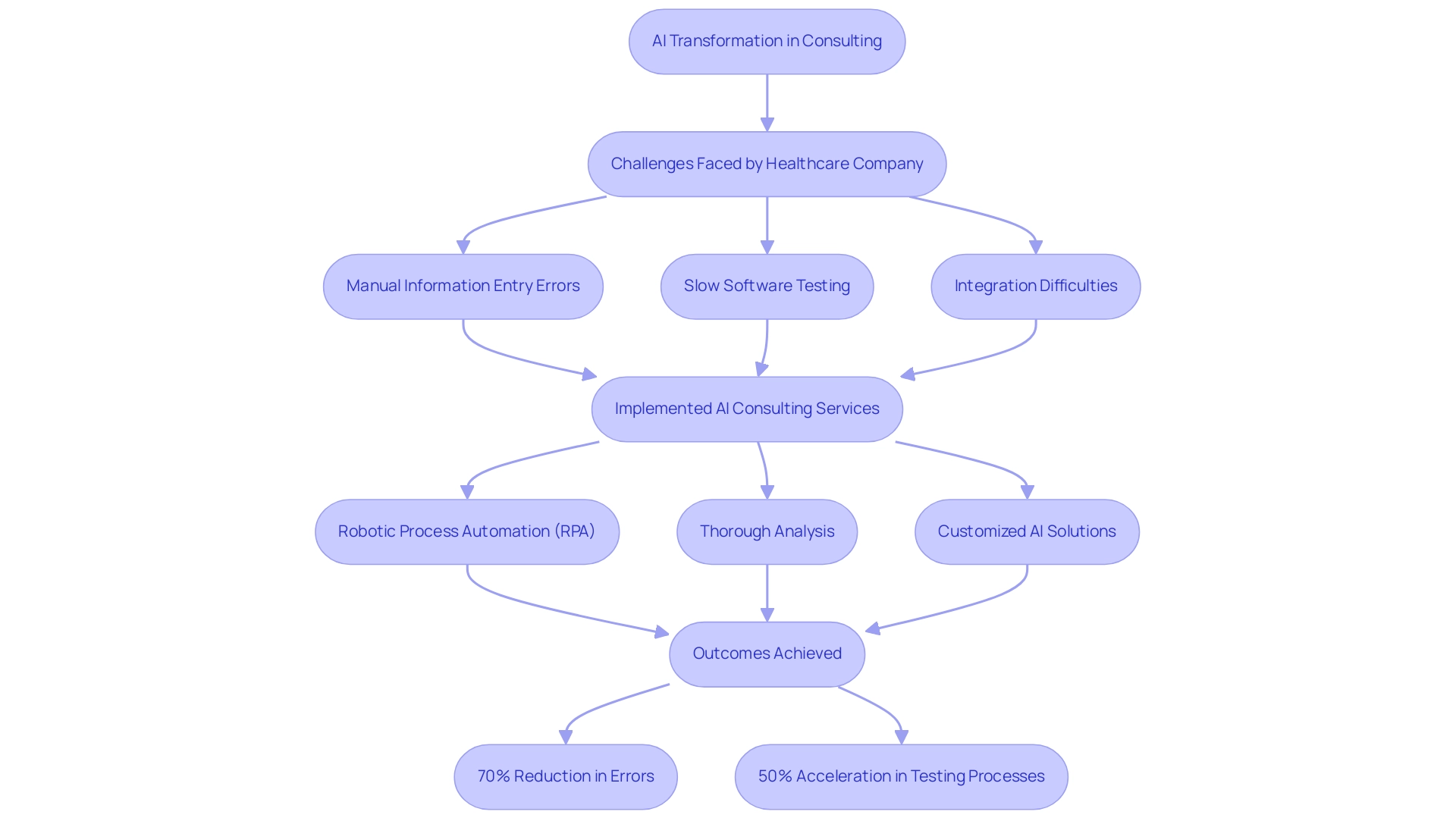
The Transformative Impact of AI on Consulting Practices
The impact of AI on consulting practices is nothing short of revolutionary, ushering in a shift from conventional methodologies to forward-thinking, technology-driven strategies. Recent advancements in AI tools, such as enhanced natural language processing and machine learning algorithms, empower consultants to analyze extensive datasets at remarkable speeds, providing actionable insights that were once beyond reach.
Our Robotic Process Automation (RPA) solutions, including EMMA RPA and Microsoft Power Automate, specifically address task repetition fatigue and staffing shortages by streamlining repetitive tasks like data entry and report generation. This significantly enhances operational productivity and employee morale, allowing consultants to focus on strategic, high-value activities and fostering creativity in problem-solving.
Furthermore, AI personalizes client interactions through predictive analytics and enhanced communication channels, ensuring that the human element remains integral to the advisory process. As a result, advisory firms that effectively harness these AI technologies are elevating their operational efficiency and delivering exceptional value to clients, leading to increased satisfaction and fostering long-term, mutually beneficial partnerships.
Embracing transformative tools and strategies, such as tailored AI solutions and GenAI Workshops, positions firms to navigate the overwhelming AI landscape and thrive in the evolving advisory environment of 2024 and beyond.
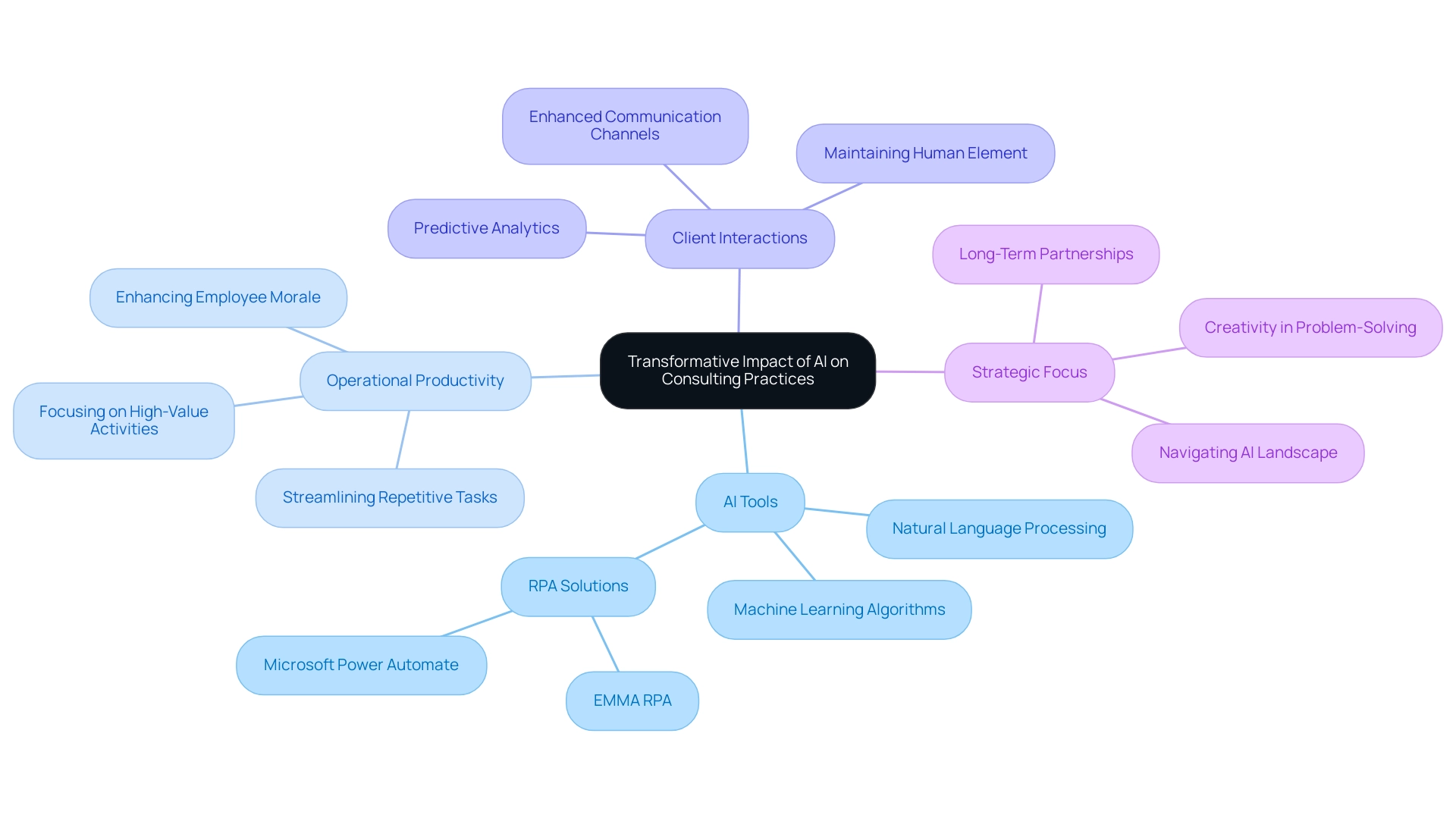
Challenges in Implementing AI Solutions in Consulting
Implementing AI solutions in consulting can be a complex journey, fraught with challenges that organizations must navigate with care. A significant hurdle is often the resistance to change from employees, which stems from fears of job displacement and a general apprehension toward new technologies. Recent statistics reveal that only 16% of respondents feel their organizations fully understand the costs associated with developing AI-based products and services, indicating a concerning knowledge gap that can intensify resistance. Furthermore, integration issues with existing systems complicate this landscape, as consultants face difficulties aligning new AI capabilities with established workflows.
Matthew Evans, Vice President of Digital Transformation at Airbus, emphasizes a crucial mindset: “We don’t invest in AI. We invest in solving business problems.” This perspective highlights the necessity of framing AI initiatives around tangible business challenges rather than the technology itself, ensuring that every implementation drives value.
Moreover, addressing poor master information quality is critical; inconsistent and inaccurate information can lead to misguided insights and flawed decision-making. Robotic Process Automation (RPA) can play a vital role here by automating data entry and validation processes, thereby improving data accuracy and consistency. Organizations like Infosys set a proactive example by training employees to adapt to AI-driven changes in service offerings, fostering a collaborative culture that significantly reduces resistance to AI adoption.
By tackling these challenges directly—through comprehensive training, highlighting long-term benefits, and cultivating an innovation-friendly environment—consulting firms can successfully navigate the complexities of AI implementation and unlock its vast potential. It is imperative for companies to act decisively in preparing for AI’s impacts. Inertia is not an option; executives must develop a foundational understanding of AI to leverage analytics effectively, which is crucial for overcoming employee resistance and achieving successful implementation. Customized AI solutions, along with RPA, can offer the essential assistance to improve operational performance and meet specific business requirements.
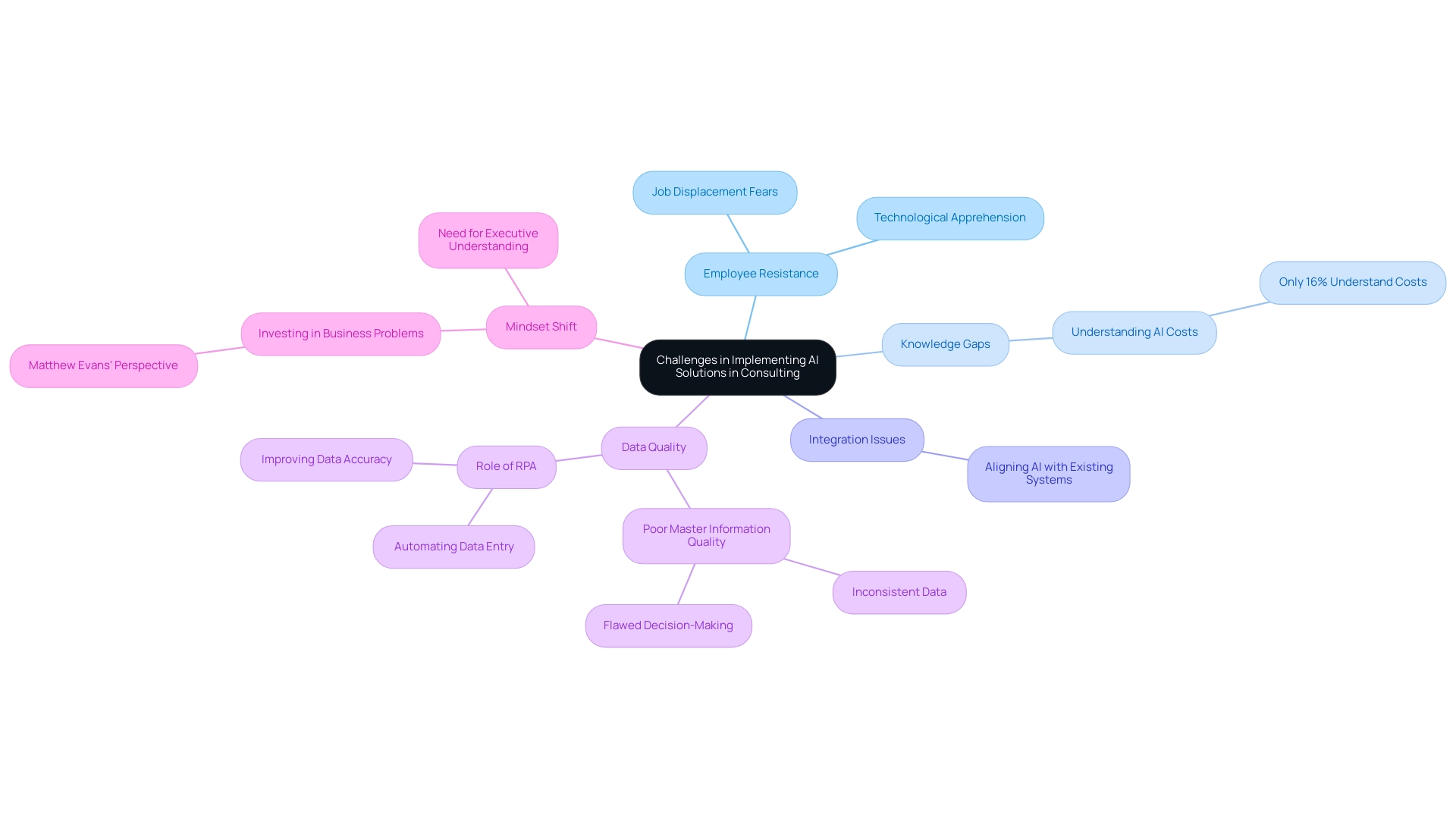
The Future of AI in Consulting
The future of AI in advisory services is poised for unprecedented growth and innovation. With the rise of Robotic Process Automation (RPA), businesses can automate manual workflows, significantly boosting operational efficiency and employee morale. Tools such as EMMA RPA and Microsoft’s Power Automate are at the forefront of this transformation, enabling organizations to streamline their processes effectively.
According to EY’s analysis, jurisdictions such as Canada and the EU are implementing varied regulatory approaches that shape the landscape for AI applications in advisory services. As the technological landscape evolves, companies can expect a surge of sophisticated AI applications designed to enhance decision-making processes. A notable trend is the burgeoning field of AI-driven predictive analytics, empowering consultants to deliver precise forecasts and strategic recommendations that drive business growth.
For instance, a case study from EY highlights how an advisory firm utilized predictive analytics to optimize supply chain management, leading to a remarkable 20% reduction in operational costs. Furthermore, the integration of Business Intelligence with RPA allows organizations to transform raw data into actionable insights, enabling informed decision-making.
However, as businesses navigate the overwhelming array of AI options, tailored solutions become essential for identifying the right technologies that align with specific goals. As AI becomes increasingly integral to advisory practices, firms that commit to continuous learning and adaptability will be uniquely positioned to excel in this evolving landscape.
At EY, we are dedicated to building a better working world, recognizing that our insights and services create long-term value for clients, people, and society, while fostering trust in capital markets amidst these transformative changes in AI regulation and strategy.
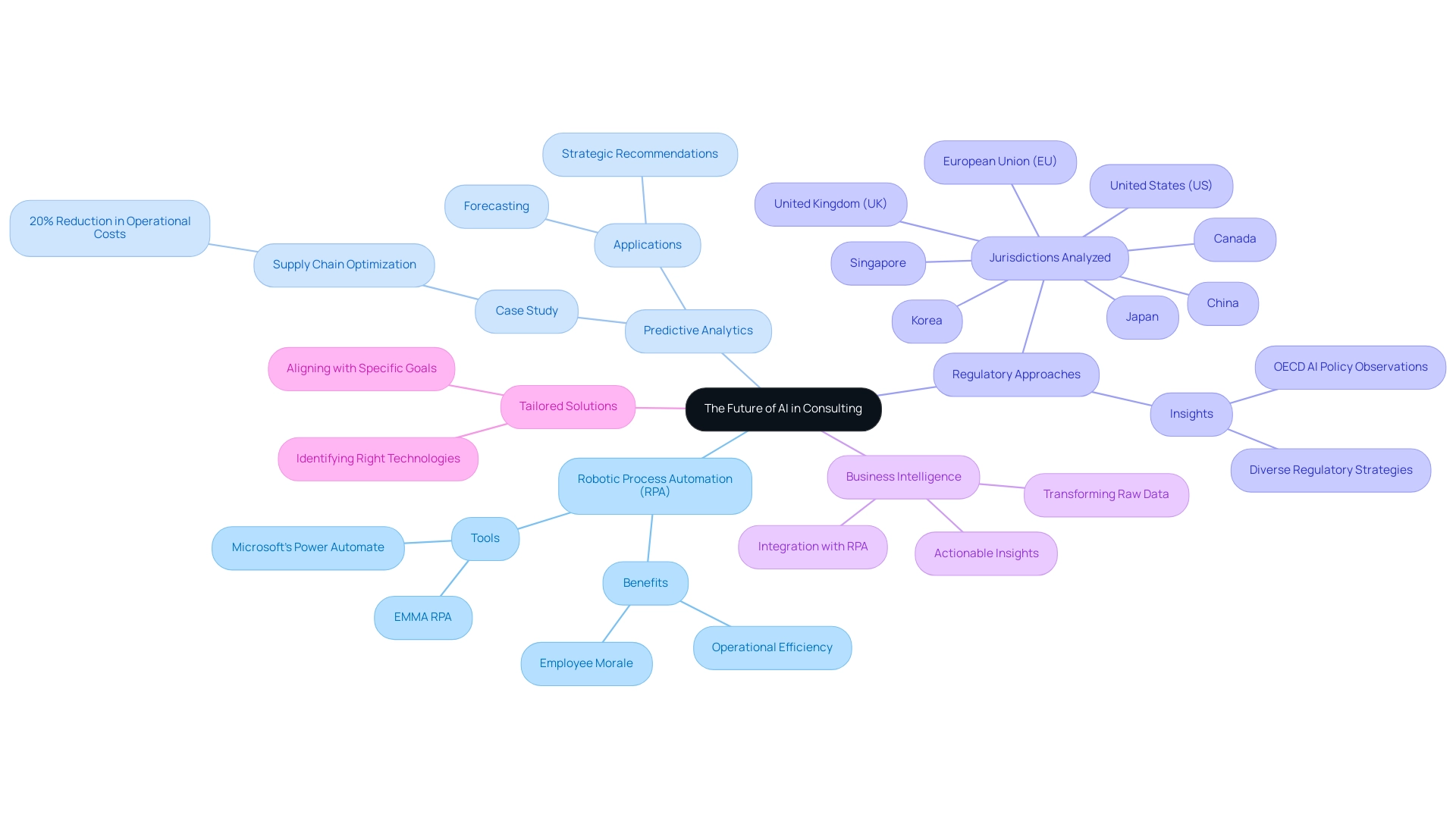
Case Studies: Successful AI Implementations in Consulting
Organizations across different sectors have effectively utilized the capabilities of AI solutions to transform their consulting practices, resulting in substantial enhancements in productivity and client satisfaction. For instance, a mid-sized company faced challenges such as:
- Manual information entry errors
- Slow software testing
- Difficulty integrating outdated systems without APIs
By automating information entry, software testing, and legacy system integration through GUI automation, the company achieved a remarkable 70% reduction in entry errors and an 80% enhancement in workflow efficiency. Similarly, a prominent management advisory firm implemented AI-driven analytics to refine its client onboarding process, achieving a 30% reduction in onboarding time while boosting client satisfaction scores.
In another notable instance, a financial advisory firm adopted Robotic Process Automation (RPA) to streamline data collection and reporting, minimizing errors and allowing consultants to focus on high-value strategic advisory services. As Ross Kurhanskyi, VP of Business Development, emphasizes, “Contact MagicFuse for a strategic AI implementation plan to integrate Salesforce Einstein AI effectively.”
These compelling case studies demonstrate the transformative potential of AI in consulting, showcasing its ability to enhance operational efficiency and deliver superior outcomes for clients. By studying these successful implementations, other firms can gain valuable insights into effectively integrating AI into their operations, paving the way for improved performance and client engagement.
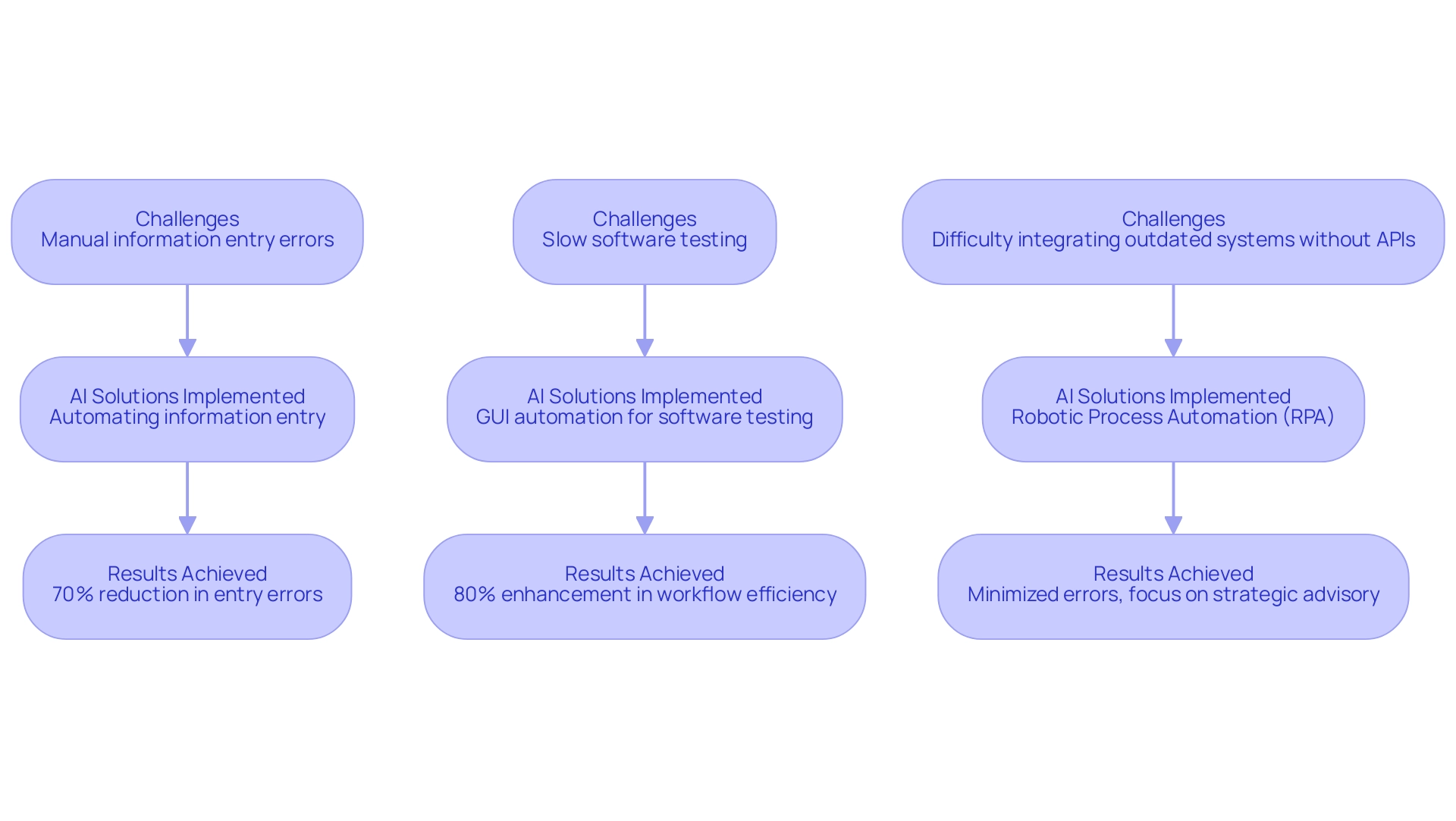
Conclusion
The integration of Artificial Intelligence in consulting is not merely an enhancement; it is a fundamental shift that redefines how organizations operate. By embracing AI technologies such as robotic process automation and predictive analytics, consulting firms can streamline operations, reduce costs, and unlock new levels of efficiency. The case studies presented illustrate that businesses can achieve significant improvements—like a 70% reduction in data entry errors and a 30% decrease in onboarding time—by implementing tailored AI solutions.
However, the path to successfully integrating AI is not without its challenges. Resistance from employees and data quality issues can hinder progress. It is crucial for organizations to address these hurdles head-on by fostering a culture of collaboration, providing comprehensive training, and emphasizing the tangible business problems that AI can solve.
By doing so, firms can mitigate fears associated with technological change and promote a more innovative environment.
Looking ahead, the future of AI in consulting is bright, with continuous advancements poised to drive further innovation. Organizations that commit to adapting and learning will not only navigate the complexities of AI but will also thrive within the evolving landscape. As consultants leverage AI to enhance decision-making and deliver exceptional value, the potential for improved client satisfaction and operational success becomes limitless.
The time to act is now; embracing AI is essential for firms aiming to stay competitive and achieve long-term success in the consulting arena.
Introduction
In the dynamic landscape of modern business, organizations are increasingly turning to Robotic Process Automation (RPA) as a powerful solution to streamline operations and enhance productivity. This technology enables the automation of repetitive, rule-based tasks, allowing companies to reduce errors and free up valuable human resources for more strategic initiatives. As businesses navigate the complexities of integrating RPA into their workflows, understanding the core principles, essential skills for developers, and the right tools becomes paramount.
This article delves into the comprehensive world of RPA, providing insights into its components, benefits, and implementation strategies, empowering organizations to harness its full potential for operational excellence.
Understanding Robotic Process Automation: A Comprehensive Overview
Robotic Process Automation (RPA) refers to the technology that enables the automation of repetitive and rule-based activities using software robots or ‘bots’. These bots can imitate human actions, engaging with digital systems and applications to carry out activities such as data entry, processing transactions, and responding to queries. RPA is significant because it allows organizations to streamline operations, reduce errors, and free up human resources for more strategic activities. By implementing RPA, businesses can improve productivity and efficiency while minimizing operational costs. Understanding the core principles of RPA, including its components and deployment strategies, is crucial for anyone looking to master this technology.
Key Components of RPA:
- Software Bots: The core of RPA, these bots perform activities as programmed, enhancing business productivity.
- Control Center: The user-friendly interface for monitoring and managing bots, ensuring seamless digitalization.
- Analytics Tools: Used to measure performance and identify areas for improvement, facilitating data-driven insights.
Benefits of RPA:
- Increased efficiency and productivity through mechanization of manual workflows.
- Enhanced accuracy and reduced errors, addressing operational challenges like staffing shortages and outdated systems.
- Cost savings derived from mechanizing repetitive tasks, allowing resources to focus on strategic initiatives.
- Improved compliance and audit trails, crucial for informed decision-making in a rapidly evolving AI landscape.
By grasping these foundational concepts, learners can better appreciate how RPA, combined with tailored AI solutions and business intelligence, can transform their organizations and prepare themselves for the next steps in mastering this technology. To explore how RPA can specifically benefit your operations, book a free consultation today!
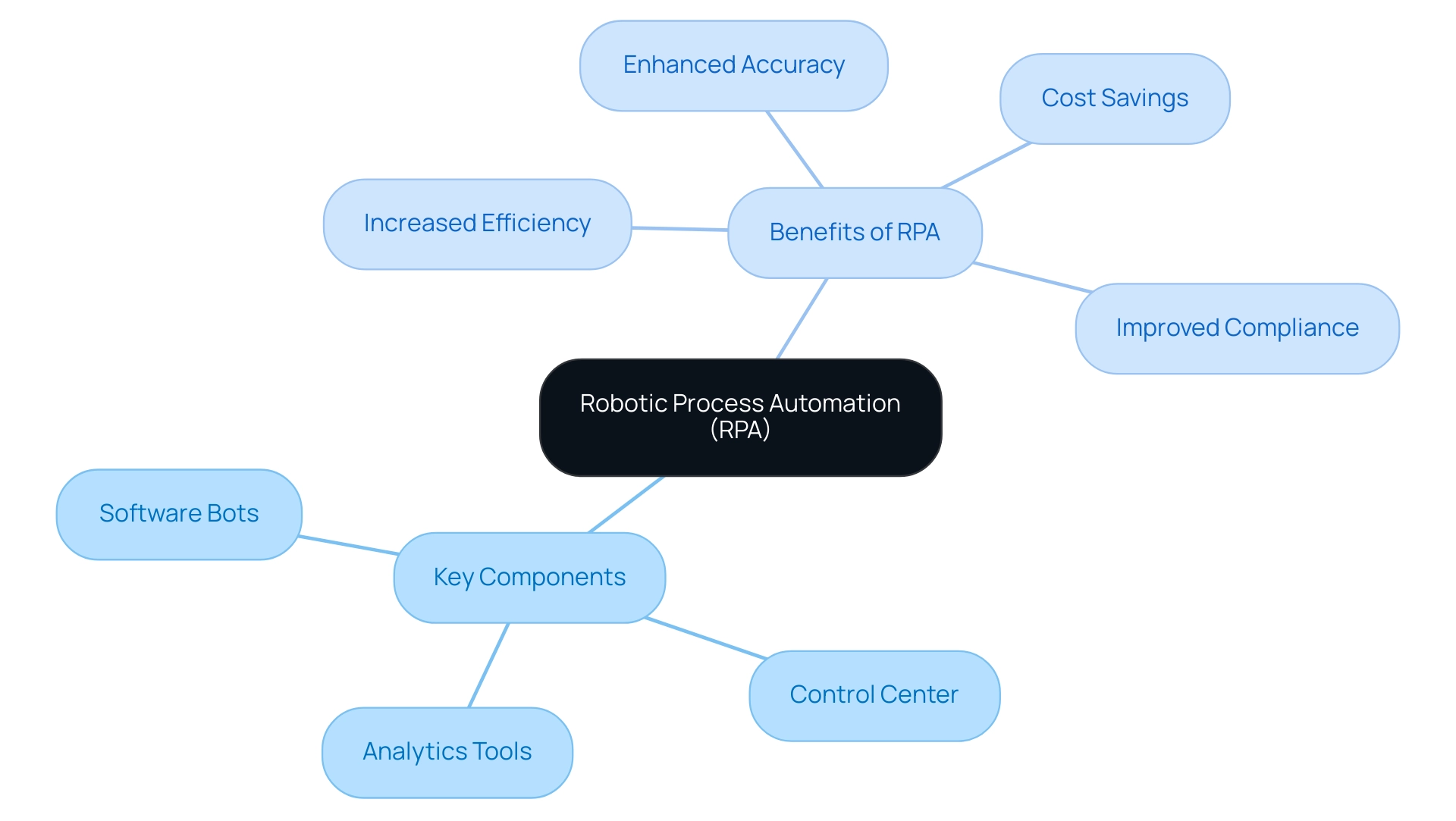
Essential Skills and Certifications for Aspiring RPA Developers
To become an RPA developer, individuals need to cultivate a combination of technical and soft skills that empower them to address workplace challenges effectively. Here are the essential skills required:
Technical Skills:
- Programming Knowledge: Familiarity with programming languages such as Python, Java, or C# is beneficial, enabling developers to create customized solutions.
Understanding of RPA Tools: Proficiency in popular RPA tools like UiPath, Automation Anywhere, or Blue Prism is crucial for streamlining workflows and enhancing operational efficiency. - Process Mapping: The capability to analyze and design workflows to identify automation opportunities is essential, assisting businesses in addressing repetitive activities and outdated systems.
Data Management: Skills in handling data and understanding databases are important for integrating RPA solutions, facilitating informed decision-making that drives growth.
Soft Skills:
- Problem-Solving: RPA developers must be adept at troubleshooting and optimizing processes, which is vital in a rapidly evolving AI landscape.
- Communication: Clear communication with stakeholders is essential for understanding requirements and delivering tailored solutions to combat staffing shortages and operational inefficiencies.
- Adaptability: The ability to learn and adapt to new technologies and methodologies is vital in the fast-evolving field of RPA, ensuring developers remain at the forefront of innovation.
Certifications:
- UiPath Certified RPA Associate: A foundational certification for beginners, validating essential skills in RPA.
- Automation Anywhere Certified Advanced RPA Professional: For those looking to deepen their expertise and enhance their career prospects in automating manual workflows.
- Blue Prism Developer Certification: A recognized certification for Blue Prism users, reinforcing competence in RPA development.
Pursuing these certifications not only validates one’s skills but also strengthens career prospects in the growing field of RPA. By focusing on these essential areas, aspiring RPA developers can position themselves for success in their careers, ultimately contributing to enhanced business productivity. Furthermore, RPA solutions can significantly alleviate the emotional toll on employees caused by repetitive tasks, streamline processes, reduce errors, and boost overall productivity, making them invaluable in modern operational environments.
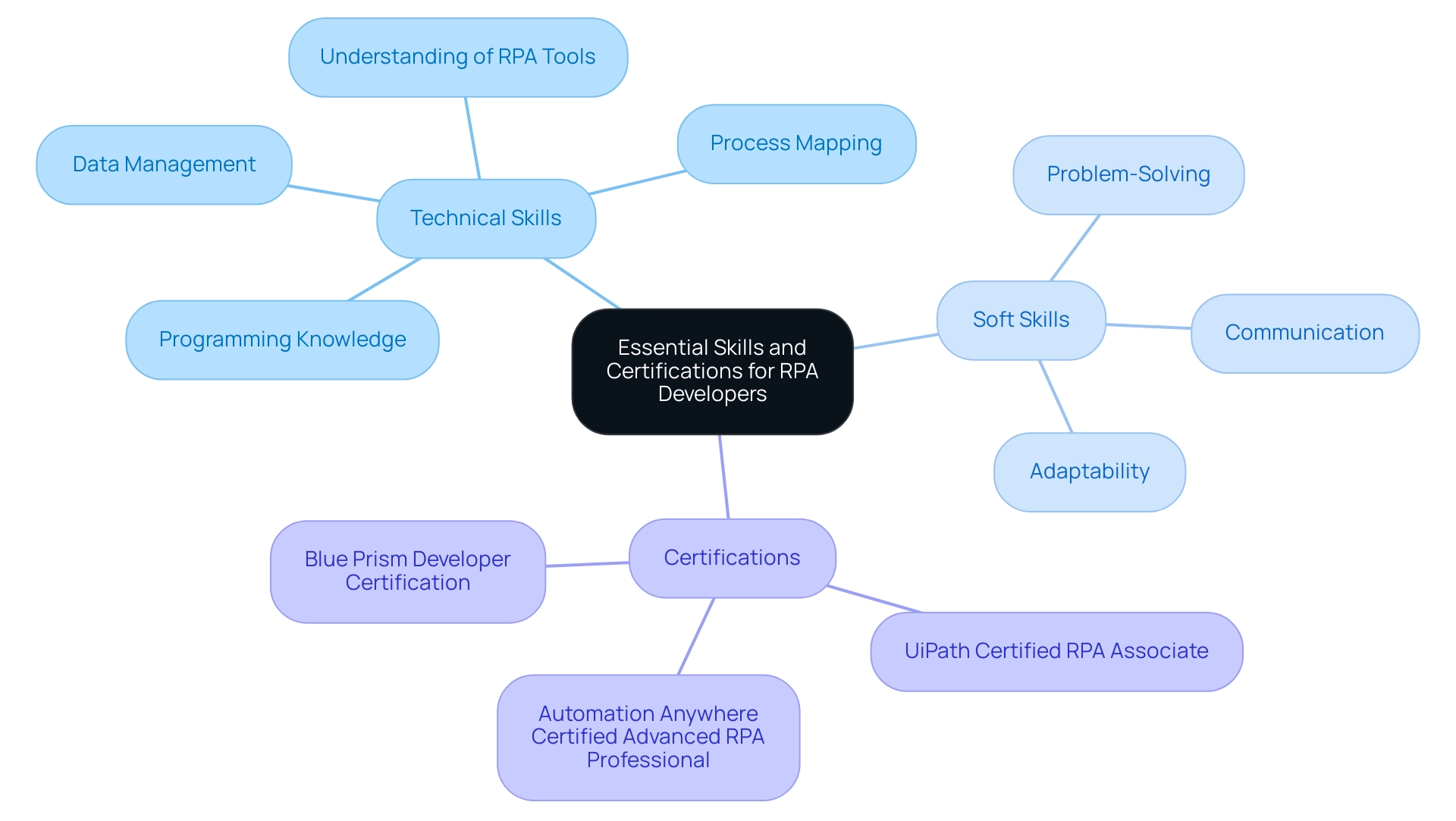
Choosing the Right RPA Tool for Your Needs
When selecting an RPA tool, it’s crucial to evaluate several key factors to ensure a successful implementation:
-
Ease of Use:
Prioritize platforms with intuitive interfaces that empower both technical and non-technical users to effortlessly create and manage automation workflows. This accessibility can significantly enhance adoption across your organization, fostering a culture of productivity. -
Integration Capabilities:
A robust RPA tool must seamlessly integrate with your existing systems and applications. This capability is vital for efficient processes, as it allows software robots to interact with legacy systems and modern applications alike, thereby minimizing disruptions. As observed in the context of addressing technology implementation challenges, organizations must evaluate their specific needs to select resources that integrate well with their existing infrastructure. -
Scalability:
Select a tool that not only meets your current automation requirements but can also scale with your organization’s growth. This flexibility ensures that as your needs evolve, your automation efforts can expand without requiring a complete overhaul of your systems, thereby enhancing business productivity. -
Support and Community:
Evaluate the availability of support resources, including training programs and community forums. A strong support network can be invaluable for troubleshooting and enhancing your team’s proficiency in utilizing the resource, especially in today’s rapidly evolving AI landscape. -
Cost:
Conduct a thorough cost analysis of the RPA tool, considering licensing fees, maintenance costs, and any additional charges associated with features or support. Understanding the total cost of ownership—including how tailored AI solutions can impact overall costs—will help you make an informed decision that aligns with your operational efficiency goals.
Incorporating RPA can significantly enhance operational efficiency; for instance, an RPA bot can complete tasks that would usually take hours manually. Popular RPA solutions like UiPath, Automation Anywhere, Blue Prism, and Microsoft Power Automate each provide unique strengths suited to various organizational needs. Furthermore, integrating these RPA tools with tailored AI solutions can enhance their effectiveness, allowing for more intelligent processes. As Samer Awajan, CTO of Aramex, notes, “ELEKS has been involved in the development of a number of our consumer-facing websites and mobile applications that allow our customers to easily track their shipments… We’ve appreciated the level of ELEKS’ expertise, responsiveness, and attention to details.” By meticulously assessing these factors and aligning them with your specific requirements, you can establish a solid foundation for your automation journey, enhancing operational efficiency and driving sustainable growth.
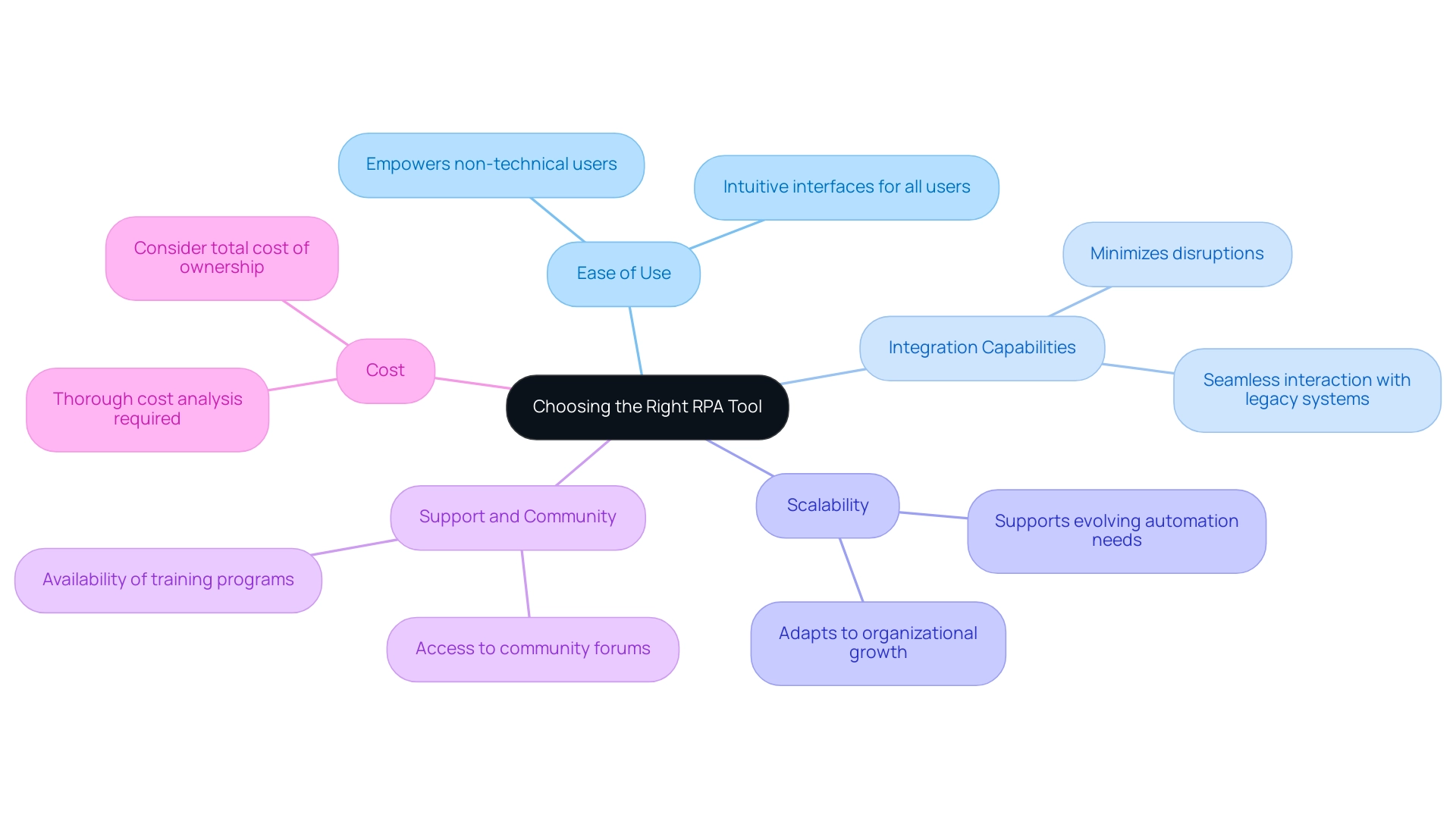
Implementing Your First RPA Project
To implement your first RPA project and address common workplace challenges, follow these steps:
-
Identify a Suitable Process:
Choose a repetitive, rule-based activity that is time-consuming and prone to errors, such as data entry, report generation, or invoice processing. Identifying these tasks will help alleviate the burden on your team, improve morale, and combat the frustration caused by mundane work. -
Document the Process:
Create a detailed process map that outlines each step involved, including inputs, outputs, decision points, and exceptions. This documentation will serve as a guide during process optimization and will aid in retaining knowledge within your team, reducing the impact of staffing shortages.
Select Your RPA Solution:
Based on the evaluation in the previous section, choose an RPA solution that best fits your needs and budget, ensuring it aligns with your operational goals and addresses any outdated systems that may hinder efficiency.
-
Build the system:
Using the selected RPA tool, start creating the workflow based on the documented process. Leverage built-in features like drag-and-drop functionality to simplify the development process and enhance efficiency. -
Test the Automation:
Conduct thorough testing to ensure the bot performs as expected. Validate outputs against the original manual process to confirm accuracy and efficiency, ultimately reducing errors in your operations. -
Deploy the Bot:
Once testing is complete, deploy the bot in the production environment. Monitor its performance closely during the initial phase to address any issues promptly, allowing your team to focus on more strategic, value-adding work. -
Gather Feedback and Optimize:
Collect feedback from users and stakeholders to identify areas for improvement. Continuously optimize the processes based on insights and changing business needs, helping you to stay competitive in a rapidly evolving AI landscape.
By following these steps, you can successfully implement your first RPA project, enhance productivity, and navigate the complexities of systematization in your organization.
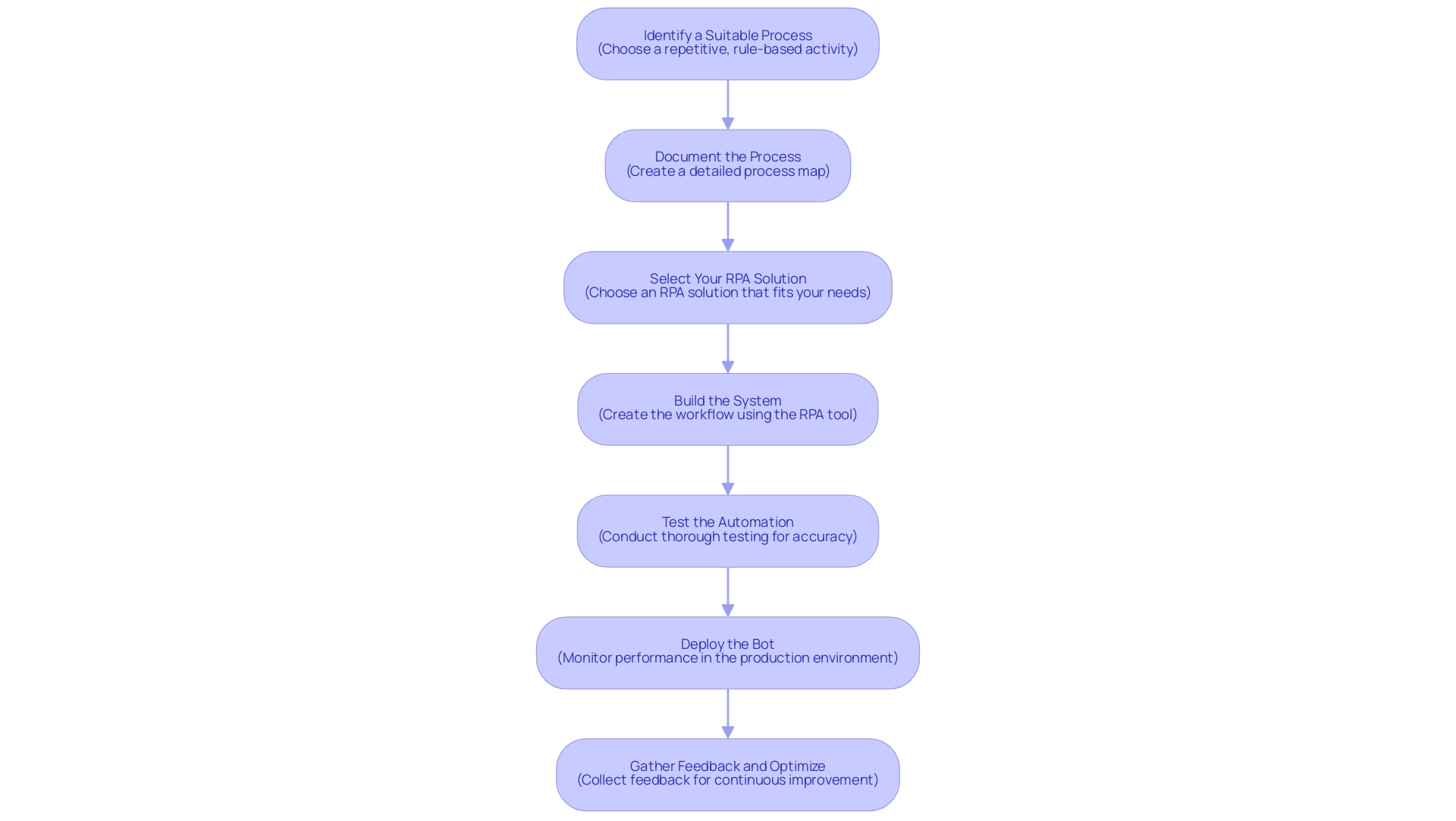
Measuring the Success of Your RPA Initiatives
To measure the success of your RPA initiatives, consider the following metrics:
-
Challenges:
The mid-sized healthcare company faced significant challenges, including manual data entry errors, slow software testing, and difficulties integrating outdated systems without APIs. -
Return on Investment (ROI):
Calculate the financial benefits gained from mechanization against the costs incurred during implementation. For instance, the company achieved a positive ROI within 6 months by automating data entry and software testing. -
Time Savings:
Monitor the amount of time conserved by automating activities in comparison to the manual process. The aforementioned case demonstrated time savings of up to 50% in software testing processes, showcasing the efficiency gains achieved through RPA. -
Error Reduction:
Monitor the decrease in errors and rework associated with automated processes. In the case study, data entry errors were reduced by 70%, leading to improved quality and customer satisfaction. -
Employee Satisfaction:
Gather feedback from employees affected by automation. Increased job satisfaction often results from freeing staff from mundane tasks, allowing them to focus on more strategic work, as evidenced by the improved morale reported in the case study. -
Scalability:
Assess how well your RPA solution can scale to accommodate growing business demands. The successful implementation in the case study demonstrated that their RPA initiatives were capable of handling increased workloads without significant additional costs.
By applying these metrics, organizations can gain valuable insights into the effectiveness of their RPA initiatives, driving continuous improvement and ensuring alignment with broader business objectives. The transformative impact of RPA can revolutionize processes in healthcare service delivery, enhancing operational efficiency and software quality.
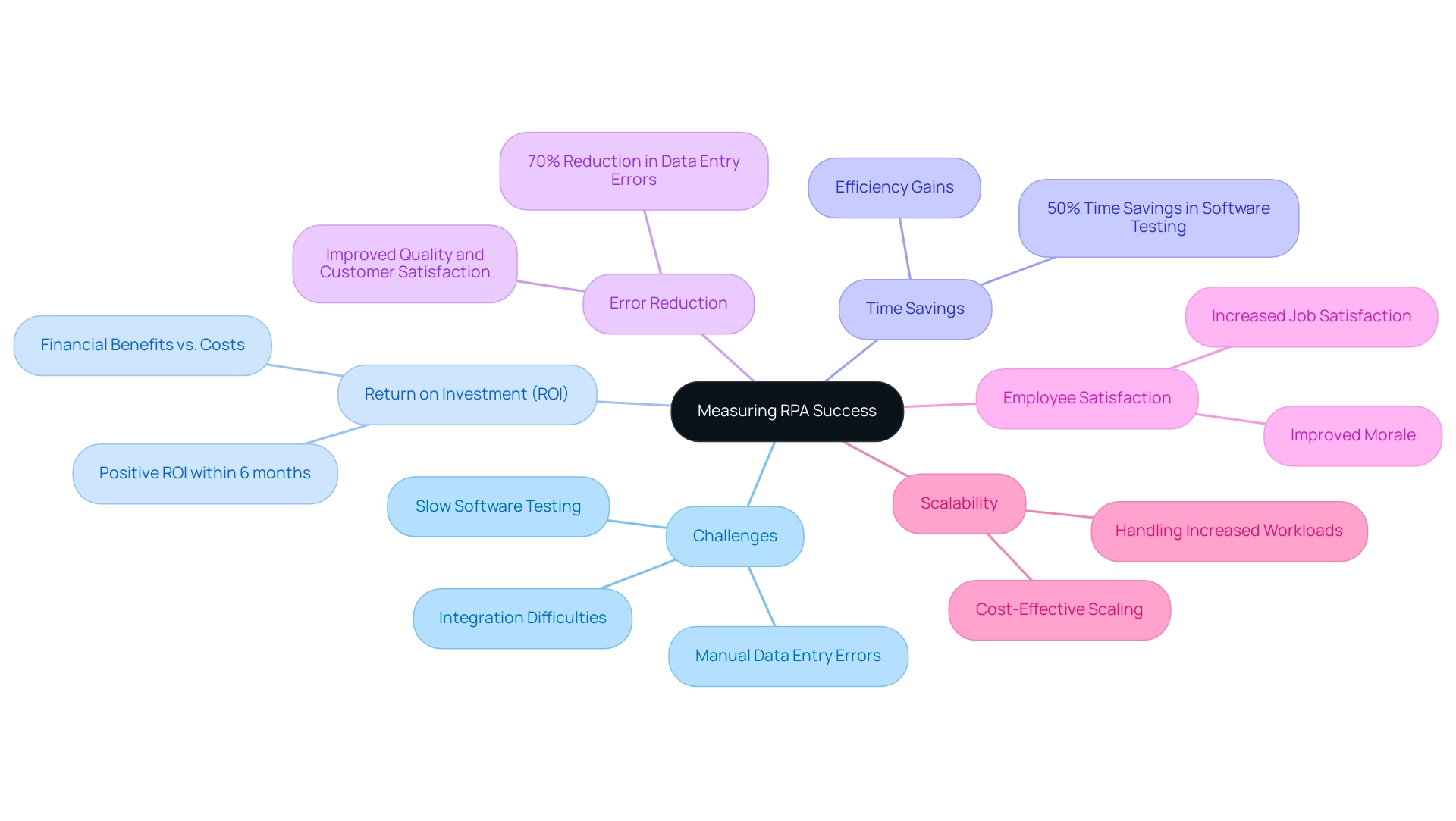
Conclusion
Robotic Process Automation (RPA) stands out as a transformative force in modern business operations, offering the ability to automate repetitive, rule-based tasks efficiently. By integrating RPA into workflows, organizations can significantly enhance productivity, reduce operational costs, and improve accuracy. Understanding the foundational components of RPA, including software bots, control centers, and analytics tools, equips businesses to streamline their processes more effectively.
Aspiring RPA developers must cultivate a blend of technical and soft skills to thrive in this evolving landscape. Proficiency in programming languages and RPA tools, alongside strong problem-solving and communication abilities, is essential for driving successful automation initiatives. The pursuit of relevant certifications further solidifies expertise in this field, opening doors to enhanced career opportunities.
Choosing the right RPA tool is a critical step that can determine the success of implementation efforts. Organizations should prioritize ease of use, integration capabilities, scalability, and available support when selecting a tool that aligns with their unique needs. A methodical approach to implementing RPA projects—starting from process identification to deployment and continuous optimization—ensures that businesses can reap the full benefits of automation.
Ultimately, measuring the success of RPA initiatives through metrics such as ROI, time savings, and employee satisfaction provides valuable insights that drive continuous improvement. By embracing RPA, organizations can not only enhance operational efficiency but also empower their workforce to focus on strategic initiatives that drive growth and innovation. The journey towards operational excellence through RPA is not just about technology; it’s about transforming the way businesses operate in an increasingly complex environment.
Introduction
In the digital age, organizations are inundated with vast amounts of data, and managing this information efficiently is paramount for success. Intelligent Document Processing (IDP) emerges as a transformative solution, harnessing the power of artificial intelligence to automate and enhance the way businesses handle documents. By streamlining data extraction, classification, and processing, IDP not only addresses the inefficiencies of traditional methods but also empowers organizations to adapt quickly to changing market demands.
This article delves into the nuances of IDP, offering insights into its benefits, key considerations for selecting the right software, and real-world applications across various industries. As companies strive for operational excellence, understanding and implementing IDP can pave the way for increased efficiency, accuracy, and ultimately, growth.
Understanding Intelligent Document Processing (IDP)
Intelligent Document Processing (IDP) represents a substantial advancement in how organizations manage their information. By utilizing the capabilities of artificial intelligence, IDP automates the extraction, classification, and processing of information from a wide variety of documents, effectively addressing the challenges presented by outdated systems that impede efficiency and innovation. This advanced technology transcends traditional processing methods reliant on manual input, utilizing machine learning and natural language processing to intelligently interpret and comprehend information. Gartner’s acknowledgment of UiPath as a frontrunner in process mining platforms in 2024 highlights IDP’s increasing importance in the sector.
Consequently, companies can skillfully manage diverse formats—from scanned images and PDFs to emails—while attaining significant improvements in accuracy and efficiency. For instance, UiPath highlights successful IDP implementations, such as:
- Future-proofing invoicing and billing processes for a UK water utility
- Transforming incoming legal operations for a major global telecom
Moreover, by integrating Business Intelligence, organizations can transform this data into actionable insights, enabling informed decision-making that drives growth and innovation. By streamlining workflows, IDP empowers businesses to pivot swiftly in response to evolving market demands, allowing them to concentrate on strategic growth initiatives. Combined with RPA tools such as EMMA RPA and Microsoft Power Automate, this method boosts productivity and employee morale, driving significant improvements while tackling the challenges of the swiftly changing AI landscape.
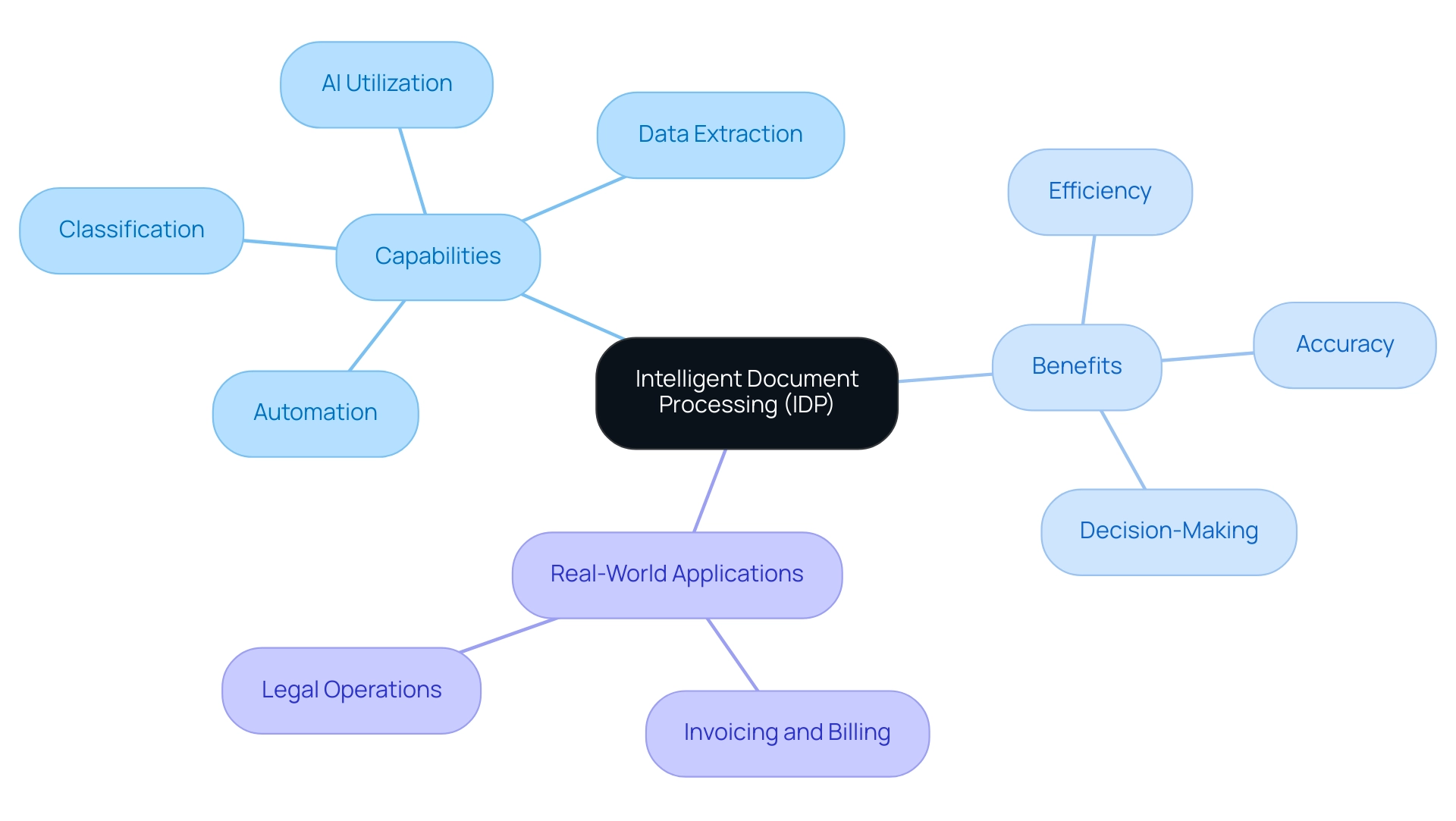
Key Considerations for Selecting IDP Software
Choosing the appropriate Intelligent Document Processing (IDP) software is a crucial decision that can greatly influence your efficiency. Here are key factors to consider in 2024:
- Scalability: Choose a solution that can adapt and grow in tandem with your business needs, ensuring it remains effective as your operations expand.
- Integration: It’s essential to select software that seamlessly integrates with your current systems and workflows, minimizing disruption and enhancing efficiency right from the start. Leveraging Robotic Process Automation (RPA) in conjunction with your IDP can further streamline these processes.
- User Experience: Opt for software that features an intuitive interface. This will reduce the time and resources needed for training, allowing your team to become productive quickly.
- Information Security: Considering the sensitive nature of the information processed, it’s critical to thoroughly evaluate the security measures the software employs to protect your information.
- Vendor Support: Assess the level of support provided by the vendor, which is crucial for successful implementation and ongoing troubleshooting.
Additionally, consider the recent launch of the Intelligent Document Processing Vendor Directory, which offers easy access to various IDP solutions, helping you make informed choices by providing insights into how these solutions can address specific challenges in the evolving AI landscape.
As Jim Chase, Executive Chairman at Celaton, states, ‘Celaton naturally aligns with ADVT’s focus of empowering customers by streamlining complexities, automating repetitive tasks, and ultimately enhancing productivity, compliance, and engagement.’ This highlights the significance of choosing software that not only satisfies immediate requirements but also aids in achieving long-term objectives.
Furthermore, leveraging tailored AI solutions and Business Intelligence is essential for transforming raw data into actionable insights, enabling informed decision-making that drives growth and innovation. The recognition of ABBYY, Mindee, and Evolution AI at the 2024 AI Breakthrough Awards highlights successful integration of IDP solutions, providing real-world examples of excellence in the field.
By leveraging RPA, tailored AI solutions, and Business Intelligence along with these considerations, you can identify an IDP solution that not only meets your immediate functional requirements but also positions your organization for future success in a rapidly evolving digital landscape.
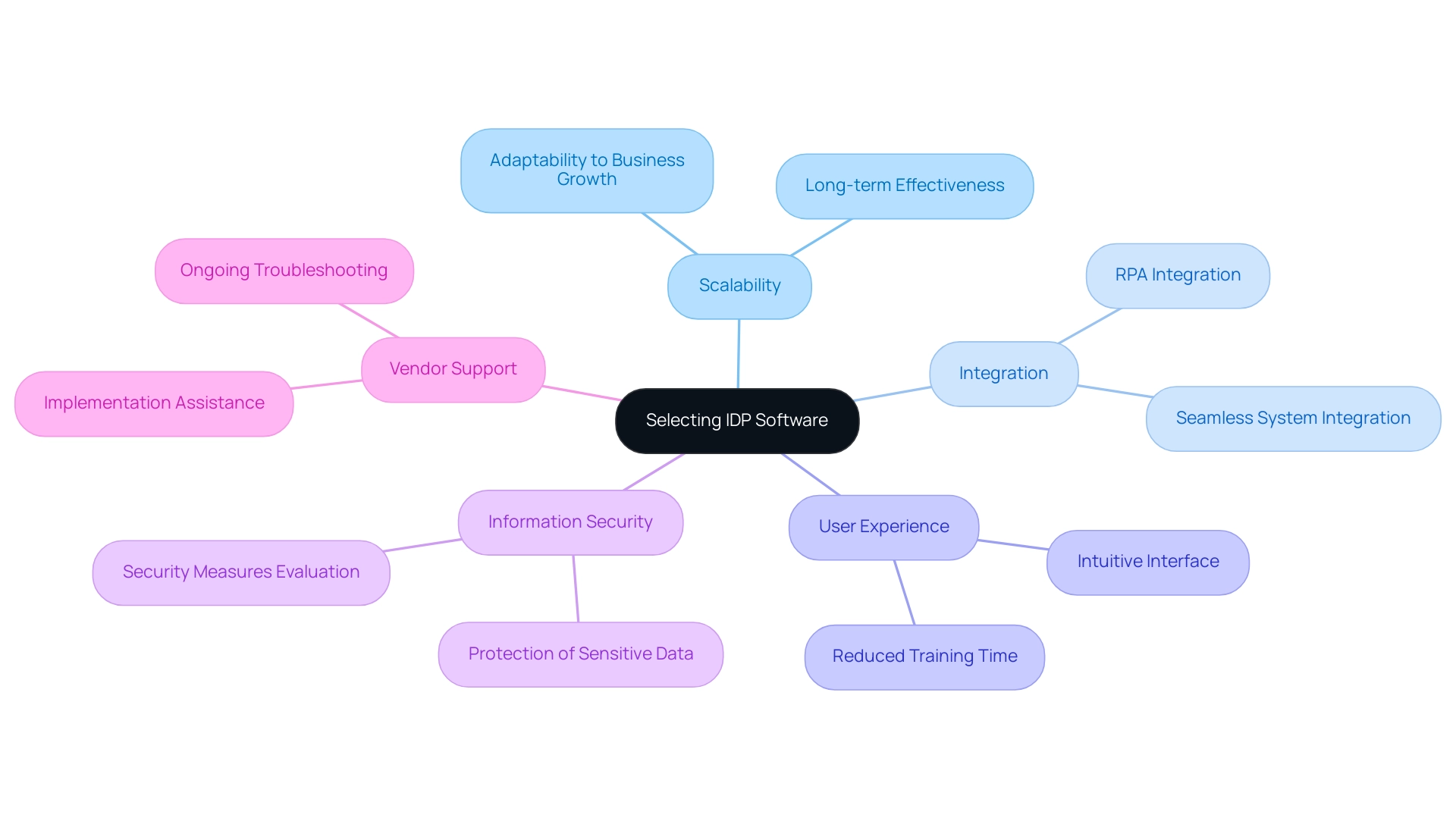
Benefits of Implementing Intelligent Document Processing
Implementing Intelligent Document Processing (IDP) offers a myriad of advantages that can significantly transform operational workflows. Key benefits include:
-
Increased Efficiency: Automation of document handling drastically reduces the time spent on manual information entry and processing tasks. For instance, entities that have adopted IDP report an average efficiency gain of 30-50%, enabling them to manage growing document volumes more effectively. This aligns with the outcomes from recent case studies where implementing Robotic Process Automation (RPA) and GUI automation led to an 80% improvement in workflow efficiency.
-
Enhanced Accuracy: AI-driven solutions are crafted to reduce human mistakes, ensuring that quality is consistently high. This accuracy is vital for making informed decisions based on reliable information. According to industry experts, organizations utilizing IDP encounter a 90% reduction in entry errors, significantly enhancing decision-making processes.
-
Cost Savings: Streamlining workflows through IDP leads to substantial reductions in operational costs associated with document management. A recent case study showed that a financial institution saved over $200,000 annually after implementing IDP solutions, allowing them to allocate resources more effectively and achieve greater returns on investment. Likewise, a mid-sized firm adopting GUI automation decreased entry mistakes by 70% and sped up testing procedures by 50%, showcasing the financial advantages of automation.
-
Better Compliance: IDP systems aid in upholding adherence to various regulatory requirements by providing comprehensive audit trails and secure information handling processes. This capability is increasingly critical in today’s regulated business environment.
-
Scalability: As companies expand, IDP systems can seamlessly adapt to handle increased document volumes without the need for significant additional resources, ensuring that operational efficiency is maintained.
However, entities often encounter challenges such as manual information entry errors, slow processing times, and difficulties in managing large volumes of documents before implementing IDP solutions. Embracing IDP not only enhances productivity but also positions organizations to navigate the complexities of modern document management with confidence, particularly in the rapidly evolving AI landscape.
As stated, Intelligent Document Processing (IDP) represents a groundbreaking approach to document management, utilizing advanced technologies to simplify the extraction and handling of information. This innovative technology is particularly relevant in the rapidly expanding IDP market, where sectors such as Banking, Financial Services, and Insurance (BFSI) are expected to account for over 30% of the total IDP market by 2025. Furthermore, integrating tailored AI solutions can further enhance the effectiveness of IDP by providing targeted insights and analytics that drive informed decision-making.
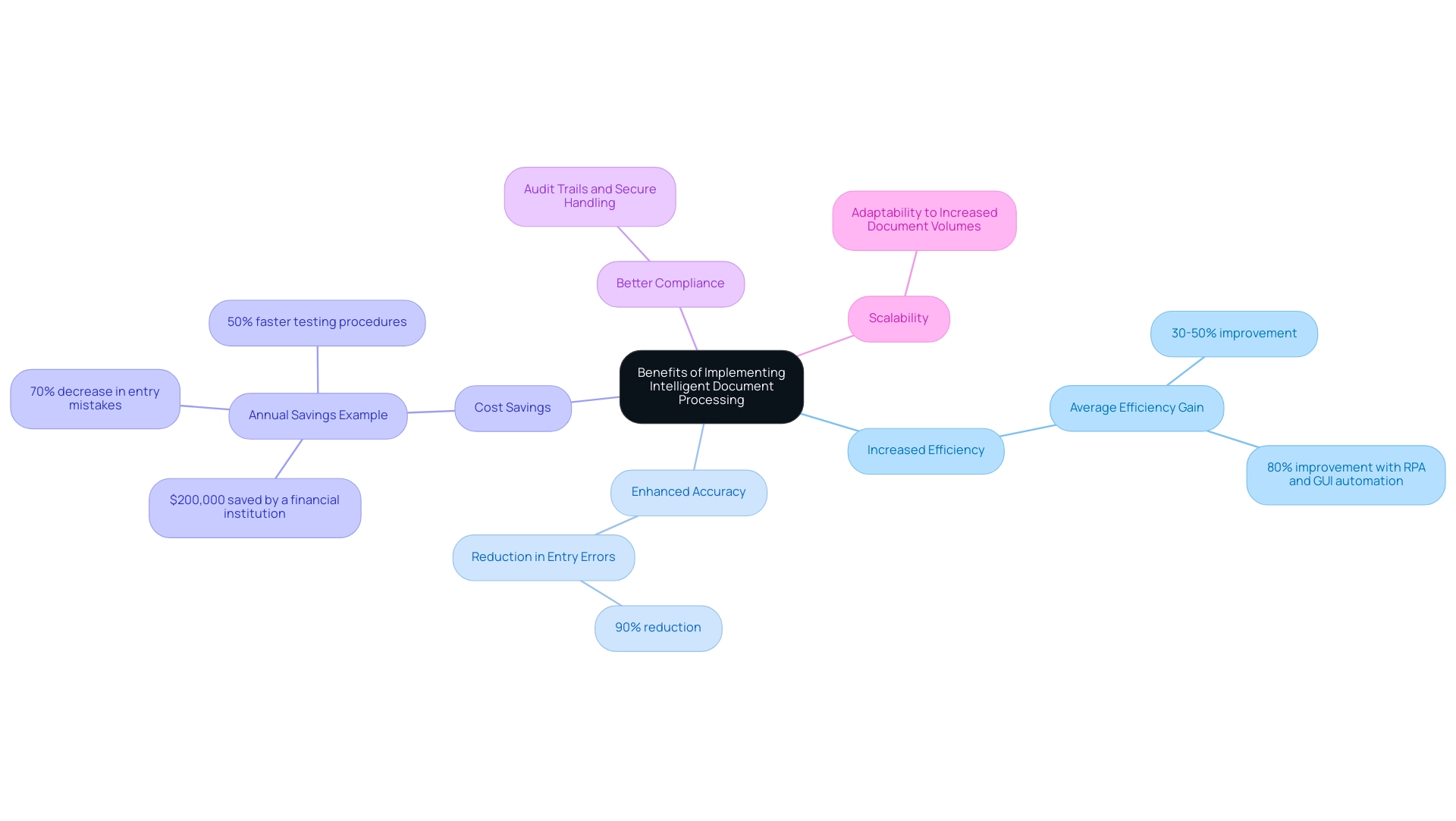
IDP vs. Traditional Document Processing: Key Differences
Understanding the distinctions between Intelligent Document Processing (IDP) and traditional document processing is crucial for transforming operational efficiency through automation. Key differences include:
-
Automation: IDP excels in automating information extraction and classification, significantly reducing the manual intervention that characterizes traditional methods. With industry reports projecting automation rates in document processing to reach 75% by 2024, organizations can increasingly rely on IDP technologies. This capability not only accelerates processing times but also minimizes human error, fostering more reliable information management and enhancing employee morale. Moreover, when integrated with RPA tools like EMMA RPA and Microsoft Power Automate, IDP can further streamline workflows and boost overall operational efficiency.
-
Flexibility: Unlike traditional systems that struggle with unstructured information, IDP is designed to seamlessly handle various document types and formats. This adaptability ensures that entities can manage diverse information sources without extensive reconfiguration, making it an ideal solution in a rapidly evolving AI landscape.
-
Learning Capabilities: One standout feature of IDP is its machine learning capability, enabling the system to evolve and improve its processing over time. This contrasts sharply with traditional systems, which are often static and unable to adapt to new document types or changing business requirements, thereby stifling innovation.
-
Integration: IDP solutions are engineered for seamless integration with other technological platforms, enhancing workflow efficiency. In contrast, traditional systems frequently operate in silos, complicating information flow and reducing overall productivity. This integration is essential for entities looking to modernize outdated systems and improve data quality.
As mentioned by a sector specialist, “The capacity of IDP to adjust and incorporate is a game changer for entities seeking to improve their efficiency in operations.” These differences emphasize the functional advantages of IDP and underscore its role in supporting emergency response efforts by streamlining information processing during crises. For example, a case study on fraud detection in the public sector illustrates how IDP analyzes documents for inconsistencies, leading to enhanced fraud detection in areas like tax administration. Additionally, by utilizing IDP alongside RPA, organizations can ensure that they are not only improving efficiency but also gaining actionable insights that drive informed decision-making.

Real-World Applications of Intelligent Document Processing
Intelligent Document Processing (IDP) is making significant strides in enhancing operational efficiency across multiple sectors, particularly in healthcare. Here are some compelling applications:
-
Finance:
Financial institutions are increasingly adopting IDP to automate loan application processing, reducing turnaround times and significantly boosting customer satisfaction. For instance, Cox Automotive has successfully integrated systems from over 20 acquired companies using APIs, showcasing the power of streamlined processes, which has led to a 2.5x increase in project delivery speed. -
Healthcare:
In the healthcare sector, hospitals are leveraging IDP to efficiently manage patient records, facilitating swift access to critical information essential for timely care. The execution of GUI automation has tackled challenges such as manual input errors and slow software testing, resulting in a 70% decrease in entry mistakes and an 80% enhancement in workflow efficiency. Dr. Jane Smith, a healthcare expert, states, ‘The implementation of IDP in healthcare is a game-changer, allowing for more accurate data management and improved patient outcomes.’ -
Legal:
Law firms are utilizing IDP to expedite contract review processes. By automating this traditionally labor-intensive task, attorneys can focus on strategic initiatives rather than mundane paperwork. -
Insurance:
Insurance firms gain from IDP by handling claims at a significantly quicker pace, improving service delivery while simultaneously lowering costs. For example, the rapid launch of an IT structure by Sumitomo achieved in just six weeks exemplifies the advancements in document management with zero end-user interruption. Additionally, ASICS has launched a new eCommerce platform in just six months, reusing APIs to deliver IT projects 2.5x faster, further demonstrating the effectiveness of IDP.
These real-world applications emphasize IDP’s potential to transform document processing, enhancing efficiency and preparing entities for future growth. Furthermore, organizations often face challenges such as employee exhaustion from repetitive tasks, difficulties in attracting talent, and outdated systems that hinder innovation. By implementing IDP, these challenges can be mitigated, leading to improved operational outcomes and a significant ROI within six months.
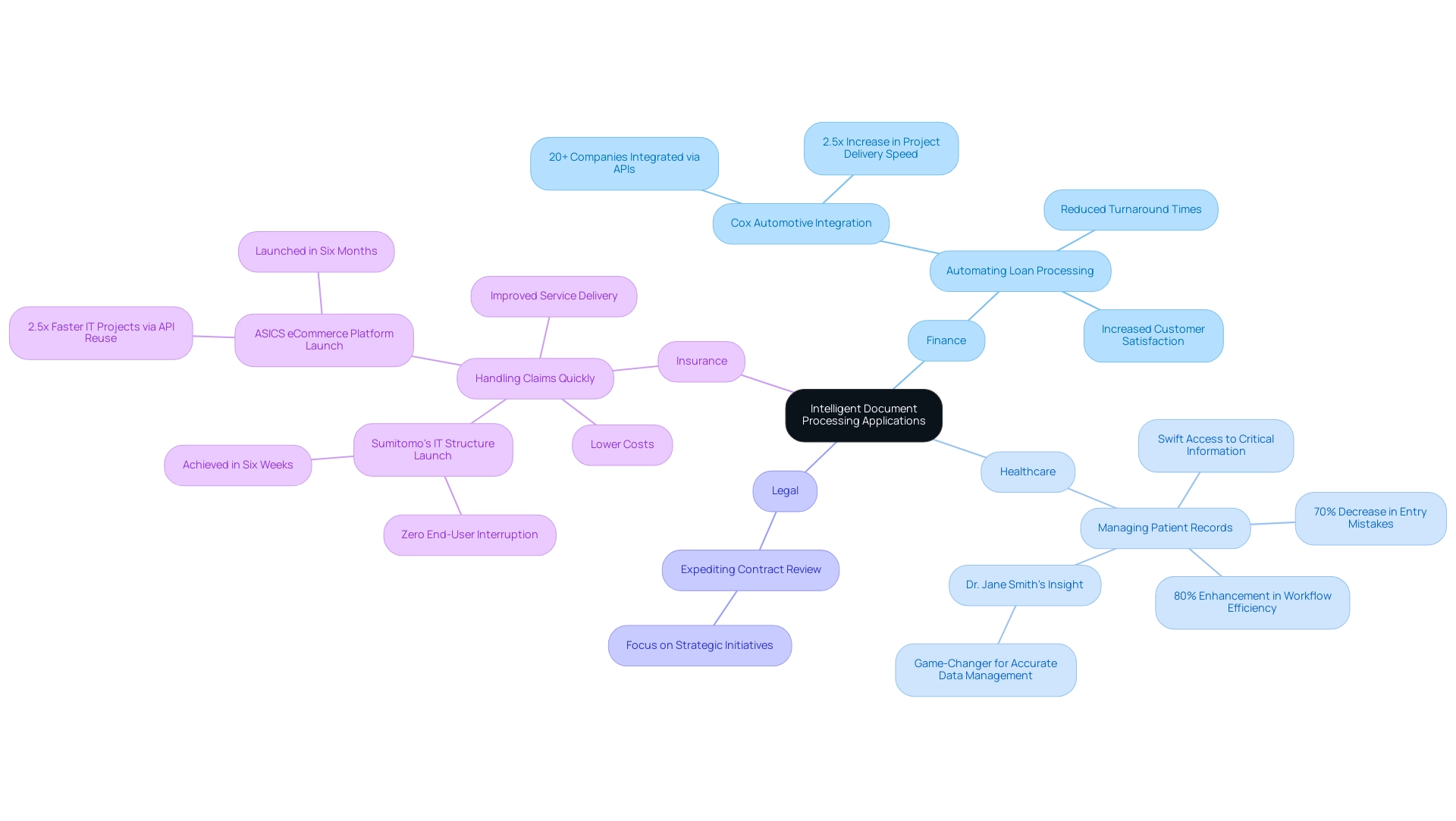
Conclusion
The implementation of Intelligent Document Processing (IDP) stands as a pivotal advancement for organizations navigating the complexities of the digital age. By automating the extraction, classification, and management of documents, IDP not only enhances operational efficiency but also significantly reduces the risk of human error. As highlighted, businesses leveraging IDP have reported substantial improvements in processing times and accuracy, which ultimately fosters better decision-making and compliance with regulatory standards.
Selecting the right IDP software is crucial, with considerations such as scalability, integration, user experience, data security, and vendor support playing a vital role in ensuring long-term success. The advancements in IDP technologies, coupled with the integration of Robotic Process Automation (RPA) and tailored AI solutions, create a powerful synergy that empowers organizations to streamline workflows and adapt to evolving market demands.
Real-world applications across various sectors, including finance, healthcare, legal, and insurance, demonstrate the transformative potential of IDP. By tackling traditional inefficiencies, IDP not only enhances productivity but also positions organizations to thrive in an increasingly competitive landscape. As the demand for agility and accuracy in document management continues to grow, embracing IDP can pave the way for sustainable growth and operational excellence.
Organizations that invest in this innovative technology will not only improve their current processes but also set a solid foundation for future advancements in their operations.
Introduction
In a world where efficiency is paramount, keystroke automation emerges as a transformative solution for organizations seeking to streamline operations and enhance productivity. By automating repetitive tasks that once consumed valuable time and resources, businesses can empower their teams to focus on strategic initiatives that drive growth. This article delves into the multifaceted benefits of keystroke automation, exploring its applications across various industries and the challenges organizations may face during implementation.
With the rise of advanced technologies like Robotic Process Automation (RPA) and artificial intelligence, the future of keystroke automation promises even greater innovations, enabling companies to remain competitive in an ever-evolving landscape. Discover how embracing these solutions can not only alleviate operational burdens but also foster a more engaged and motivated workforce.
Defining Keystroke Automation: An Overview
Keystroke mechanization is a powerful instrument that employs software to streamline repetitive activities involving keyboard inputs. By imitating human typing and mouse actions, this technology performs activities without manual involvement, effectively optimizing procedures such as data entry and form completion.
As an essential component of Robotic Process Automation (RPA), keystroke control plays a vital role in improving operational efficiency and tackling workplace issues such as:
- Repetition fatigue
- Staffing shortages
- Obsolete systems
With innovative solutions like EMMA RPA and Microsoft Power Automate, organizations can significantly reduce human error and empower their teams to focus on more strategic, value-adding work, thereby boosting employee morale and overall productivity. By leveraging these tools, businesses can transform their operations, ensuring they remain competitive in a rapidly evolving landscape.

The Benefits of Keystroke Automation in Everyday Tasks
The implementation of GUI operation, as shown in our recent case study, provides numerous advantages that significantly change everyday tasks. Not only does it dramatically reduce the time spent on repetitive activities, allowing employees to focus on more strategic initiatives, but it also enhances operational efficiency in critical sectors like healthcare.
For instance, automating data entry has proven to save hours each week, leading to a remarkable increase in productivity, with a reported 70% reduction in data entry errors. Furthermore, GUI control reduces the risk of human error, ensuring data accuracy and reliability—an essential factor in industries where precision is paramount.
The challenges of manual data entry mistakes and sluggish software testing encountered by the mid-sized company were effectively tackled through mechanization. By freeing team members from mundane tasks, organizations can cultivate a more engaging work environment that encourages creativity and innovation.
Overall, the advantages of GUI systems, alongside Robotic Process Automation (RPA), which contributed to an 80% improvement in workflow efficiency, not only streamline operations but also empower a more efficient and motivated workforce, ultimately driving informed decision-making through better insights.
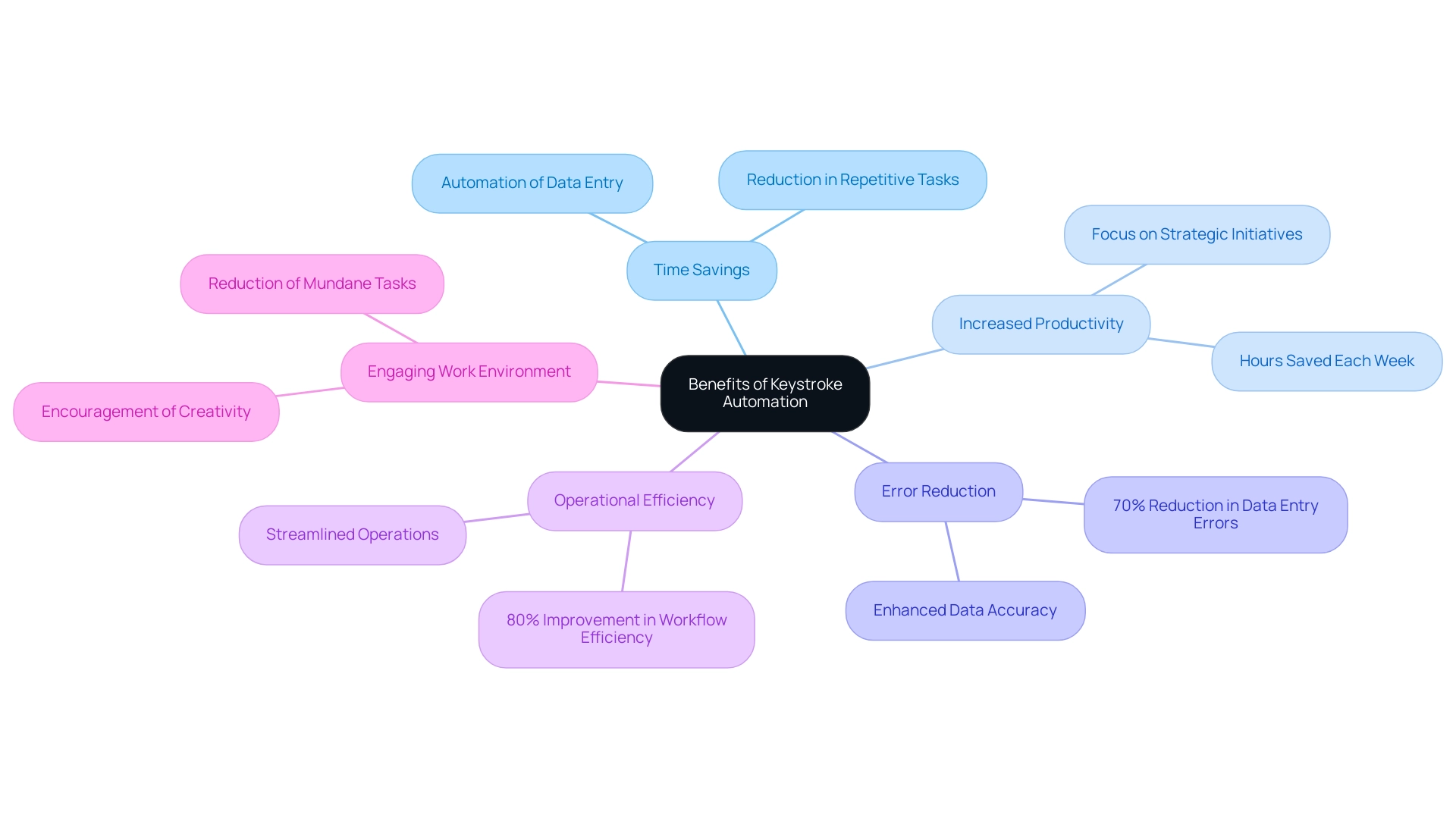
Common Applications of Keystroke Automation
Keystroke control can be utilized in various situations across different sectors to tackle workplace challenges effectively. For instance, in data entry, organizations can automate the transfer of information from emails to databases, significantly reducing the time required for manual input and alleviating employee frustration.
In customer support, input streamlining simplifies ticketing systems by automatically entering customer information based on prior interactions, improving service efficiency. Furthermore, in financial services, typing assistance streamlines the handling of transactions and reporting, enabling quicker turnaround times.
Outdated systems can hinder these processes, causing inefficiencies and errors that impact overall productivity. By recognizing particular repetitive and time-intensive activities, organizations can customize input processes to update their operations and address their distinct operational requirements.
This not only boosts productivity but also helps attract and retain valuable talent in an increasingly competitive landscape, as employees are less burdened by mundane tasks and can focus on more strategic work.
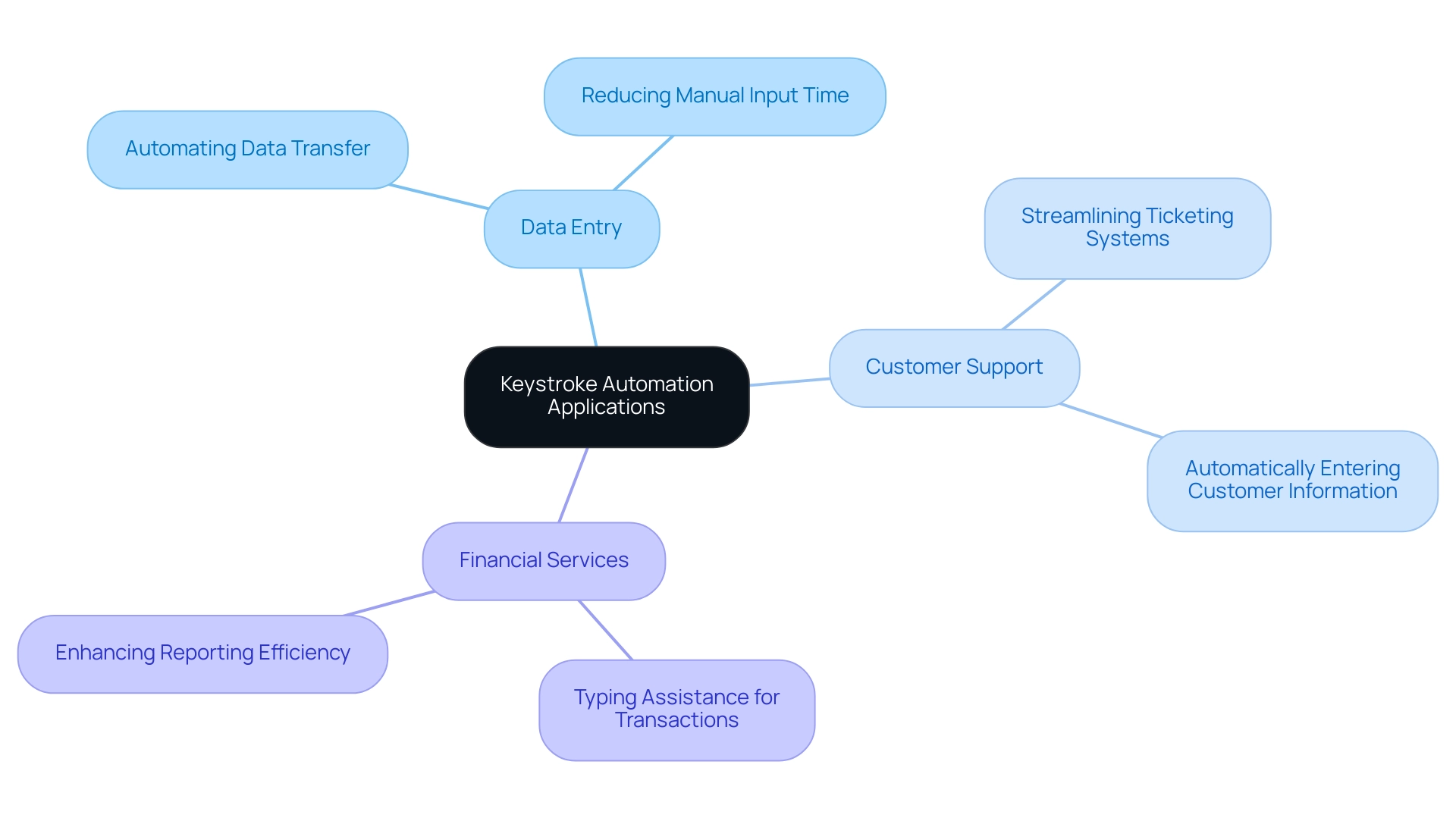
Challenges and Considerations in Implementing Keystroke Automation
While keystroke programming offers significant advantages, organizations may encounter challenges during implementation. Common issues include:
- Employee resistance stemming from fears of job displacement or reluctance to adapt to new technologies.
To effectively address these concerns, it is vital to cultivate a culture of collaboration and communication, emphasizing that technological advancements are designed to enhance job roles, not replace them. Organizations can leverage our GenAI workshops to provide hands-on training, ensuring employees are equipped to utilize AI-powered tools effectively.
Furthermore, selecting software that smoothly integrates with current systems is essential. For example, implementing RPA can streamline workflows by automating repetitive tasks, thereby enhancing operational efficiency.
By proactively addressing these challenges and utilizing our tailored GPT creation services, organizations can enable a smoother transition to RPA and GUI processes, ultimately enhancing productivity.

Future Trends in Keystroke Automation
The future of keystroke efficiency is poised for significant advancements as technology continues to evolve. Emerging trends, such as the integration of Robotic Process Automation (RPA), artificial intelligence, and machine learning, are set to enhance the capabilities of robotic tools.
For instance, AI-driven systems can learn from user behavior to optimize processes further, making them more intuitive and efficient. This is particularly valuable in today’s data-rich environment, where extracting actionable insights is crucial for informed decision-making.
RPA not only streamlines workflows but also reduces errors, allowing teams to focus on more strategic, value-adding tasks. Furthermore, as organizations progressively embrace remote work models, the demand for solutions that support virtual environments will expand.
This shift will drive innovation in keystroke technology, allowing for more seamless integration with cloud-based applications and remote workflows. By leveraging RPA and utilizing Business Intelligence to transform raw data into actionable insights, organizations can position themselves to fully harness the potential of automation in the future, enhancing operational efficiency and driving productivity.

Conclusion
Embracing keystroke automation is a strategic decision that can profoundly transform organizational operations. By automating repetitive tasks, businesses not only improve efficiency but also empower their workforce to engage in more strategic and fulfilling work. The benefits are clear: from significantly reducing data entry errors to enhancing productivity across various sectors, keystroke automation is a powerful ally in the quest for operational excellence.
However, it is essential to navigate the challenges of implementation with care. Addressing employee concerns and ensuring seamless integration with existing systems are critical steps in fostering a culture that embraces automation. By investing in training and communication, organizations can alleviate fears and demonstrate that automation serves to enhance roles rather than replace them.
Looking ahead, the future of keystroke automation is bright, driven by advancements in artificial intelligence and machine learning. These technologies promise to refine automation processes, making them even more effective and intuitive. As businesses adapt to changing work environments and seek innovative solutions, keystroke automation will play an integral role in maintaining competitiveness and achieving sustainable growth.
By prioritizing these advancements, organizations can unlock new levels of productivity and operational efficiency, setting the stage for success in an increasingly dynamic landscape.
Introduction
In the dynamic landscape of Big Data, organizations are presented with a wealth of opportunities to enhance their operational efficiency through analytics. By understanding the four distinct types—Descriptive, Diagnostic, Predictive, and Prescriptive—businesses can transform raw data into actionable insights that drive strategic decision-making. Each type serves a unique purpose: from summarizing historical trends to predicting future outcomes and recommending specific actions.
As companies navigate the complexities of data, leveraging these analytics effectively can not only address existing challenges but also empower them to innovate and thrive in an increasingly competitive environment. This exploration delves into how organizations can harness the power of analytics to unlock their full potential.
Overview of the Four Types of Analytics in Big Data
In the realm of Big Data, analysis can be categorized into four distinct types: Descriptive, Diagnostic, Predictive, and Prescriptive. Each type plays a crucial role in assisting organizations to interpret information and make informed decisions, thus enhancing operational efficiency and addressing implementation challenges.
- Descriptive Analysis emphasizes summarizing past information to comprehend what has occurred, which is crucial in navigating the overwhelming AI landscape. For instance, a retail company might use descriptive analytics to examine past sales information to identify trends.
- Diagnostic Examination explores further to reveal the reasons behind previous results, offering valuable insights that guide future strategies; a financial institution may assess customer transaction information to ascertain why certain accounts are inactive.
- Predictive Analysis employs statistical models to forecast future events, enabling businesses to anticipate challenges and customize AI solutions accordingly, such as predicting customer churn.
- Prescriptive Analytics advances by suggesting actions based on insights, enabling decision-makers to foster growth and innovation. For instance, a logistics firm could utilize prescriptive analytics to enhance delivery routes based on real-time traffic information.
Comprehending these categories is essential for any entity aiming to utilize the potential of Big Information effectively, employing BI and RPA to convert information into actionable insights, overcome operational challenges, and tackle the significant issue of insufficient insight-driven analysis.
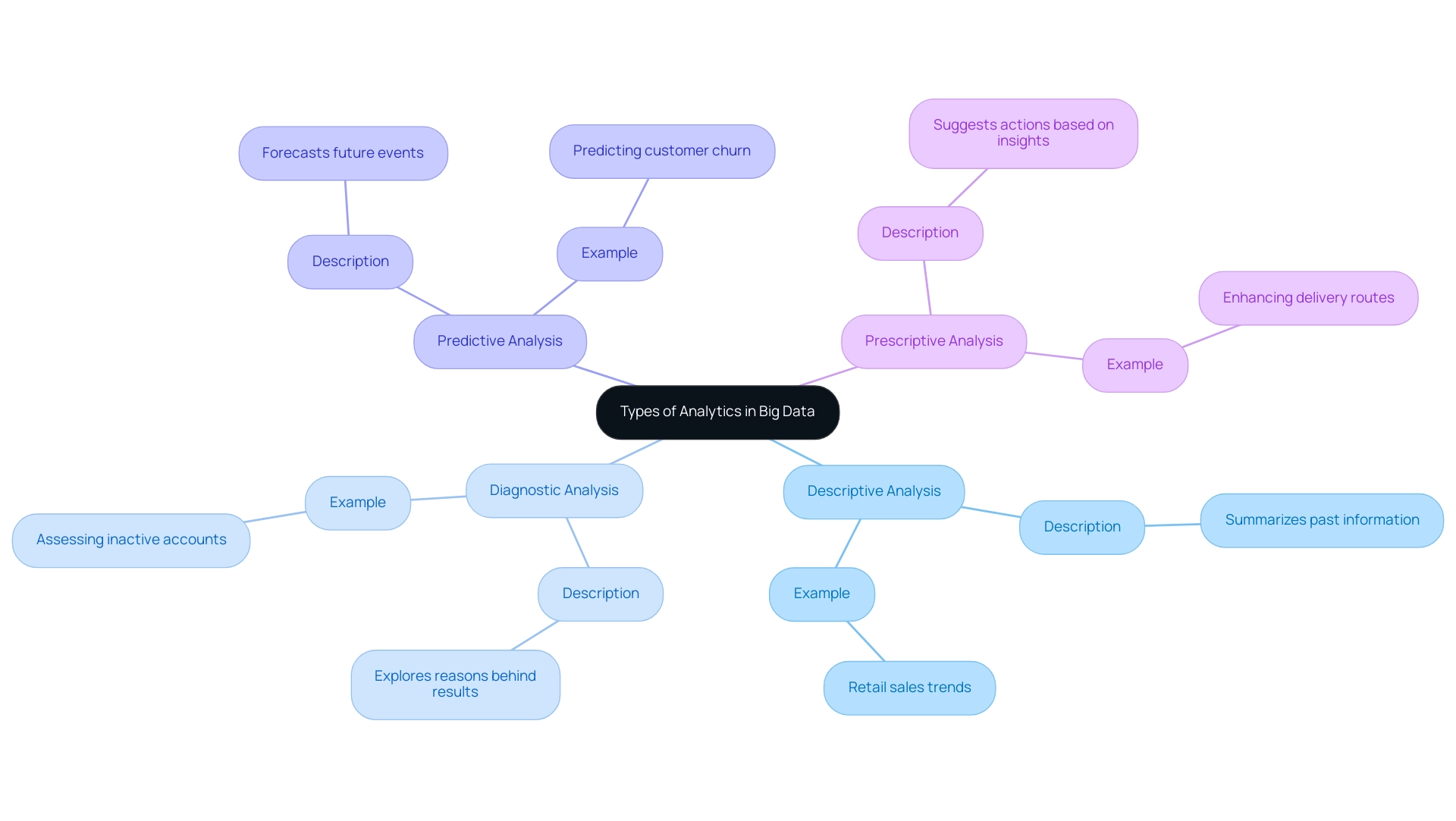
Understanding Descriptive Analytics: Purpose and Real-Life Examples
Descriptive analysis aims to summarize previous information through visual representations and reports, assisting entities in grasping trends and patterns essential for operational efficiency. For example, a retail company might leverage Descriptive Analytics to analyze sales information from the previous year, identifying peak shopping seasons that inform inventory management and marketing strategies. In the healthcare sector, a hospital could track patient admission rates to pinpoint busy periods, thereby enabling effective resource allocation and staffing.
However, entities often encounter challenges such as:
- Time-consuming report generation
- Inconsistencies
- A lack of actionable guidance from their insights
By integrating RPA solutions, entities can simplify the report creation process and ensure information consistency, thereby transforming historical performance into strategic actions. Furthermore, customized AI solutions can improve the use of Descriptive Insights, allowing entities to manage their information challenges more effectively. By effectively harnessing Descriptive Analytics within a robust Business Intelligence framework, companies can drive growth and innovation.
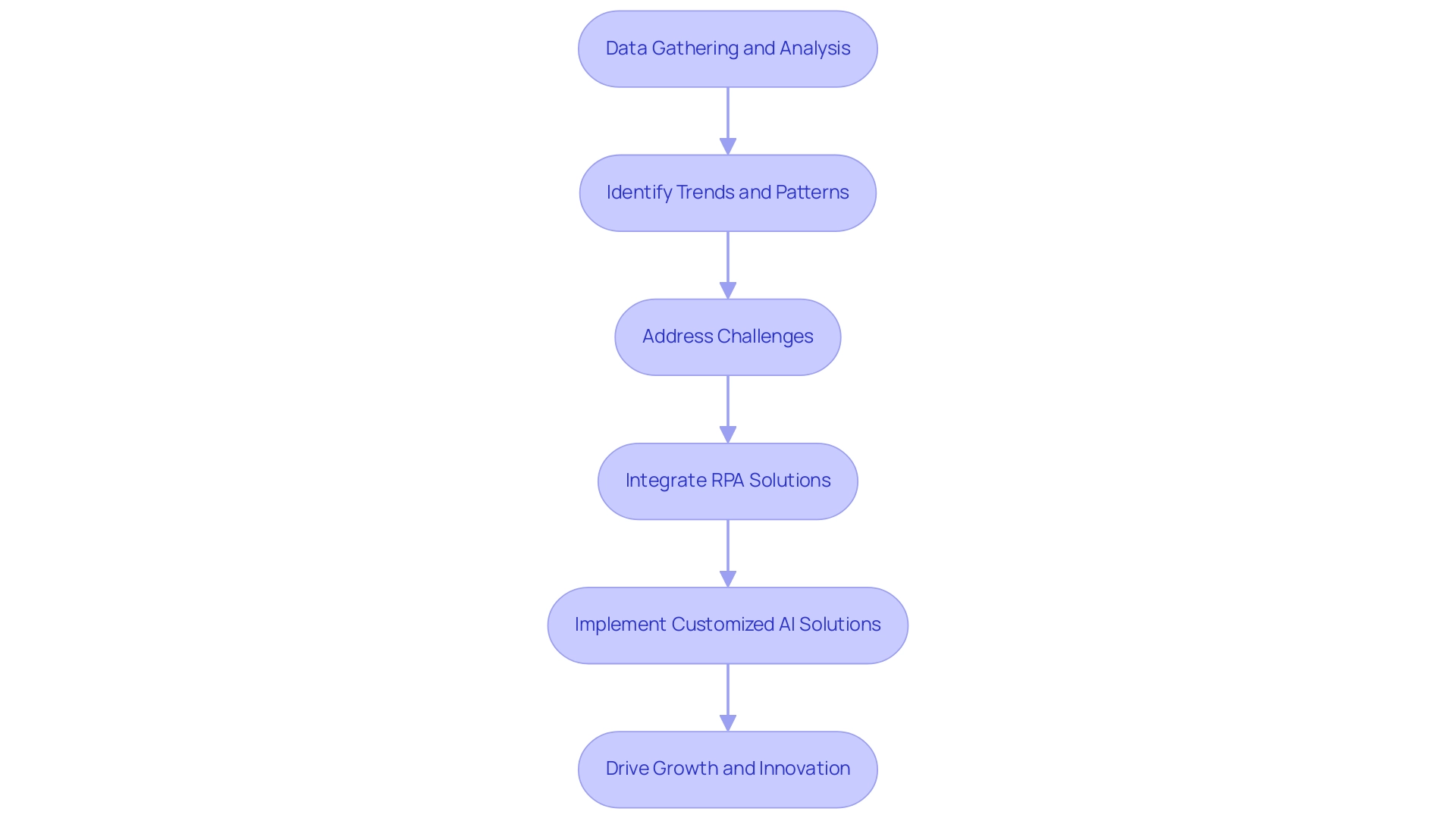
Exploring Diagnostic Analytics: Insights into Past Performance
Diagnostic analysis functions as a robust instrument for organizations aiming to explore historical information and reveal the elements behind specific results, especially regarding operational efficiency. A recent case study from a mid-sized company illustrates how GUI automation significantly enhanced their workflow by addressing challenges such as:
- Manual information entry errors
- Slow software testing
- The integration of outdated systems without APIs
By utilizing RPA and diagnostic analysis, this company decreased information entry mistakes by 70%, hastened testing procedures by 50%, and enhanced workflow effectiveness by 80%. The ROI was achieved within 6 months, aligning with findings from the McKinsey Global Institute, which estimates that Big Data could generate up to $3 trillion in value per year.
This case exemplifies how businesses can correlate diverse datasets—like production line metrics and employee shift patterns—to pinpoint root causes of inefficiencies. As Brittany Jaros aptly states, ‘Your Information Won’t Speak Unless You Ask It the Right Questions,’ underscoring the need for a focused approach in analysis.
Furthermore, this method has been successfully applied to evaluate social media campaigns by correlating daily sales with engagement metrics, enabling businesses to assess the impact of their strategies. Ultimately, harnessing diagnostic analytics empowers entities to enhance operational efficiency and drive growth through informed, data-driven decisions, particularly in the healthcare service delivery sector.
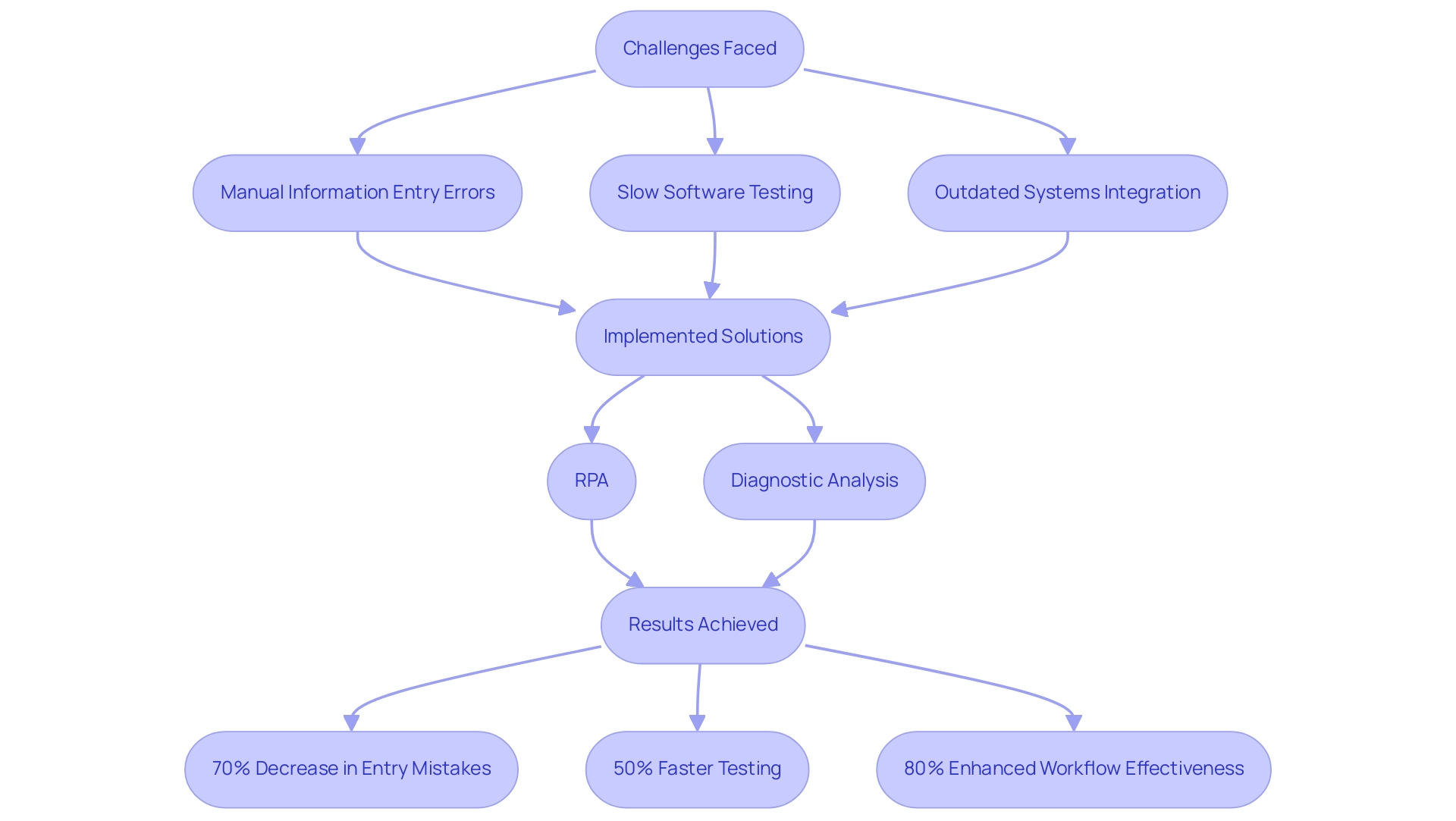
Predictive Analytics: Forecasting Future Trends with Data
Predictive Analytics utilizes historical information and statistical algorithms to forecast future outcomes. For instance, an e-commerce business may analyze customer buying patterns to predict future purchases during upcoming sales events.
With tools like Power BI, companies can create custom dashboards that provide real-time insights, empowering them to optimize inventory levels and tailor marketing campaigns to target specific customer segments.
Our General Management App integrates with Microsoft Copilot to facilitate insightful reviews, ensuring that decision-makers have the necessary tools at their disposal.
Moreover, our GenAI Workshops and Small Language Models improve the predictive assessment capabilities by offering customized AI solutions for effective information analysis.
Predictive Insights empowers organizations to anticipate changes in the market and adapt their strategies accordingly, enhancing their competitive edge while benefiting from seamless information integration, RPA solutions to automate repetitive tasks, and expert training to maximize analytical capabilities.
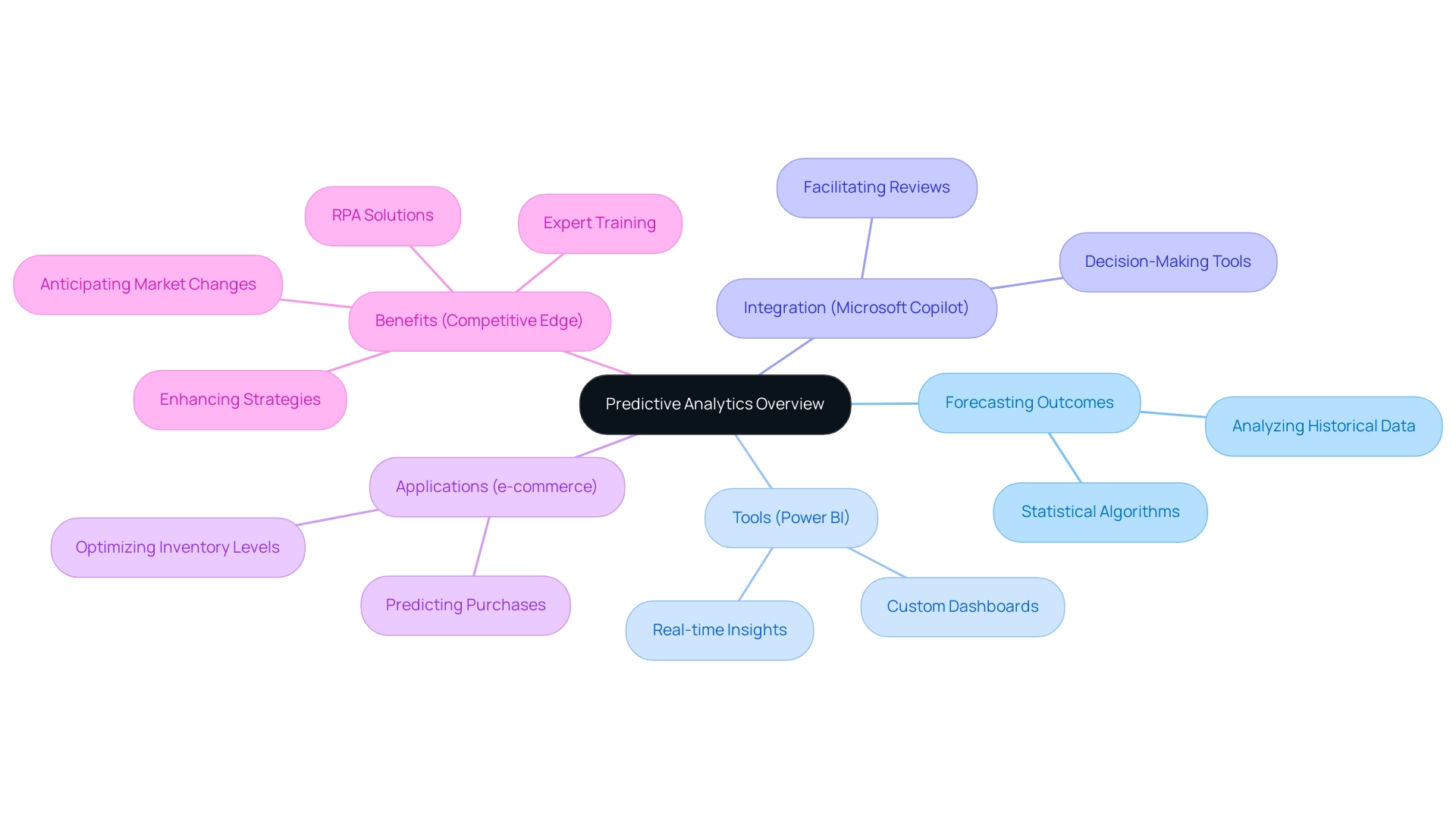
Prescriptive Analytics: Guiding Decision-Making through Data Insights
Prescriptive Analysis goes beyond forecasting to suggest specific actions based on information insights. For example, a logistics firm may employ Prescriptive Analytics to identify the most efficient delivery routes, incorporating real-time traffic information and historical delivery durations. By implementing these actionable recommendations, the company can not only reduce transportation costs but also enhance service levels.
This form of analysis, particularly when paired with Creatum’s 3-Day Power BI Sprint, which guarantees a refined, fully operational report that can act as a template for future projects, enables organizations to comprehend not only what is probable to occur but also the strategic measures to adopt in reaction.
Furthermore, integrating Robotic Process Automation (RPA) can streamline these workflows, reducing manual tasks and enhancing operational efficiency. For example, RPA can automate data entry processes, allowing teams to focus on analyzing insights rather than managing data. This makes analytics an invaluable tool for driving business growth and innovation.
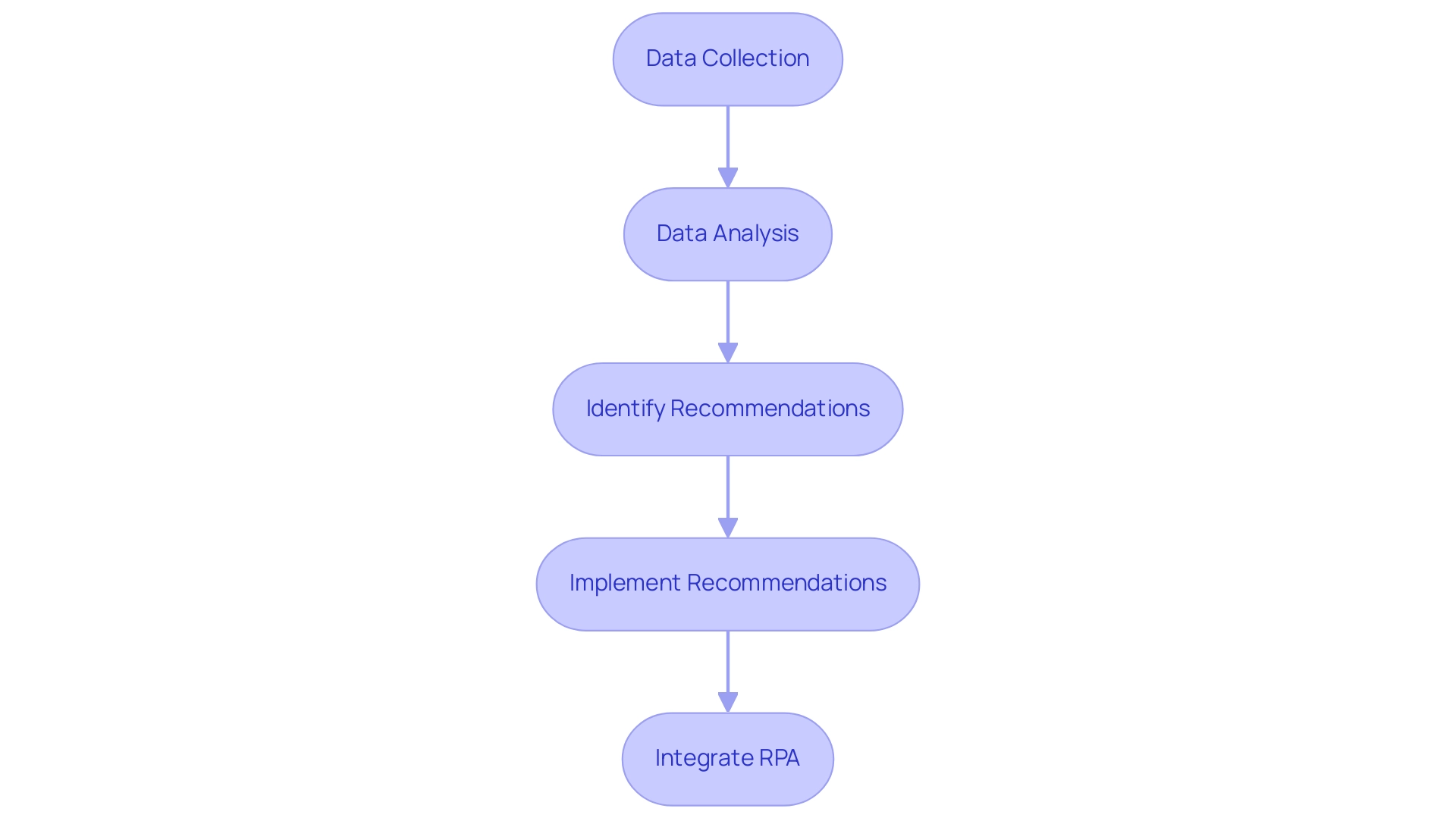
Conclusion
Harnessing the power of analytics in the realm of Big Data is essential for organizations aiming to enhance their operational efficiency and drive strategic decision-making. Each of the four types of analytics—Descriptive, Diagnostic, Predictive, and Prescriptive—serves a distinct purpose that collectively empowers businesses to transform raw data into actionable insights. Descriptive Analytics provides a comprehensive view of historical trends, while Diagnostic Analytics uncovers the reasons behind those trends, enabling organizations to learn from past performance.
Predictive Analytics takes this further by forecasting future outcomes, allowing companies to anticipate market shifts and adapt their strategies proactively. Finally, Prescriptive Analytics offers specific recommendations, guiding decision-makers towards the most effective actions based on data insights. By integrating these analytics into their operations, organizations can not only address existing challenges but also unlock innovative solutions that propel growth and efficiency.
In an increasingly competitive landscape, the ability to leverage analytics effectively is not just an advantage; it is a necessity. Embracing these analytical approaches will enable organizations to navigate complexities, make informed decisions, and thrive in their respective industries. The journey toward data-driven excellence begins with understanding and implementing these powerful tools, ultimately leading to a more resilient and successful future.
Introduction
In the dynamic landscape of modern business, the integration of Control Room Automation Anywhere is transforming operational efficiency. This innovative platform harnesses the power of robotic process automation (RPA), artificial intelligence, and advanced analytics to streamline workflows, reduce manual errors, and empower organizations to focus on strategic objectives. As industries increasingly adopt these technologies, they are witnessing remarkable improvements in productivity and cost-effectiveness.
However, the journey toward successful implementation is not without its challenges, including employee resistance and integration hurdles. By addressing these issues head-on and embracing a culture of collaboration and training, organizations can unlock the full potential of automation, paving the way for a future where efficiency and innovation go hand in hand. As 2024 approaches, the imperative to adapt and leverage these advancements becomes clearer, positioning businesses to thrive in an ever-evolving environment.
Understanding Control Room Automation Anywhere
Control Room Technology Anywhere signifies a state-of-the-art solution designed to improve operations within control room settings. This strong platform effortlessly combines robotic process technology with advanced analytics and artificial intelligence, enabling entities to optimize their processes, improve decision-making, and enhance overall operational efficiency. With the ability to automate routine tasks, including those managed by innovative tools like EMMA RPA and Microsoft Power Automate, Control Room from Anywhere significantly reduces manual errors and accelerates workflow, ensuring that critical operations are executed flawlessly.
As a centralized hub, it provides organizations with the tools to monitor, control, and optimize their automated workflows effectively. The outcome is a remarkable increase in productivity alongside a reduction in operational costs, enabling teams to focus on strategic initiatives rather than mundane, repetitive tasks. The increasing acceptance of control room technology is reflected in a projected rise of 25% in efficiency metrics by 2024, with numerous facilities now exploring creative financing options to acquire these advanced robotic systems, making them accessible even to smaller healthcare facilities.
Real-world implementations of RPA in control rooms have shown significant improvements. For instance, a prominent healthcare provider employed Anywhere to streamline patient scheduling and billing procedures, leading to a 40% reduction in processing time and a 30% decrease in errors. Notably, experts like T. Sloane Guy, MD, MBA, emphasize the operational impact of such technologies, stating, ‘As we increase our volume, the number of robots increases with it.’ This sentiment corresponds with key case studies illustrating how platforms like Automation Anywhere, which incorporates elements such as Bot Creator for designing workflows, Control Room for managing RPA robots, and Bot Runner for executing tasks, have successfully transformed operational landscapes.
Additionally, EMMA RPA enhances operational efficiency through features like seamless digitalization and user-friendly interfaces, making it accessible for diverse applications. Power Automate streamlines workflows by connecting apps and data, offering AI-driven processes that are both accessible and efficient. As we anticipate 2024, the continuous improvements in robotic task management, along with the risk-free ROI evaluation method that enables companies to assess their investments in mechanization without initial expenses, are set to transform how control rooms function, enhancing their efficiency and effectiveness in addressing the needs of contemporary business.
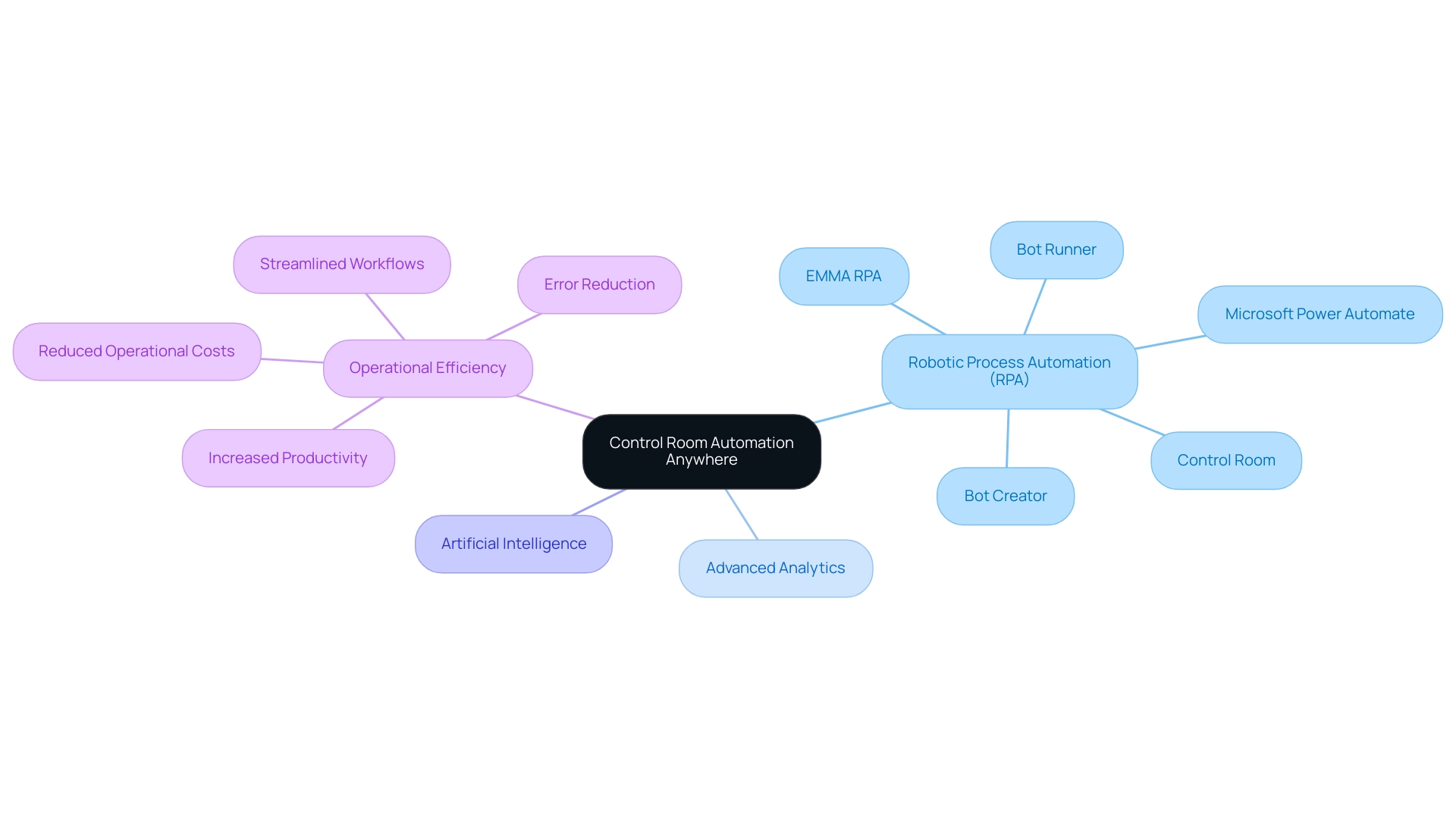
Benefits and Applications of Control Room Automation Anywhere
The benefits of Control Room Automation Anywhere are vast and significant, especially in improving operational efficiency through systemization. By automating routine tasks such as data entry, report generation, and task monitoring, teams can redirect their efforts toward more strategic initiatives.
For example, a mid-sized healthcare firm that adopted GUI mechanization encountered difficulties such as manual data entry mistakes and sluggish software testing, but experienced a 70% decrease in data entry errors and a 50% increase in testing efficiency, greatly improving patient care.
Additionally, companies that adopted automation in their control rooms experienced a 30% reduction in operational costs and a 25% increase in productivity. Mechanization not only boosts efficiency but also enhances accuracy and minimizes errors, as automated processes are inherently less susceptible to human oversight.
A crucial aspect of Control Room Anywhere is its ability for real-time monitoring and analytics, offering entities with actionable insights that enable informed decision-making. These examples highlight the technology’s versatility and effectiveness, making it a compelling option for entities aiming to enhance their operational capabilities.
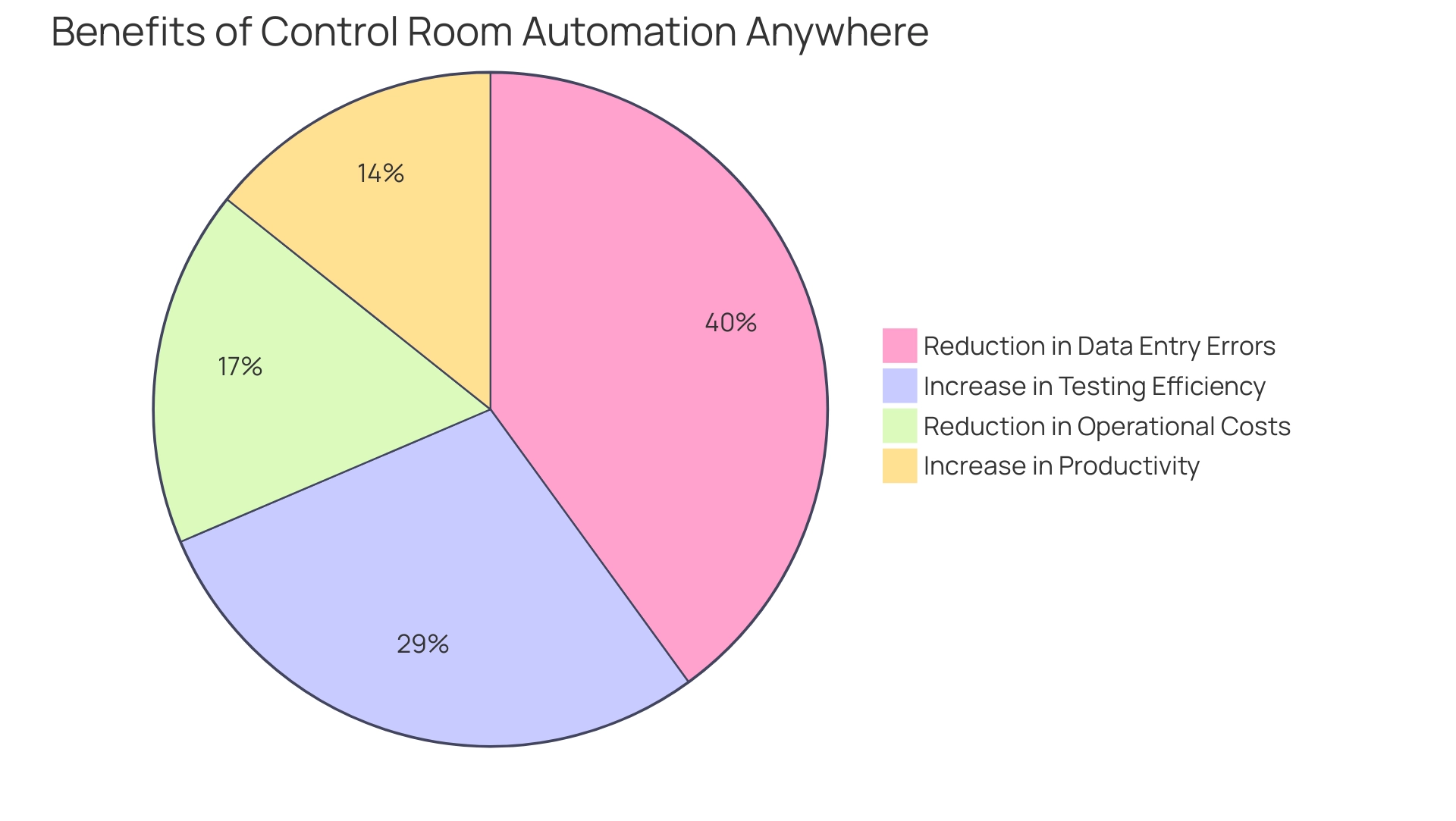
Challenges and Considerations in Implementing Control Room Automation Anywhere
Implementing Control Room Automation Anywhere can yield significant advantages; however, companies often encounter various challenges in the process. A crucial obstacle is employee opposition to change, with studies suggesting that up to 70% of employees may resist new technological advancements due to a lack of understanding about their benefits. This resistance is often compounded by integration issues with existing systems, making a thoughtful approach essential for ensuring compatibility.
For instance, case studies show that organizations like Company X encountered significant resistance from employees when implementing automated processes, resulting in delays and higher expenses. Furthermore, repetitive tasks can significantly impact employee morale and productivity, exacerbating resistance to change.
To combat these issues, fostering a culture of open communication and collaboration is vital. This environment enables employees to express their concerns and gain insights into the transformative potential of technology. Expert opinions indicate that engaging employees early in the automation initiative can significantly lessen resistance.
Moreover, investing in comprehensive training programs, such as our GenAI workshops, equips teams with the necessary skills to effectively implement and manage AI solutions, enhancing acceptance and productivity. Furthermore, entities are increasingly encountering staffing shortages, making it essential to utilize RPA solutions to lessen dependence on manual tasks and draw talent by providing more engaging work.
By proactively tackling these challenges and utilizing RPA solutions to combat repetitive tasks and staffing shortages, companies can not only implement Control Room Management Anywhere effectively but also unlock its full potential to streamline operations, drive efficiency, and ensure sustainable growth.
Significantly, our risk-free automation services concentrate on providing measurable ROI, guaranteeing entities that they only pay if the process is automated as intended.

Future Trends in Control Room Automation Anywhere
The future of Control Room Automation Anywhere is set to experience remarkable advancements, driven by the rapid evolution of artificial intelligence. Enhanced capabilities in predictive analytics, machine learning, and natural language processing will significantly improve entities’ ability to automate complex tasks and make informed, data-driven decisions with precision.
For instance, a recent study found that entities implementing AI in control room operations have seen a 30% increase in operational efficiency. Furthermore, the integration of Internet of Things (IoT) devices is poised to revolutionize data collection and monitoring, facilitating real-time insights that enhance operational efficiency.
However, many entities remain hesitant to adopt AI due to concerns over poor master data quality and the perceived complexities and costs associated with implementation. As observed by industry expert Humphreys, the impact of these technologies frequently interrupts current production and management practices, highlighting the urgency for entities to adapt.
To alleviate these concerns, custom Small Language Models (SLMs) offer powerful, cost-effective capabilities tailored to specific industry needs, ensuring enhanced privacy and efficient data analysis. SLMs can help improve master data quality by streamlining data processing and providing accurate insights, which mitigates the fear of integration challenges.
Additionally, a case study on a leading energy company demonstrated that the adoption of AI-driven control room automation led to a 25% reduction in response times to operational incidents. Embracing these innovations, including leveraging Robotic Process Automation (RPA) to automate manual workflows, is not just advantageous; it is essential for organizations seeking to thrive in an increasingly competitive landscape.
RPA can significantly decrease the time and expenses linked to manual tasks, addressing the common perception that AI initiatives are time-intensive and expensive. Those that remain agile and proactive in adopting these cutting-edge technologies will be well-positioned to lead the way in the future of control room operations, especially as we look toward the trends shaping 2024 and beyond.
Expert predictions suggest that by 2024, AI will play a critical role in enhancing decision-making processes, with 70% of control rooms expected to integrate advanced AI solutions, highlighting the urgency of overcoming these implementation challenges.
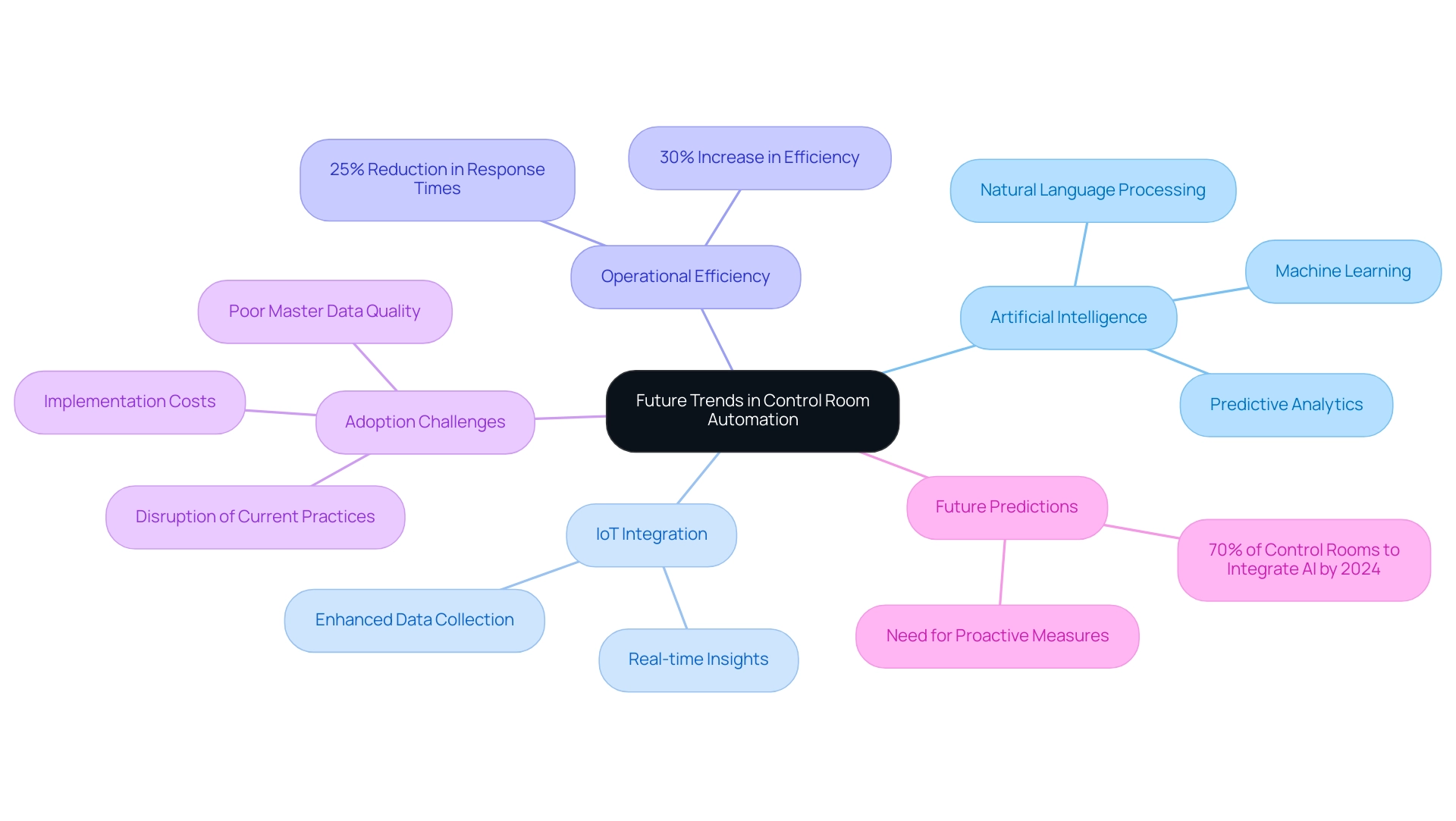
Conclusion
The integration of Control Room Automation Anywhere offers a transformative approach to enhancing operational efficiency, enabling organizations to streamline workflows and reduce manual errors through advanced technologies such as robotic process automation and artificial intelligence. By automating routine tasks, teams can focus on strategic initiatives that drive growth and innovation. Real-world applications have demonstrated significant benefits, including reduced processing times and operational costs, underscoring the effectiveness of this automation solution.
However, the path to successful implementation is not without its challenges. Employee resistance and integration hurdles are common obstacles that can hinder progress. By fostering a culture of collaboration, investing in comprehensive training, and involving employees early in the automation process, organizations can address these challenges head-on.
Emphasizing open communication and showcasing the tangible benefits of automation can help to alleviate concerns and encourage acceptance among staff.
Looking ahead, the future of Control Room Automation Anywhere is promising, with advancements in artificial intelligence and the Internet of Things poised to revolutionize operations further. Organizations that embrace these innovations will not only improve efficiency but also position themselves competitively in an evolving landscape. As 2024 approaches, the imperative to adopt these technologies becomes increasingly clear, paving the way for a future where operational excellence and strategic growth coexist harmoniously.
Introduction
In the fast-evolving landscape of operational software, the transition from version 11.3.4 to 11.3.5 marks a significant leap forward for organizations seeking to enhance their efficiency and productivity. This latest version not only introduces groundbreaking features such as intelligent automation and advanced analytics but also prioritizes security and user experience. By embracing these innovations, businesses can streamline workflows, reduce manual errors, and empower their teams to focus on strategic initiatives.
The integration of tools like EMMA RPA and Microsoft Power Automate further supports organizations in overcoming common challenges, ultimately paving the way for improved performance and measurable success. As companies navigate this transformative journey, understanding the key enhancements of version 11.3.5 will be essential for unlocking their full potential.
Comparative Overview: Version 11.3.4 vs 11.3.5
In the transition from version 11.3.4 to 11.3.5, several key differences emerge that are critical for users to note. Version 11.3.5 not only introduces enhanced performance metrics that enable organizations to monitor operational efficiency more effectively, but it also incorporates innovative tools like EMMA RPA and Microsoft Power Automate.
- EMMA RPA includes intelligent automation features that simplify repetitive tasks,
- Power Automate links various applications and information sources to automate workflows effortlessly.
These RPA solutions significantly enhance employee morale by addressing challenges like outdated systems and staffing shortages. Additionally, significant security improvements have been put in place to protect sensitive information, ensuring compliance and safeguarding details in today’s information-driven environment.
The interface has also been streamlined for better navigation, making it easier for teams to adapt and utilize the software effectively. Together, these modifications lead to a more resilient and user-friendly experience, enabling organizations to enhance their processes further and attain measurable results, as shown by our case study on GUI automation in a mid-sized firm, which decreased entry mistakes by 70% and improved workflow productivity by 80%.

Key Features and Enhancements in Version 11.3.5
Version 11.3.5 introduces several significant features that enhance experience and operational efficiency. Notably, the integration of advanced analytics tools, part of our Power BI services, allows users to gain deeper insights from their information, facilitating informed decision-making that drives growth and innovation.
Furthermore, the new automation capabilities, powered by EMMA RPA and Microsoft Power Automate, specifically address task repetition fatigue and staffing shortages by streamlining repetitive tasks and reducing the time spent on manual inputs, thereby enhancing overall productivity.
Additionally, the 3-Day Power BI Sprint enables rapid creation of professionally designed reports, further supporting efficient reporting and information consistency. The enhanced collaboration tools foster better communication among team members, ensuring that everyone stays aligned with organizational goals.
These features not only improve productivity but also empower teams to concentrate on strategic initiatives, ultimately driving business success in a rapidly evolving AI landscape.
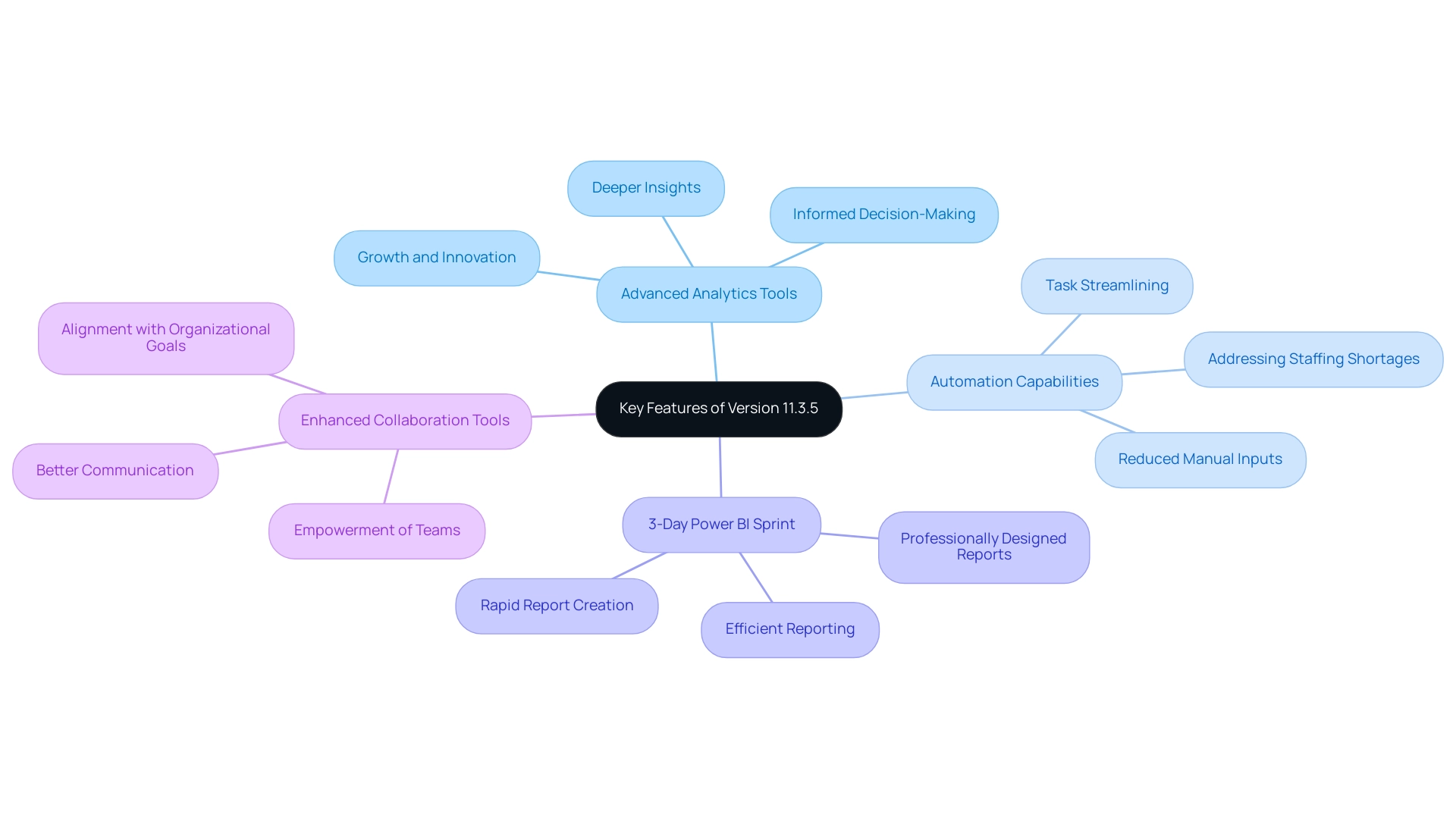
Improved Security Protocols in Version 11.3.5
In the evolving landscape of operational effectiveness, Version 11.3.5 has implemented several improved security protocols that align with the need for enhanced productivity and data-driven decision-making. These enhancements, including advanced encryption methods for information at rest and in transit, ensure that organizational information remains confidential and secure. Coupled with tailored AI solutions that help businesses navigate the complexities of the modern market, organizations can leverage targeted technologies to meet their specific needs.
Additionally, Robotic Process Automation (RPA) solutions streamline workflows, reduce manual errors, and enhance operational efficiency. For instance, RPA can automate repetitive tasks, allowing employees to focus on higher-value activities. The introduction of multi-factor authentication adds an extra layer of protection against unauthorized access, allowing businesses to operate with greater confidence.
By safeguarding sensitive information, these security measures not only protect the organization but also enhance productivity by minimizing the risk of breaches and associated downtime, ultimately driving growth and innovation. Furthermore, unlocking the power of Business Intelligence transforms raw data into actionable insights, enabling informed decision-making that supports strategic objectives.
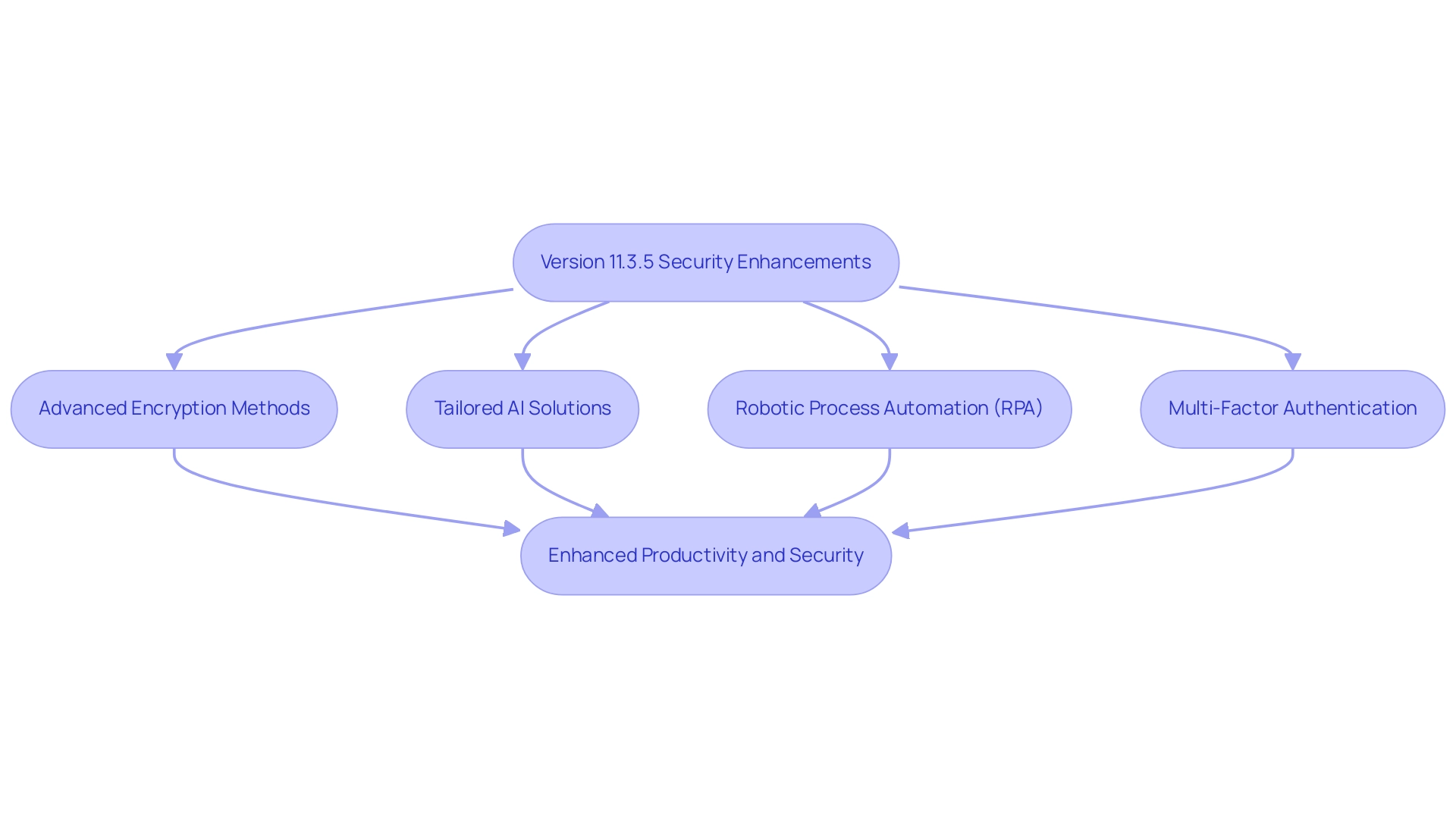
User Experience Enhancements in Version 11.3.5
In version 11.3.5, we have introduced significant experience enhancements designed to elevate overall usability and productivity while also contributing to lower operational costs. The interface now includes a redesigned layout for intuitive navigation, allowing individuals to access essential tools and features more efficiently. Furthermore, customizable dashboards empower individuals to tailor their views according to specific needs, streamlining their workflow and facilitating better decision-making.
These enhancements not only decrease the learning curve for newcomers but also encourage a more productive environment, allowing teams to concentrate on strategic tasks without unnecessary distractions. By prioritizing user experience, organizations can leverage the key benefits of our General Management App, including:
- Comprehensive management capabilities
- Microsoft Copilot integration
- Seamless information integration
- Advanced analytics
- Expert training and support
This ensures that their teams are equipped to work effectively and collaboratively.
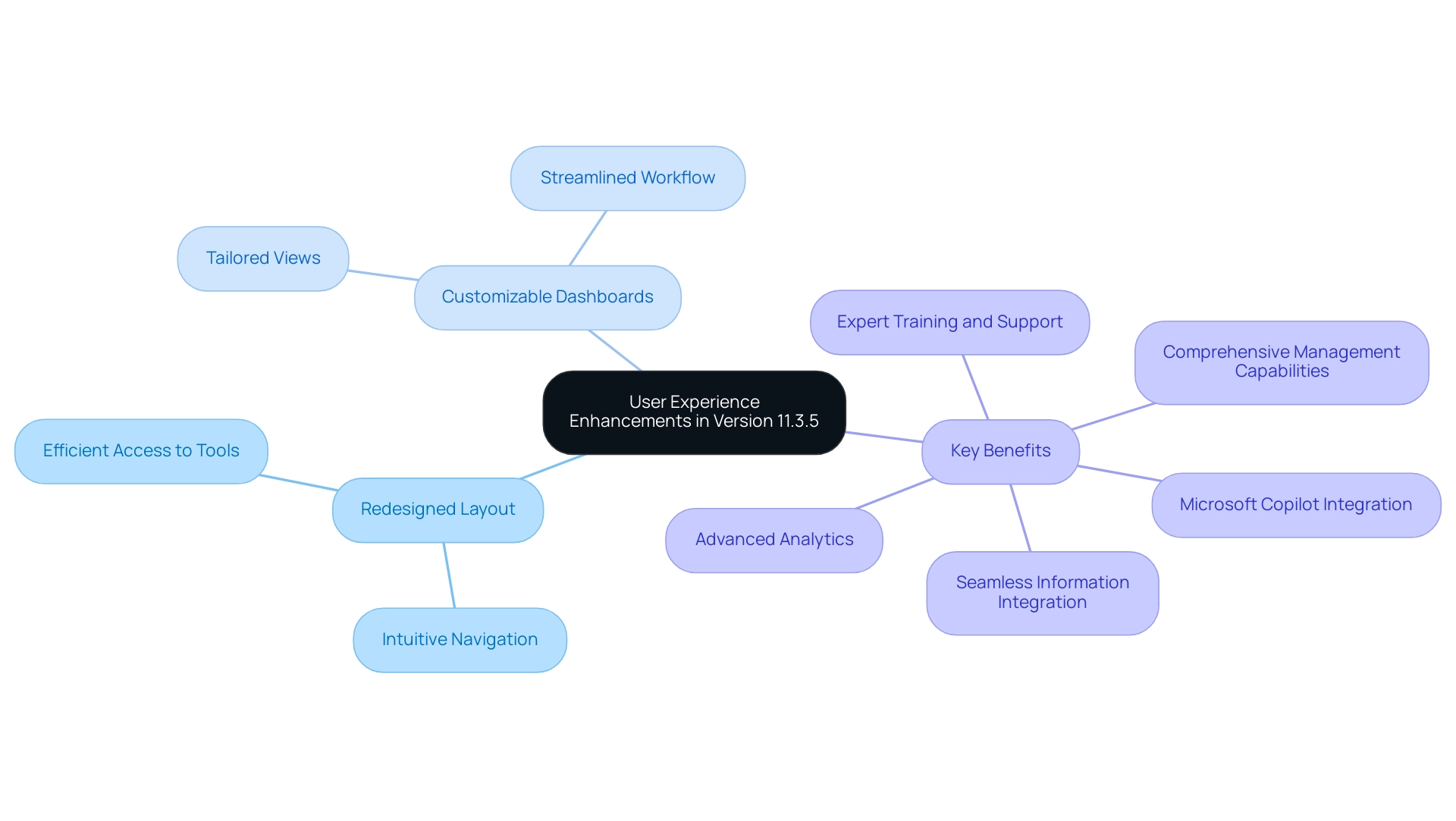
Integration Capabilities with Other Tools
One of the standout features of version 11.3.5 is its enhanced integration capabilities with various tools and platforms, such as EMMA RPA and Microsoft Power Automate. This version allows for seamless connections with popular business applications, including CRM and project management tools, enabling a more cohesive workflow.
By integrating these systems, organizations can:
- Automate transfers
- Streamline processes
- Significantly reduce manual entry and the potential for mistakes
For example, case studies have demonstrated that applying these integrations can result in:
- A 70% decrease in data entry mistakes
- An 80% enhancement in workflow productivity
This integration not only enhances operational efficiency but also addresses challenges like:
- Task repetition fatigue
- Staffing shortages
Providing a holistic view of organizational performance. Embracing these integration capabilities can drive productivity improvements and foster employee morale through innovative RPA solutions, as evidenced by successful applications in sectors like healthcare.
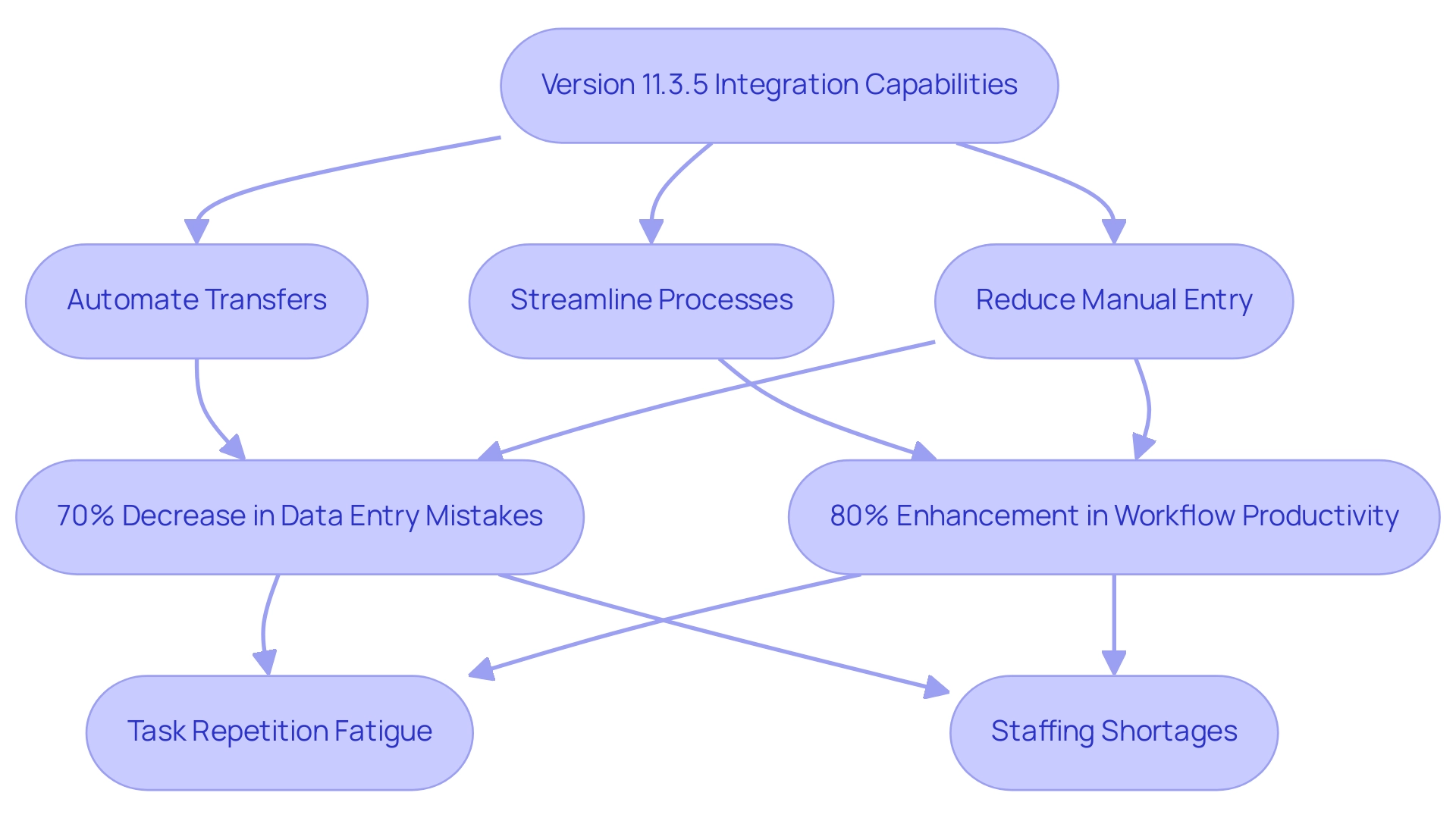
Conclusion
The transition to version 11.3.5 offers organizations a wealth of enhancements designed to elevate operational efficiency and user experience. Key features such as intelligent automation through EMMA RPA and seamless integration with Microsoft Power Automate not only streamline repetitive tasks but also empower teams to focus on strategic initiatives. This shift is complemented by advanced analytics tools that provide deeper insights, enabling informed decision-making that drives growth and innovation.
Security measures in version 11.3.5 are also crucial, as they protect sensitive data through improved protocols and encryption methods. These enhancements ensure compliance while minimizing risks associated with data breaches, thus fostering a safer working environment. Coupled with a redesigned user interface that promotes intuitive navigation and customizable dashboards, the software encourages productivity and reduces the learning curve for users.
Ultimately, embracing the innovations and improvements of version 11.3.5 positions organizations to overcome common operational challenges. By leveraging these capabilities, companies can achieve measurable outcomes, enhance employee morale, and drive overall success in a rapidly evolving business landscape. Now is the time to harness the full potential of this powerful software to transform workflows and elevate organizational performance.
Introduction
In the dynamic landscape of modern business, the integration of Customer Relationship Management (CRM) systems and Robotic Process Automation (RPA) is revolutionizing how organizations operate. By harnessing the power of these technologies, businesses can streamline their processes, enhance customer interactions, and drive efficiency to new heights. As companies grapple with the demands of a fast-paced environment, understanding the synergy between CRM and RPA becomes crucial for unlocking operational success.
This article delves into the transformative benefits of this integration, showcasing practical applications across various industries while addressing the challenges organizations face in implementation. With insights into future trends and real-world case studies, readers will discover actionable strategies for leveraging these technologies to propel their businesses forward.
Understanding CRM and RPA: A Comprehensive Overview
Client Relationship Management (CRM) systems act as the backbone for managing interactions with both current and prospective clients. By organizing client information and tracking interactions, these systems enable businesses to streamline processes, enhance service, and ultimately boost profitability. Recent advancements in CRM technology, such as AI-driven analytics and improved user interfaces, have further empowered organizations to customize their interactions with clients more effectively. Conversely, Robotic Process Automation (RPA) employs software robots to automate repetitive tasks traditionally performed by humans, such as information entry and transaction processing. Our innovative RPA solutions, including EMMA RPA and Microsoft Power Automate, are designed to not only enhance operational efficiency but also improve employee morale through user-friendly digitalization.
The synergy between CRM and RPA is transformative. By incorporating these technologies, organizations can automate workflows that involve client information, ensuring seamless information flow between systems. For example, when a client submits an online form, RPA can promptly input that information into the CRM, significantly reducing manual entry mistakes and freeing staff to concentrate on higher-value strategic initiatives. This integration not only improves operational efficiency but also enriches the overall client experience by ensuring that information is accurate and accessible when required.
In 2024, the latest advancements emphasize that the merging of CRM and RPA is becoming progressively sophisticated, with new tools emerging that provide predictive analytics and real-time information processing capabilities. Furthermore, the significance of Business Intelligence in this context cannot be overstated; it propels the extraction of actionable insights from the information handled by CRM systems. Case studies, including those from prominent call centers, illustrate how the combination of CRM and RPA, backed by Business Intelligence, has maximized efficiency and service quality, resulting in enhanced satisfaction rates. These advancements illustrate a clear path toward optimizing workforce performance and achieving operational success, empowering organizations to leverage tailored AI solutions for informed decision-making and sustained growth. Moreover, it is essential to recognize the challenges companies encounter in adopting these technologies, such as integration complexities and quality issues, which can obstruct their capacity to fully achieve the advantages of RPA and AI.
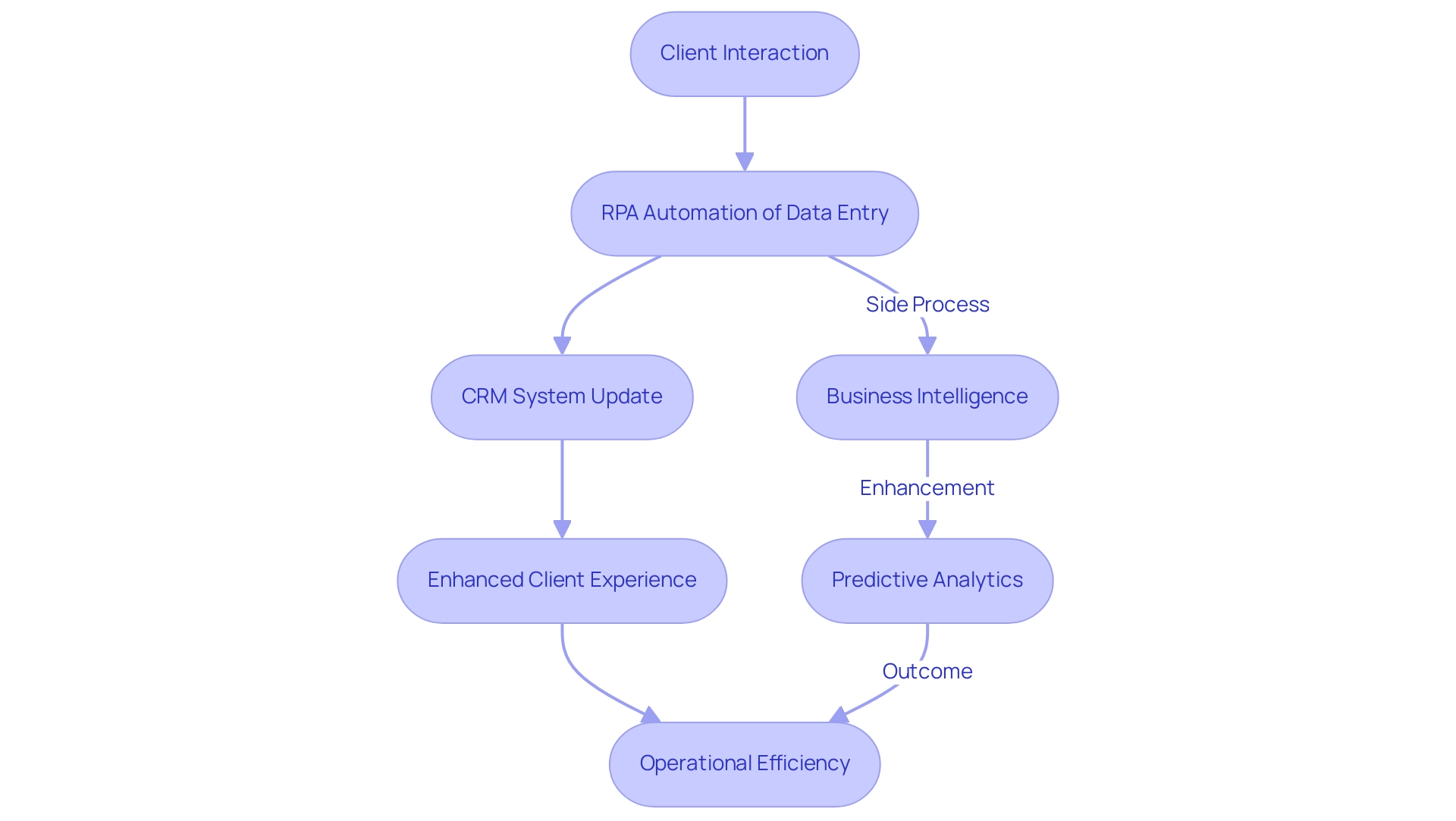
Key Benefits of CRM and RPA Integration for Businesses
The integration of Customer Relationship Management (CRM) systems with Robotic Process Automation (RPA) presents a multitude of advantages for businesses aiming to enhance their operational efficiency:
- Enhanced Productivity: By automating routine tasks such as information input and lead management, employees can redirect their efforts toward high-impact activities like client engagement and strategic planning. A recent case study involving a mid-sized healthcare company demonstrated a remarkable 30% reduction in processing time for client inquiries after implementing RPA alongside their CRM system, showcasing how GUI automation can revolutionize operational workflows.
- Enhanced Precision: RPA greatly minimizes human mistakes in information management by ensuring that client details are consistently and precisely entered into CRM systems. This level of precision is crucial, especially as 40% of employees in Singapore express dissatisfaction with their work experience, underscoring the need for reliable systems. Businesses that utilized RPA in their CRM processes reported a 25% decrease in entry errors, enhancing overall accuracy.
- Enhanced Client Experience: Rapid processing times and accurate data management enable businesses to respond to inquiries swiftly, leading to higher satisfaction rates. For instance, after integrating RPA with CRM systems, one company reported a 20% increase in satisfaction scores, illustrating how automation can transform the journey into a more responsive and personalized experience.
- Scalability: As organizations expand, RPA provides a flexible solution to manage increased workloads without necessitating a linear increase in staff. This cost-effective method enables businesses to uphold quality relationships with clients while scaling operations. For instance, another client was able to double its client base without increasing its operational costs, thanks to RPA.
- Improved Information Insights: Integrated systems enable businesses to leverage analytics effectively, gaining understanding of consumer behaviors and preferences. This informed decision-making is essential for tailoring services and enhancing overall client satisfaction. A study discovered that companies that combined RPA with their CRM systems reported a 15% enhancement in information-driven decision-making capabilities.
Before deploying RPA, the mid-sized healthcare firm encountered challenges such as manual information entry errors and slow response times, which obstructed operational efficiency. In light of these benefits, industry leaders recognize the critical role of automation in shaping future business practices. As Jeff Bezos eloquently stated,
I predict that, because of artificial intelligence and its ability to automate certain tasks that in the past were impossible to automate, not only will we have a much wealthier civilization, but the quality of work will go up very significantly.
This vision encapsulates the transformative impact of RPA and CRM integration, making it an essential strategy for businesses looking to thrive in 2024 and beyond. Notably, the ROI from these implementations was achieved within six months, further underscoring the effectiveness of the solution.
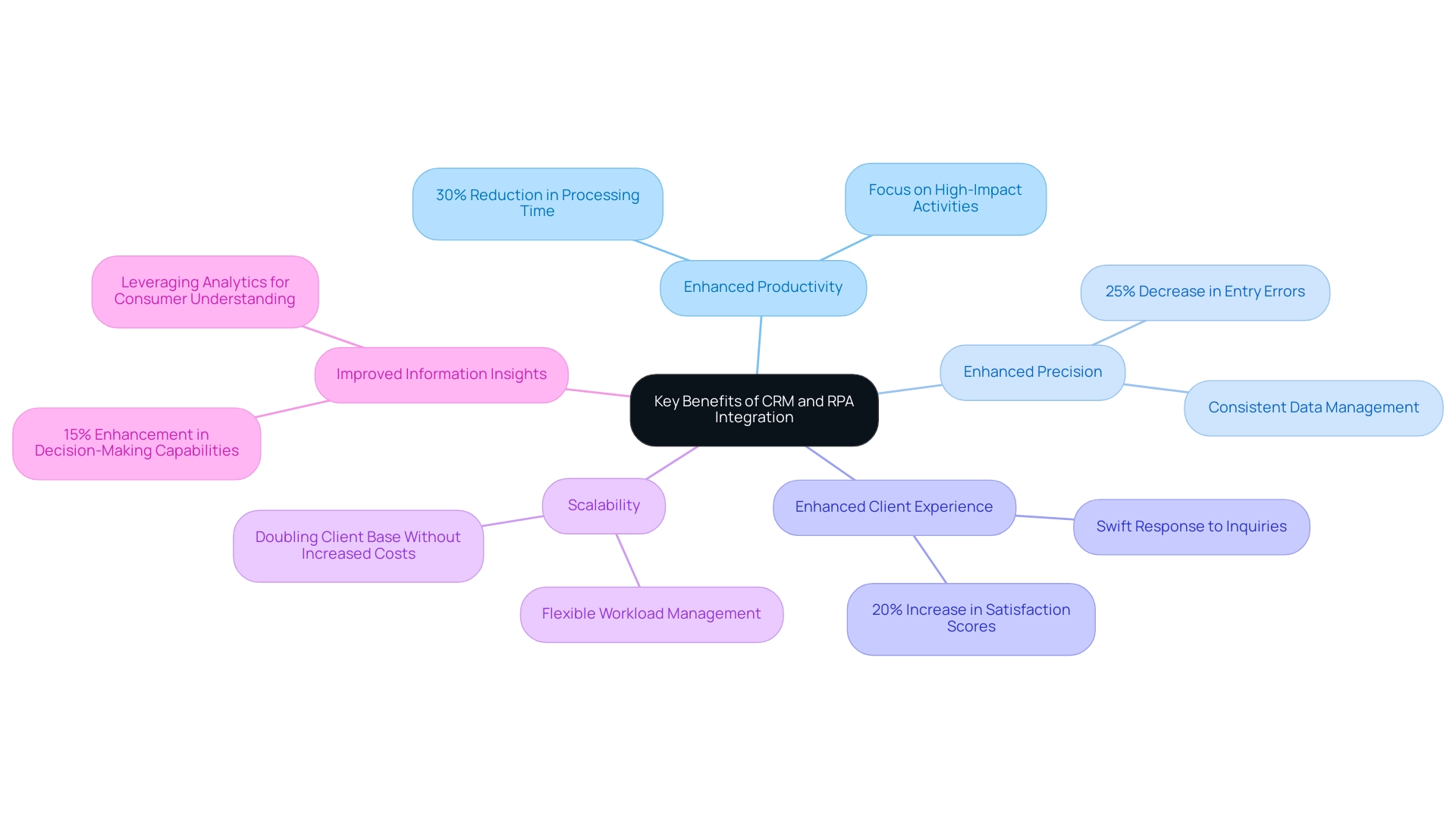
Common Use Cases for CRM and RPA Integration
Numerous industries are harnessing the power of CRM and RPA integration to elevate their operational efficiency and effectiveness. Starting at just $500 per month, RPA solutions are a cost-effective option for businesses aiming to streamline their processes. Here are several impactful use cases that highlight how RPA addresses workplace challenges and enhances productivity:
-
Sales Automation: RPA empowers sales teams to automate lead qualification processes by analyzing incoming leads and updating CRM records in real time. This ensures that sales representatives can focus on high-potential opportunities, ultimately increasing conversion rates.
-
Customer Support: By implementing RPA, organizations can automate ticket creation and follow-up tasks in CRM systems. As Maya Angelou famously said, “I’ve learned that people will forget what you said, people will forget what you did, but people will never forget how you made them feel.” This automation improves the speed and quality of support, allowing teams to respond to inquiries with greater efficiency and precision.
-
Marketing Campaign Management: RPA enables the automation of information gathering from different sources, allowing marketers to design targeted campaigns based on thorough client insights stored in their CRMs. A pertinent case study on marketing automation illustrates how RPA can significantly enhance marketing efforts by automating information collection for market analysis and managing social media content publishing, resulting in more effective strategies and improved audience engagement.
-
Order Processing: RPA streamlines the order entry process by automatically updating CRM systems with order details. This not only reduces processing time but also minimizes the risk of errors, ensuring smoother order fulfillment.
-
Reporting and Analytics: Integrating RPA with CRM systems allows businesses to automate the creation of reports and dashboards. This integration offers stakeholders with real-time insights into sales performance and client engagement metrics, enabling informed, data-driven decision-making.
In addition to these applications, RPA can help alleviate staffing shortages by automating routine tasks that would otherwise require additional personnel, allowing organizations to allocate their human resources more effectively. Furthermore, addressing the repetitive nature of certain tasks can significantly improve employee morale, as team members can focus on more engaging and strategic work.
As organizations adopt these technologies, it is crucial to address information security and compliance concerns, particularly since RPA solutions frequently manage sensitive information. Ensuring compliance with global information processing standards and implementing robust security measures will safeguard both the organization and its customers.
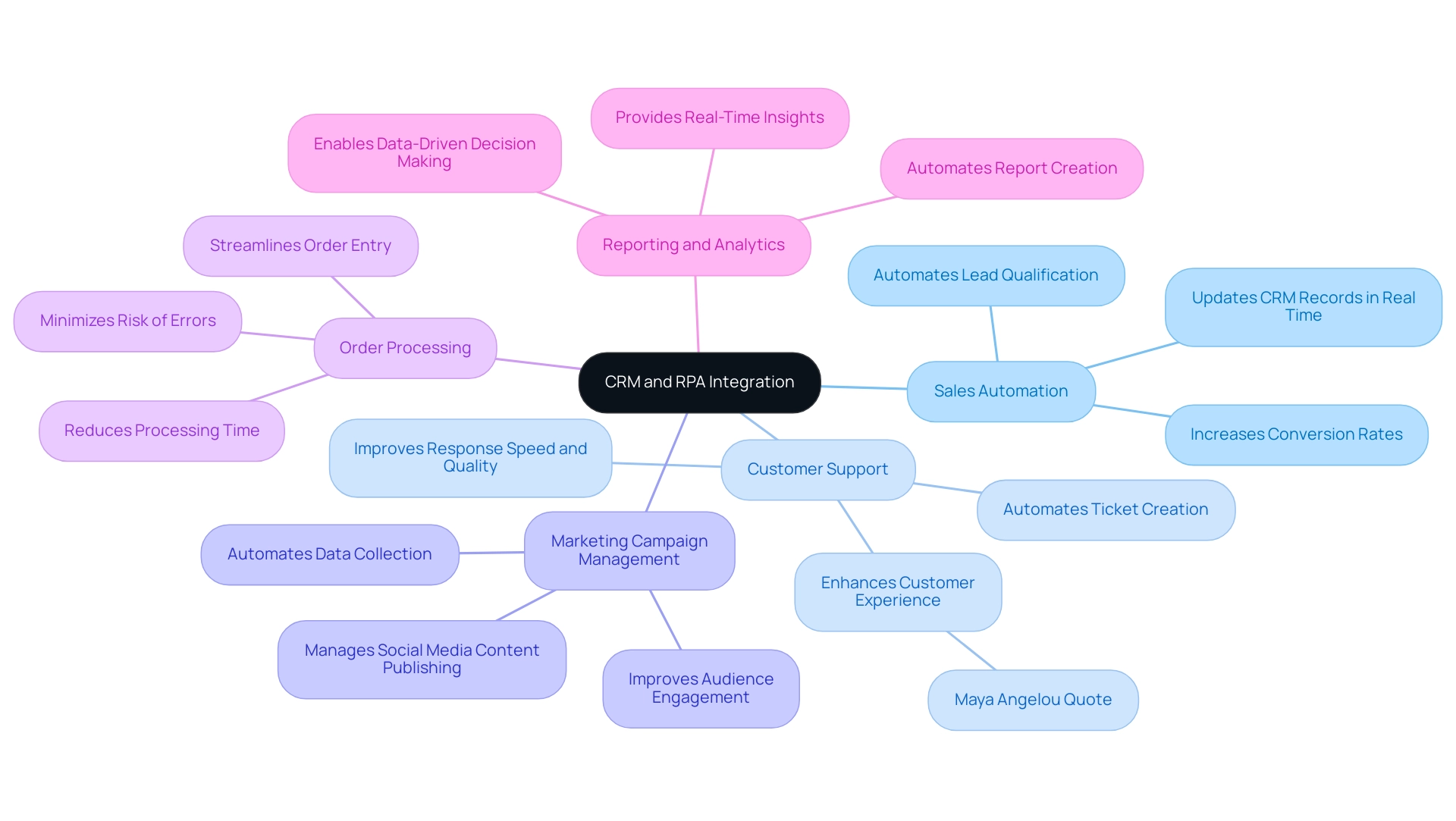
Challenges in Implementing CRM and RPA Integration
Integrating CRM and RPA technologies offers significant advantages, yet organizations often encounter a range of challenges:
-
Resistance to Change: A common hurdle is the reluctance among employees to embrace new technologies. Studies indicate that over 60% of employees fear job displacement due to automation. To mitigate this resistance, it’s crucial for organizations to cultivate a culture of collaboration and continuous learning, supported by visible leadership commitment. As Kamin C. insightfully states,
By showing them how automation can take over mundane, repetitive tasks, they’ll see how it frees up their time for more engaging and creative work.
Additionally, organizations can alleviate fears by hiring from within and reskilling employees, creating new job opportunities and demonstrating a commitment to workforce development. -
Information Quality Issues: The effectiveness of RPA is heavily reliant on the quality of information within CRM systems. Organizations must prioritize the cleanliness, accuracy, and timeliness of their information before deploying RPA solutions to ensure that they can unlock the full potential of Business Intelligence in driving informed decision-making.
-
Integration Complexity: The task of integrating RPA with existing CRM systems can be intricate, necessitating meticulous planning and execution. Investing in robust training and resource allocation is essential to ensure a smooth integration process, which is vital for leveraging tailored AI solutions that align with specific business goals.
-
Cost Considerations: While RPA can yield substantial long-term savings, the upfront costs associated with technology acquisition and employee training can be considerable. Organizations need to carefully assess these costs against anticipated benefits to justify their investment, particularly in an evolving AI landscape.
-
Ongoing Maintenance: Post-implementation, RPA systems demand consistent monitoring and maintenance to maintain optimal performance. Companies should be prepared to allocate adequate resources for ongoing support, ensuring the sustainability of their RPA initiatives. Furthermore, it’s important to recognize that while many employees perceive intelligent automation as a threat to their jobs, RPA and AI are designed to free them from repetitive tasks, potentially creating new job opportunities and enhancing overall business productivity. RPA not only streamlines workflows and reduces errors but also works in tandem with Business Intelligence to provide actionable insights, empowering organizations to make informed decisions that drive growth and innovation.
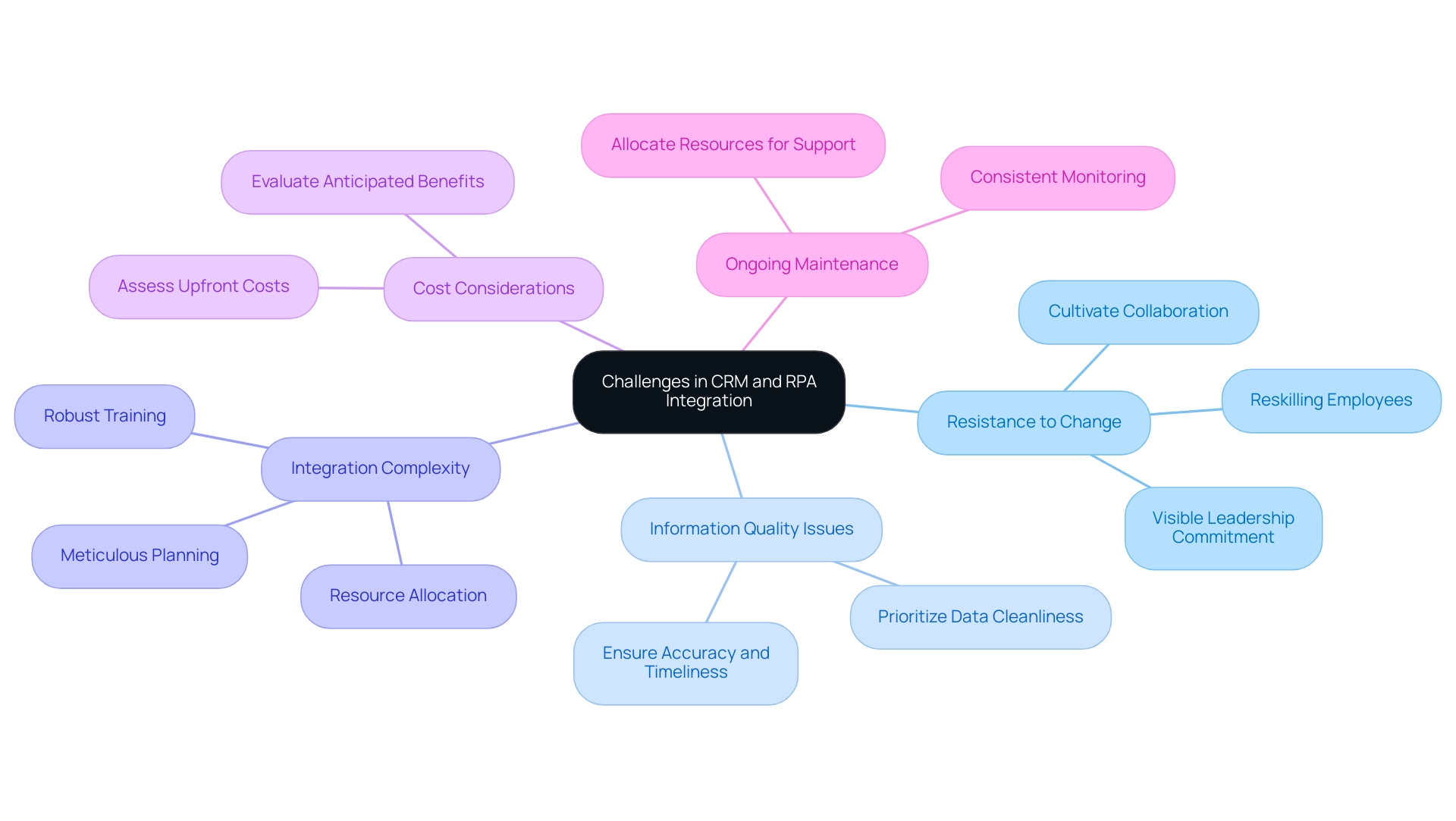
Future Trends in CRM and RPA Integration
As technology continues to evolve, several pivotal trends are emerging in the integration of CRM and RPA technologies:
-
AI-Powered Automation: The synergy of artificial intelligence with robotic process automation (RPA) is set to transform how organizations operate. This integration will facilitate intelligent decision-making and improve predictive analytics within CRM systems, allowing businesses to customize their services to meet client needs more effectively. By leveraging tailored AI solutions, companies can navigate the complexities of the evolving AI landscape, ensuring alignment with their specific business goals.
-
Increased Customization: Organizations are increasingly seeking RPA solutions that can be tailored to their specific CRM workflows. This trend towards customization fosters greater flexibility and adaptability in automation processes, enabling businesses to respond swiftly to changing demands and enhance operational efficiency.
-
Enhanced Information Security: With rising concerns over privacy, organizations are prioritizing secure integration practices. This focus on data protection ensures that client information remains safeguarded while leveraging the efficiencies offered by RPA technologies, ultimately supporting informed decision-making.
-
Omnichannel Client Engagement: RPA will become instrumental in managing interactions across a multitude of channels. By ensuring a seamless experience, businesses can foster stronger relationships with their clients, regardless of how they choose to engage, driving overall productivity.
-
Integration with IoT: The convergence of Internet of Things (IoT) technologies with CRM systems is poised to revolutionize data collection and analysis. The IoT market, valued at $384.70 billion in 2021, is projected to grow to $2,465.26 billion by 2029, demonstrating a CAGR of 26.4%. This integration will enable real-time insights, allowing businesses to proactively address client needs and preferences, enhancing business intelligence capabilities.
-
Case Study – Voice-Activated Assistants: As highlighted in the case study titled ‘Transforming User Experience: The Rise of Voice and Conversational UI,’ voice-activated assistants are influencing CRM design, allowing for natural language interactions. This evolution improves user engagement and efficiency in CRM systems, demonstrating the practical application of these trends.
By remaining informed about these trends, organizations can fully utilize the potential of CRM and RPA integration, driving operational efficiency and enhancing client relationships. As noted by Hyken, > A smart company or brand will integrate an individual’s comments, conversations, purchases, and feedback on social media into its CRM <— a testament to the importance of these evolving technologies. This evolution of social CRM further underscores the need for businesses to adapt to these trends for improved decision-making and customer service.
Moreover, addressing the challenges posed by manual, repetitive tasks is crucial. These tasks can significantly hinder operational efficiency and lead to wasted resources. RPA can alleviate these issues by automating repetitive workflows, reducing errors, and freeing up teams for more strategic, value-adding work. In this rapidly evolving AI landscape, tailored solutions will be essential for organizations to maintain a competitive edge.
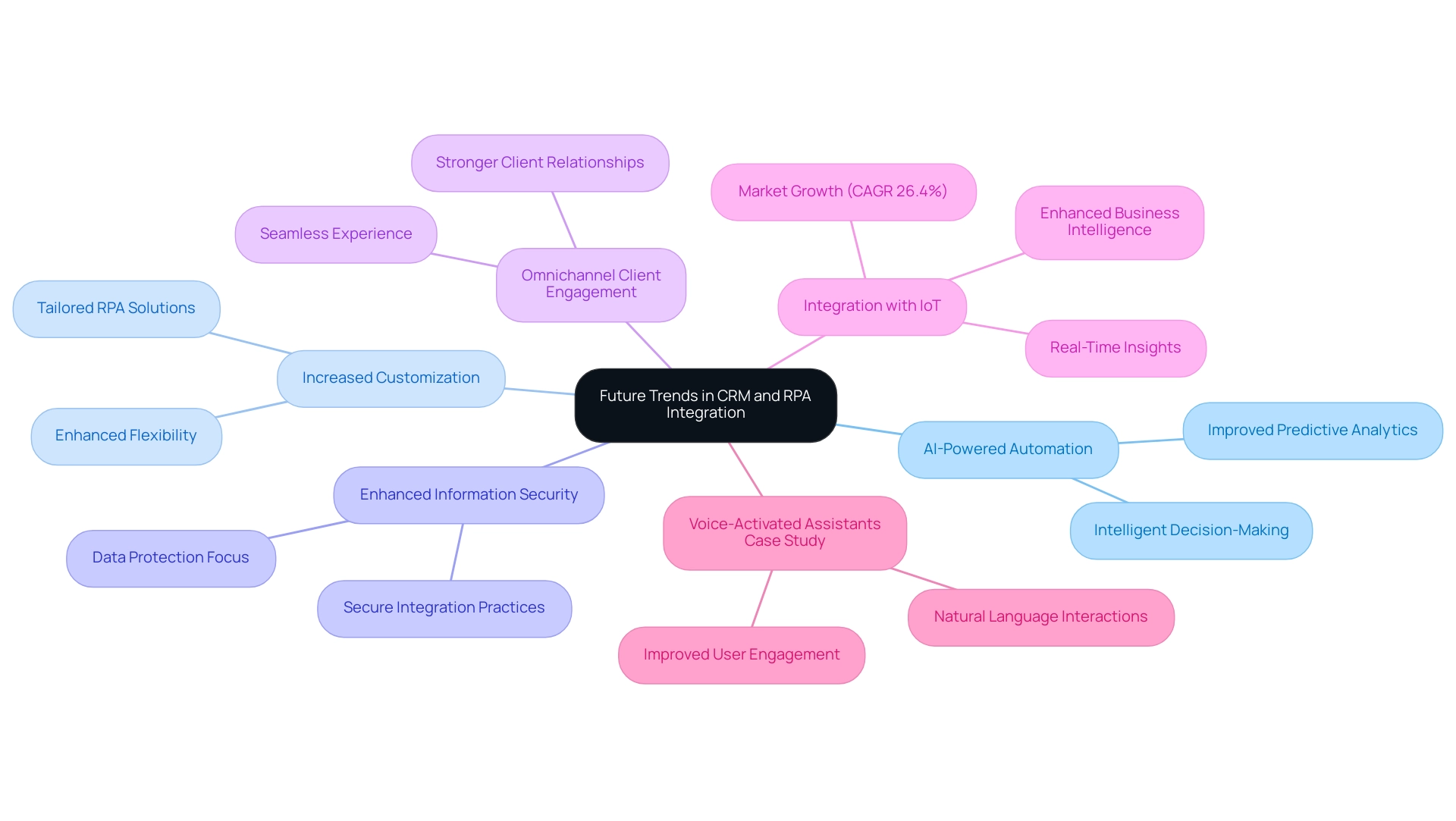
Conclusion
The integration of Customer Relationship Management (CRM) systems with Robotic Process Automation (RPA) presents a powerful opportunity for organizations to enhance their operational efficiency and improve customer experiences. By automating repetitive tasks, businesses can redirect their focus toward strategic initiatives that drive growth. Key benefits include increased efficiency, improved accuracy, enhanced customer satisfaction, scalability, and better data insights, all of which are crucial for thriving in today’s competitive landscape.
However, the journey to successful integration is not without its challenges. Organizations must navigate resistance to change, data quality issues, integration complexities, and cost considerations. By fostering a culture of collaboration and continuous learning, prioritizing data integrity, and investing in robust training, businesses can overcome these obstacles and fully realize the potential of CRM and RPA integration.
Looking ahead, trends such as AI-powered automation, increased customization, enhanced data security, and the integration of IoT will further shape the landscape of CRM and RPA. Organizations that stay attuned to these developments will be better positioned to leverage technology for informed decision-making and improved customer engagement. Embracing these innovations is essential for companies aiming to maintain a competitive edge and achieve sustained success in an ever-evolving business environment.
